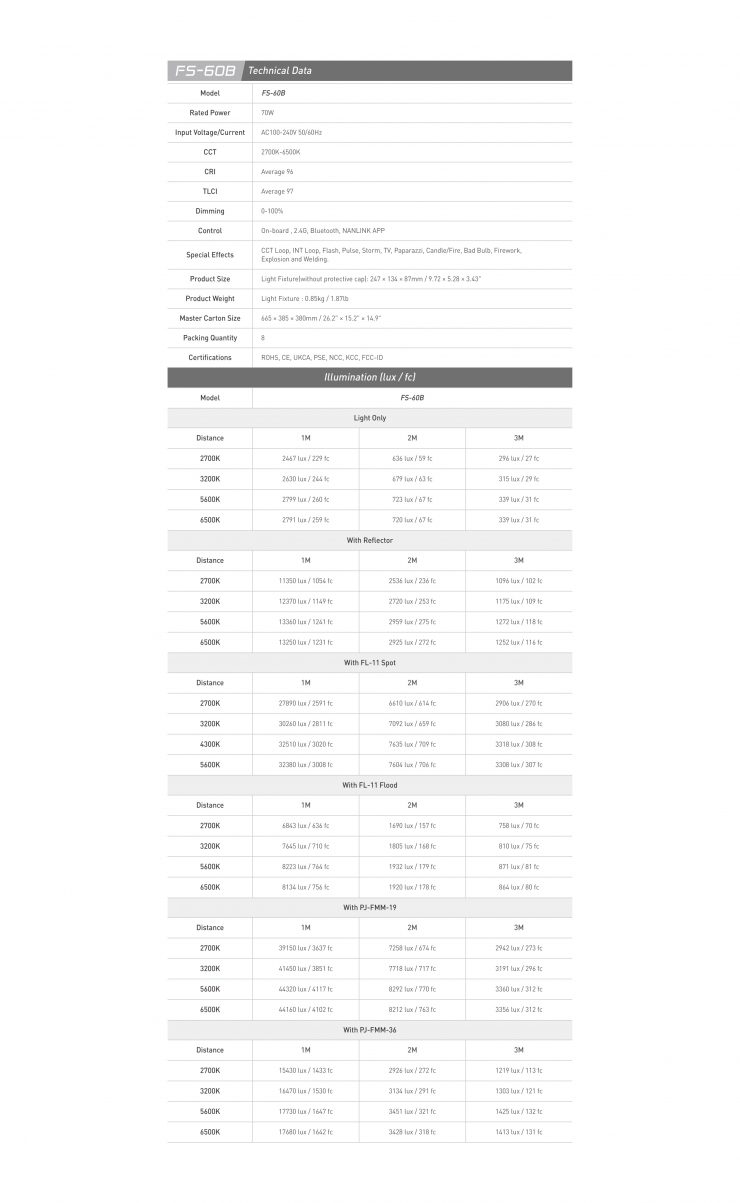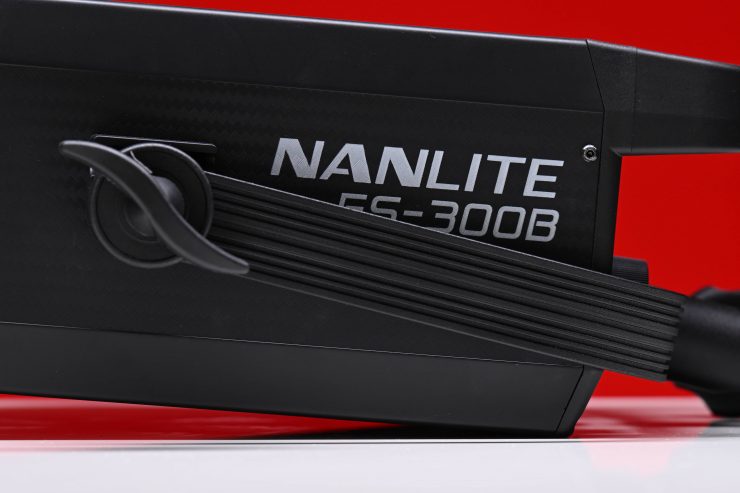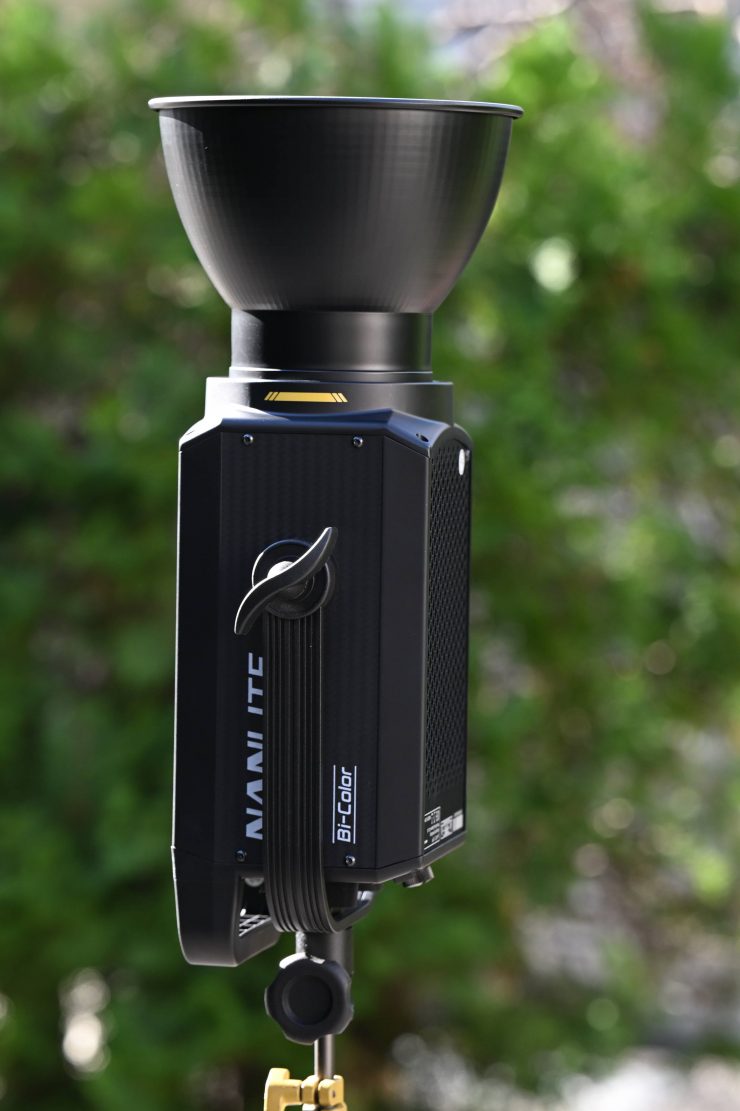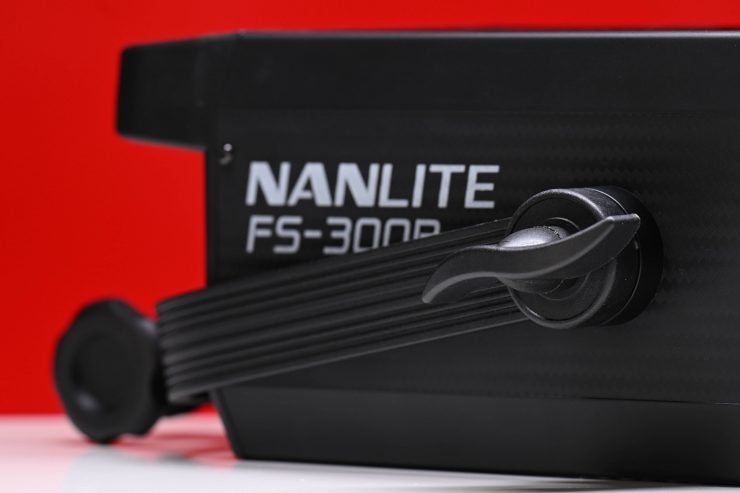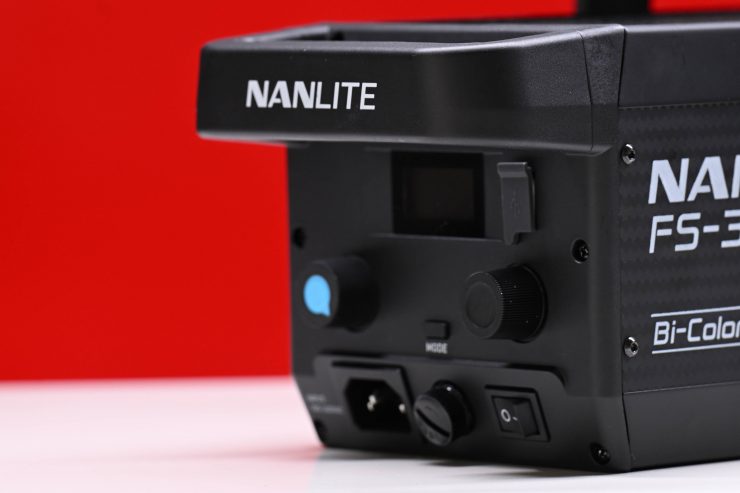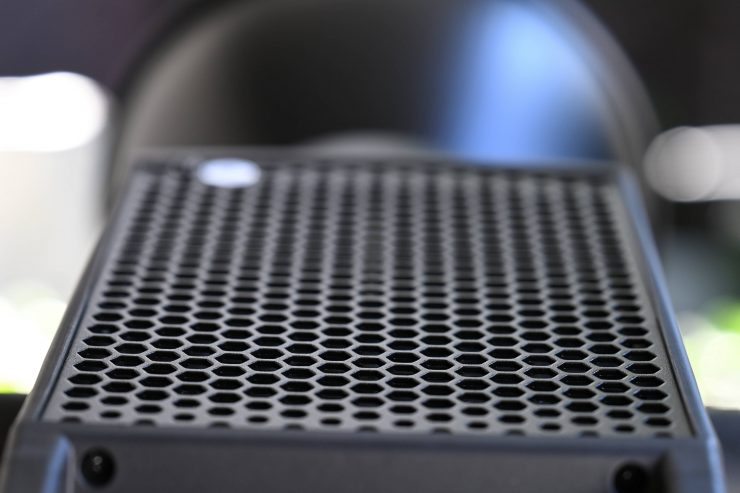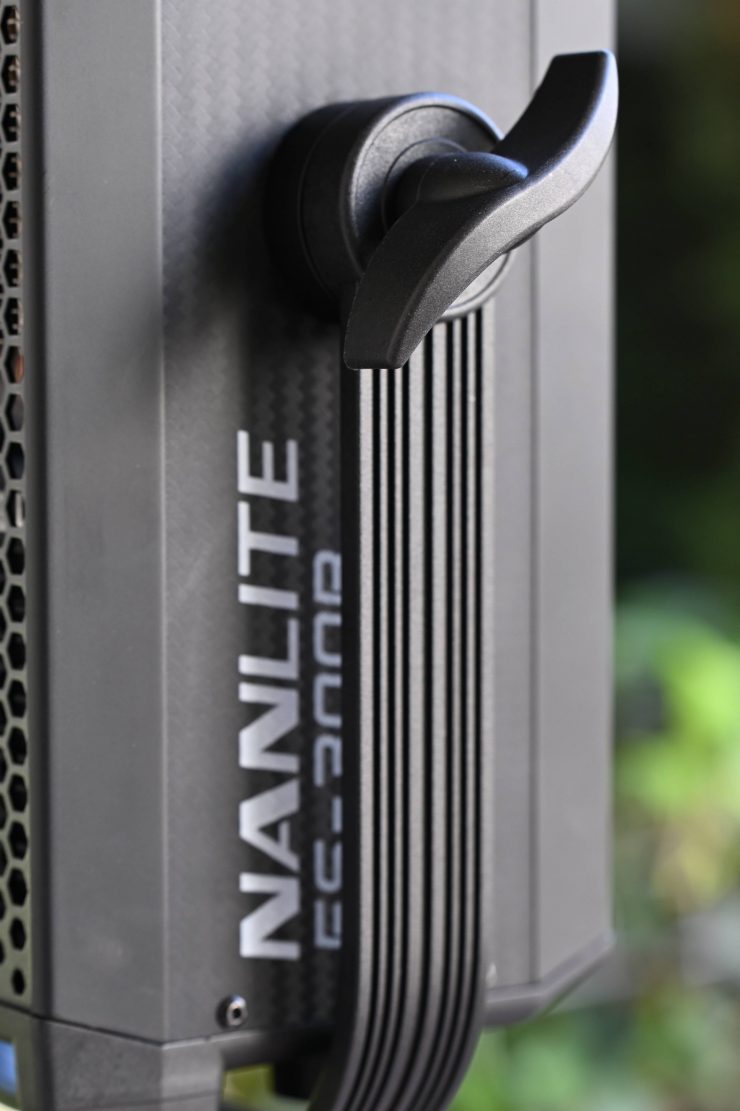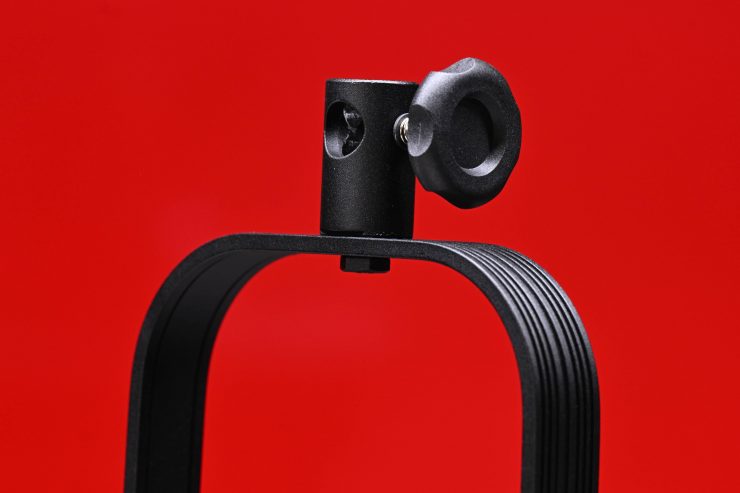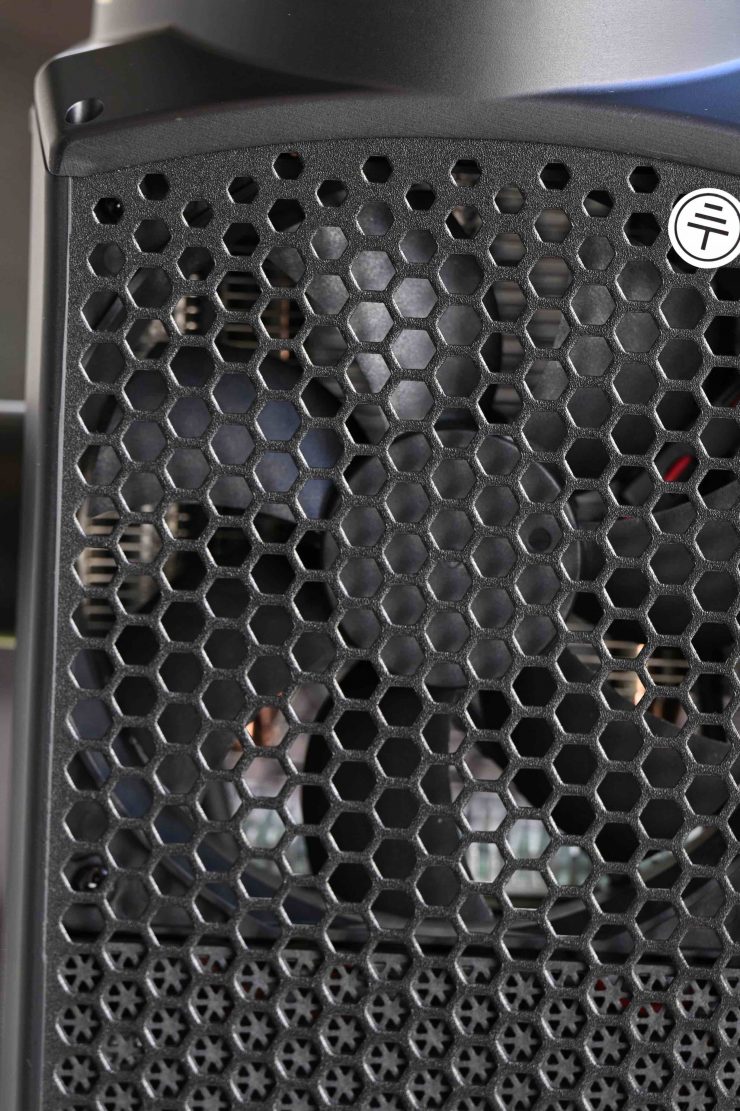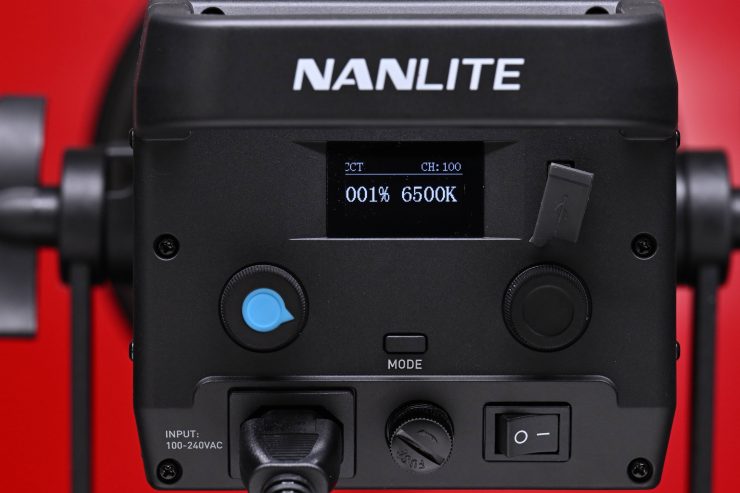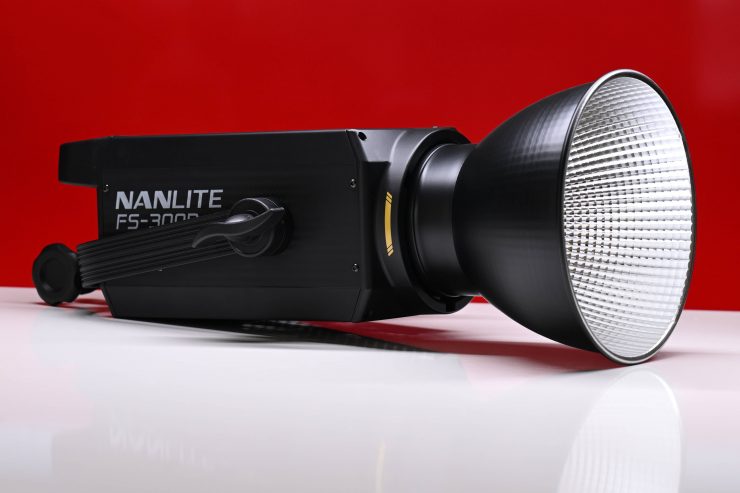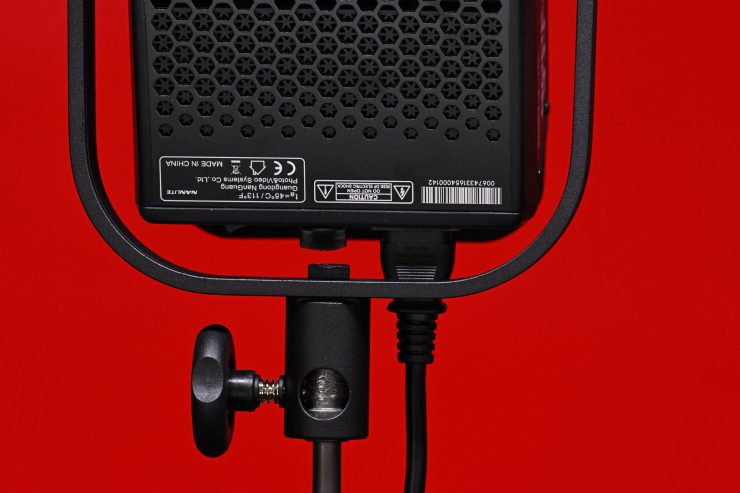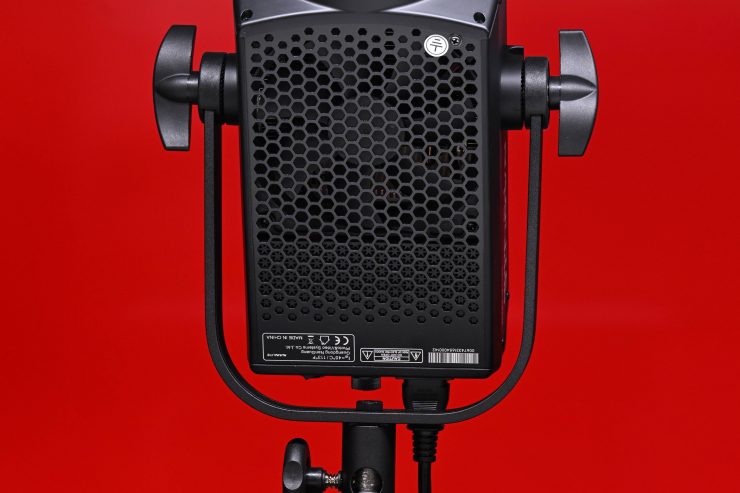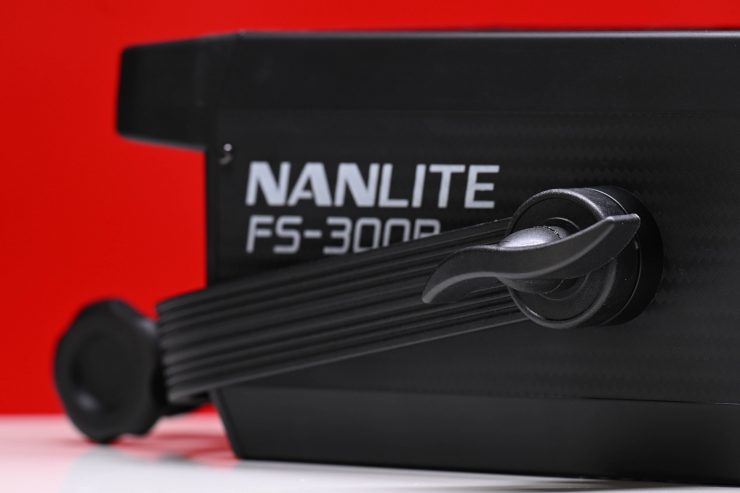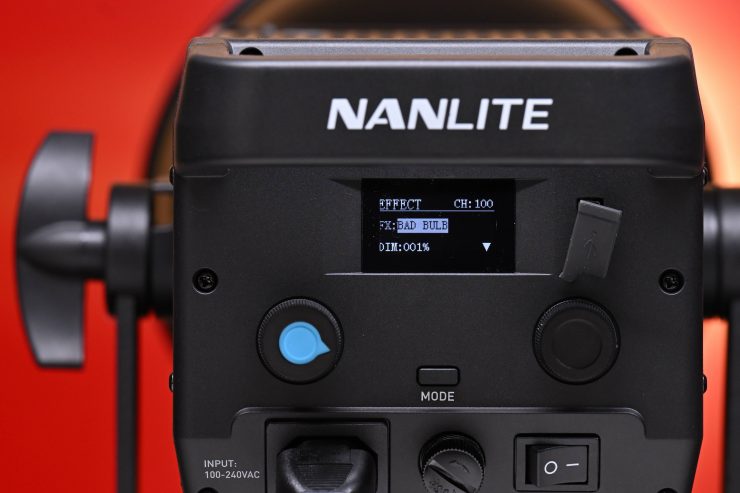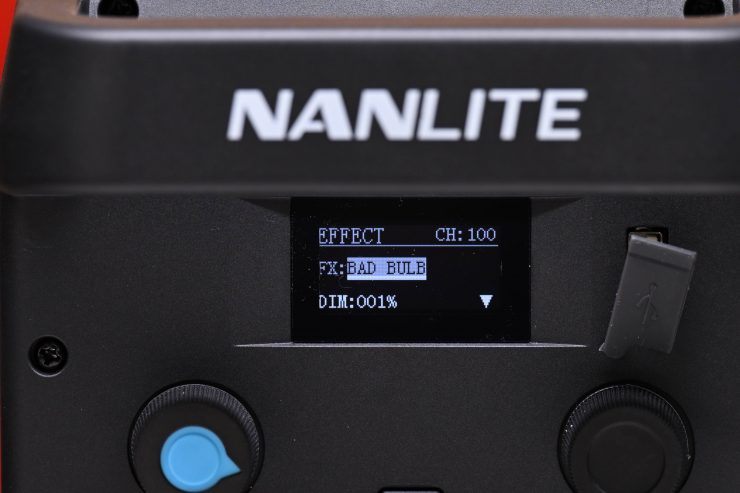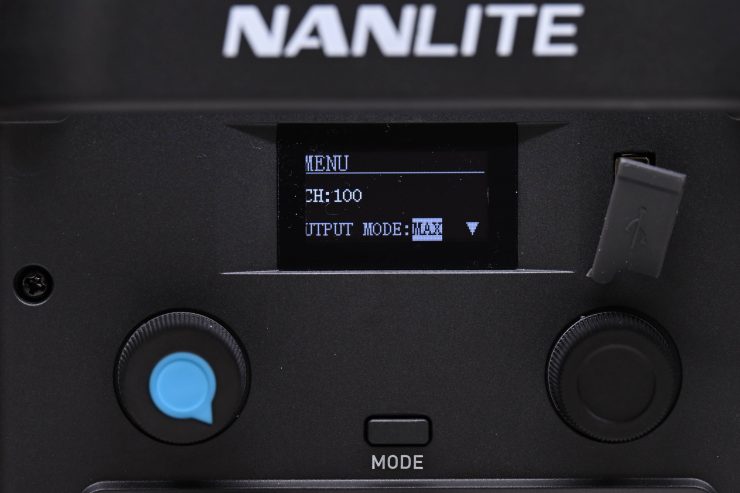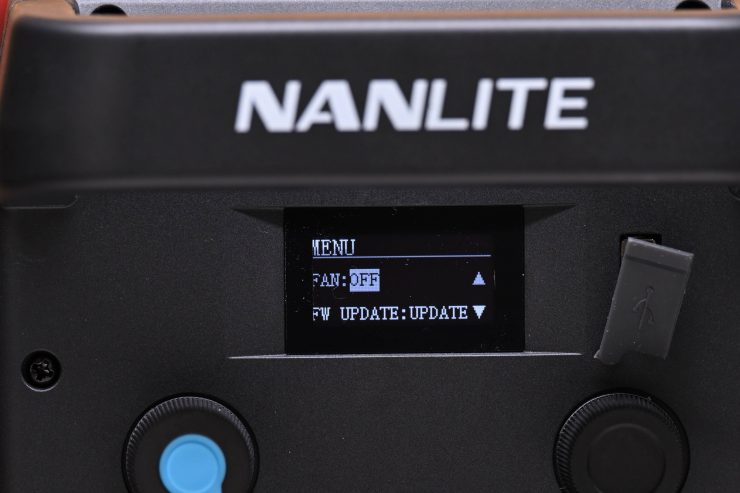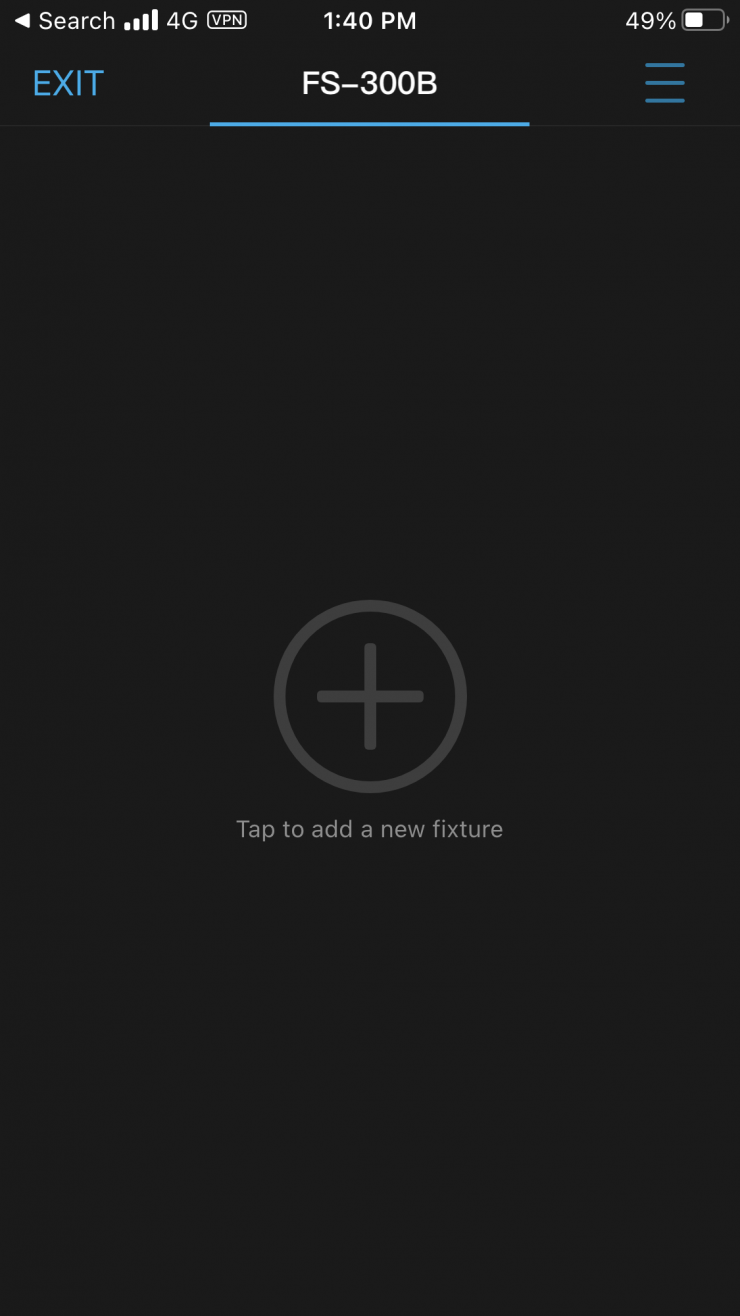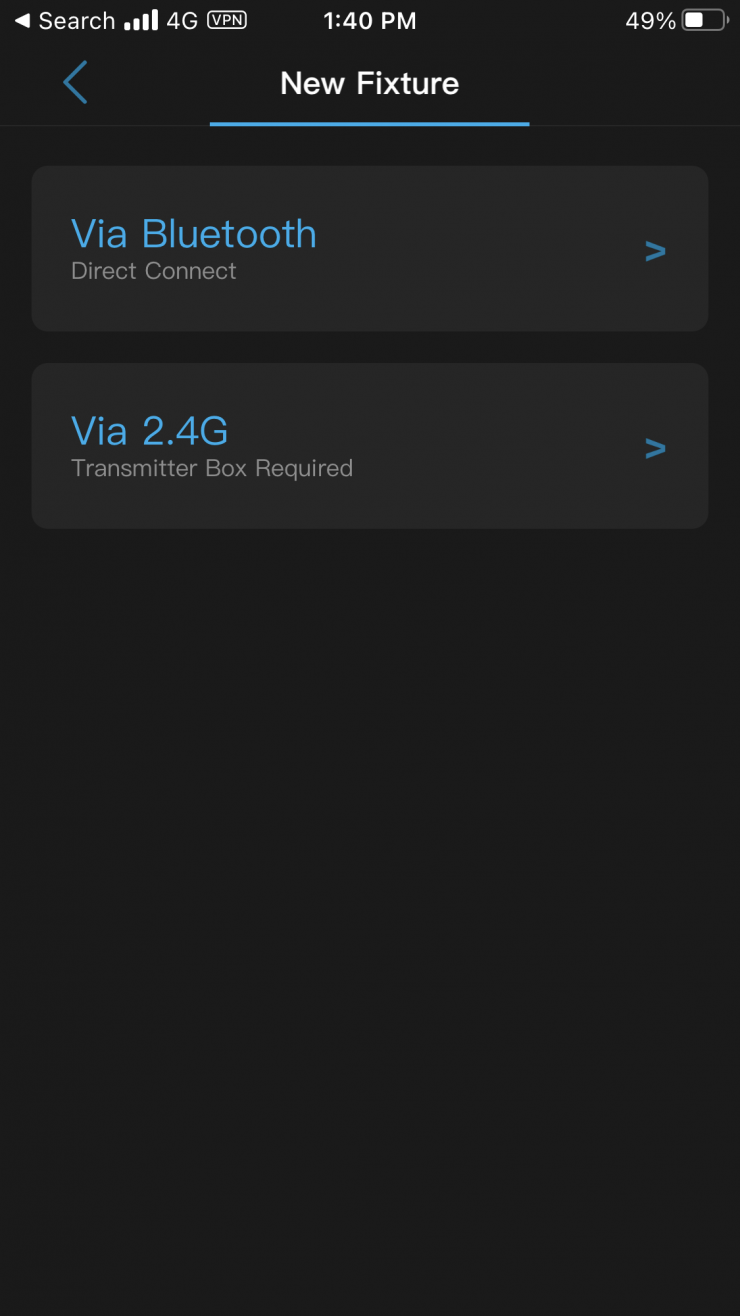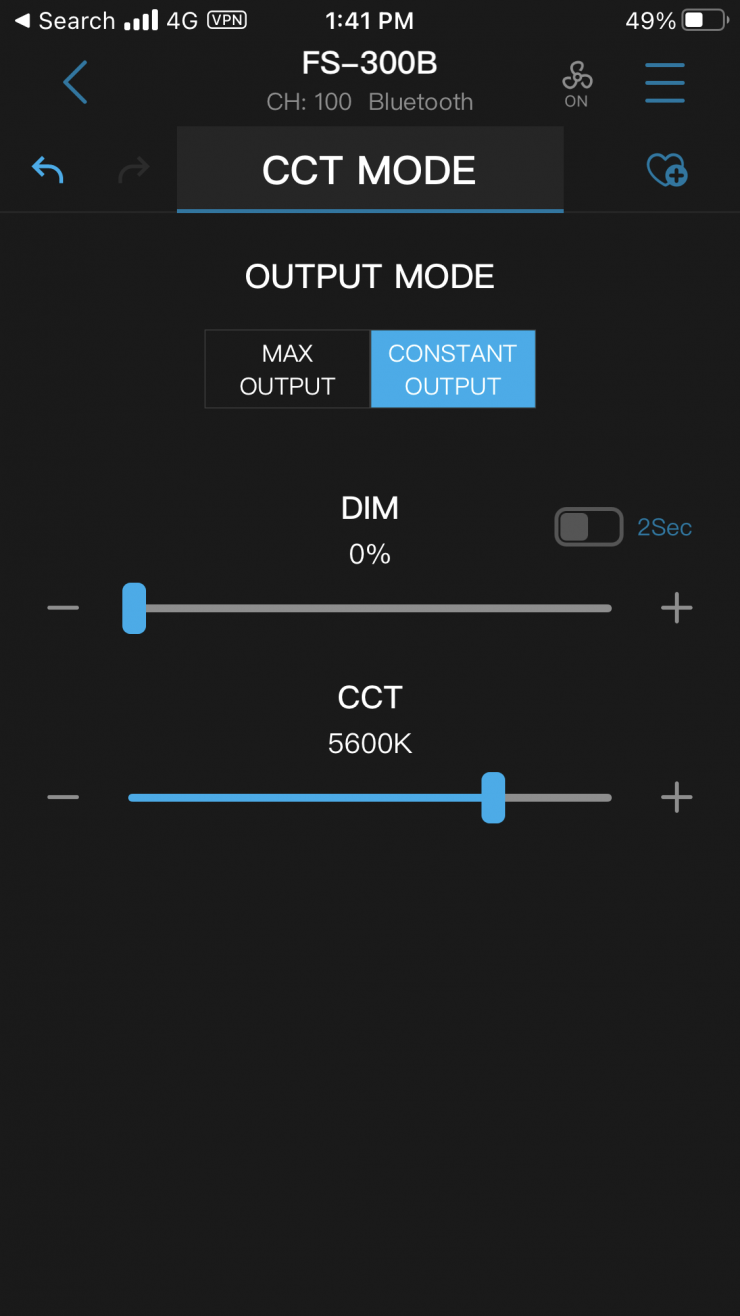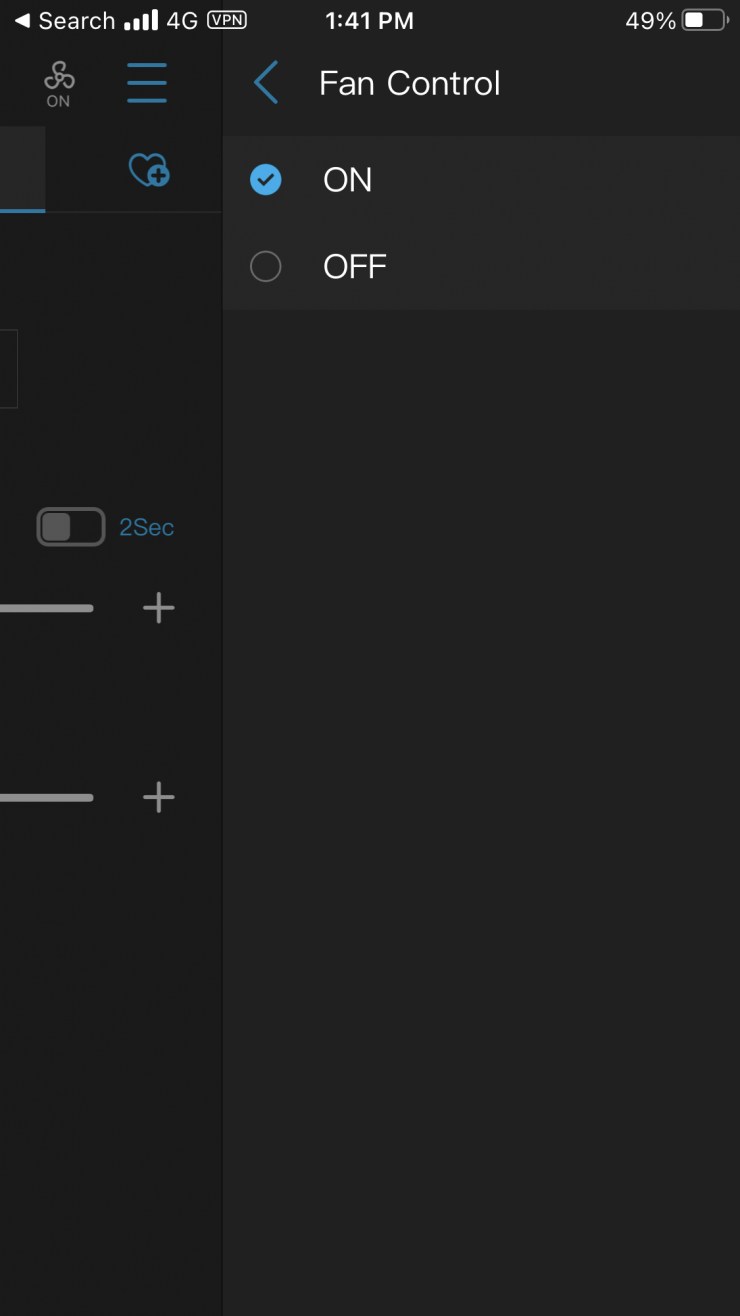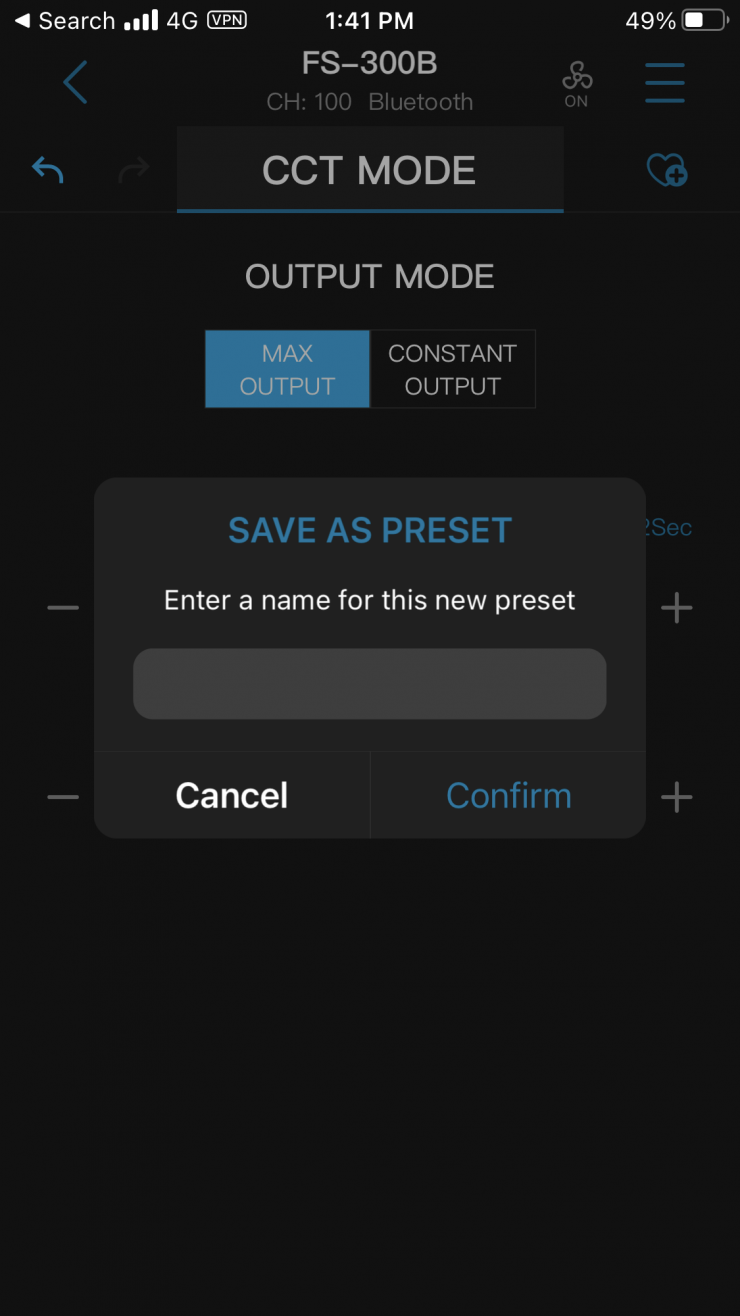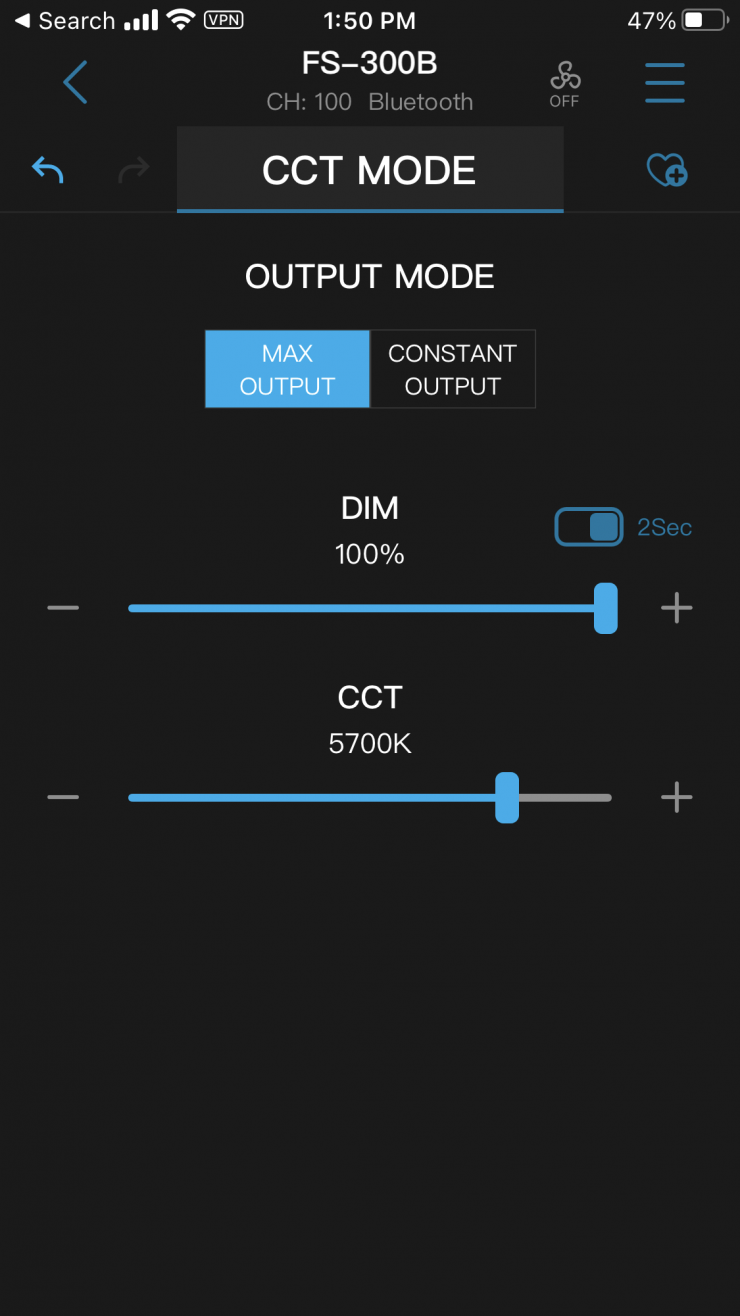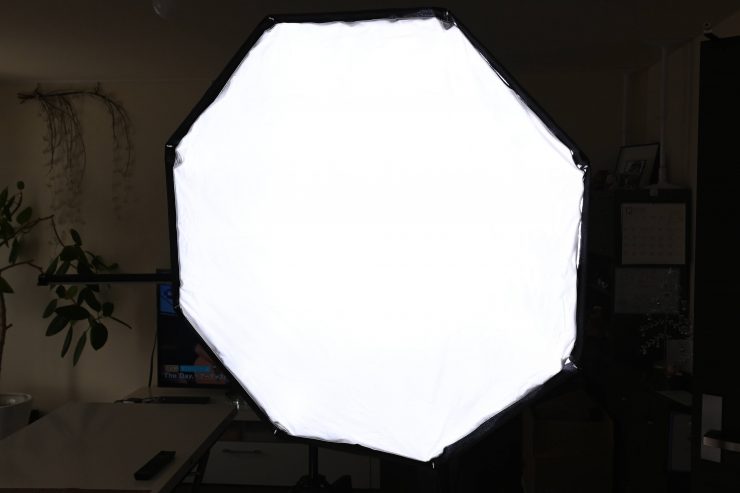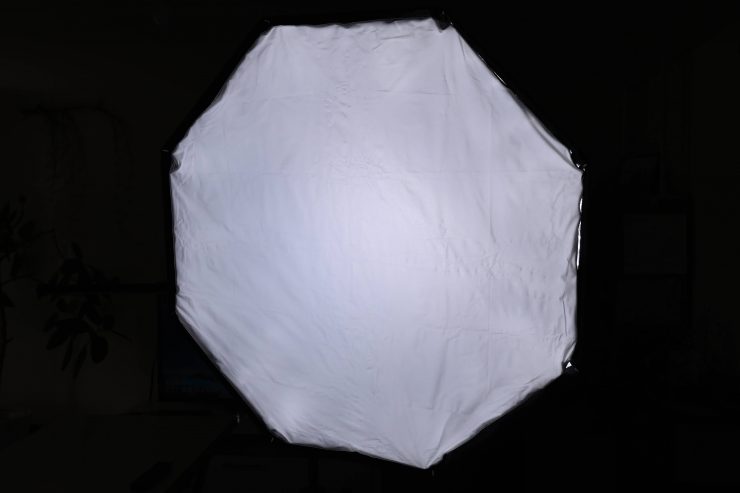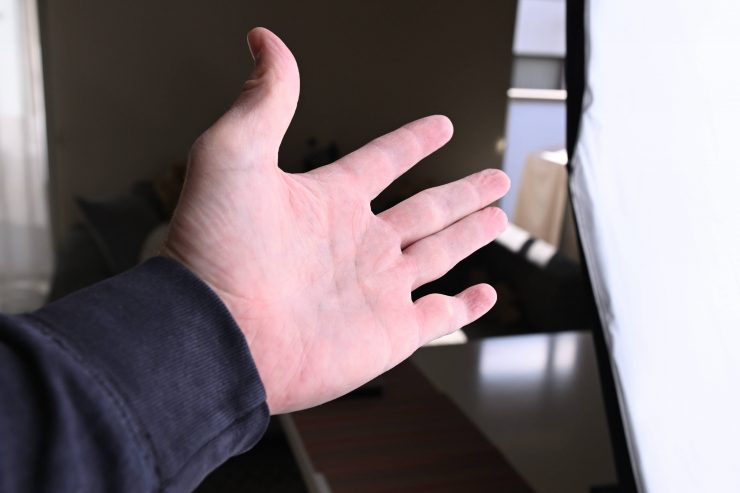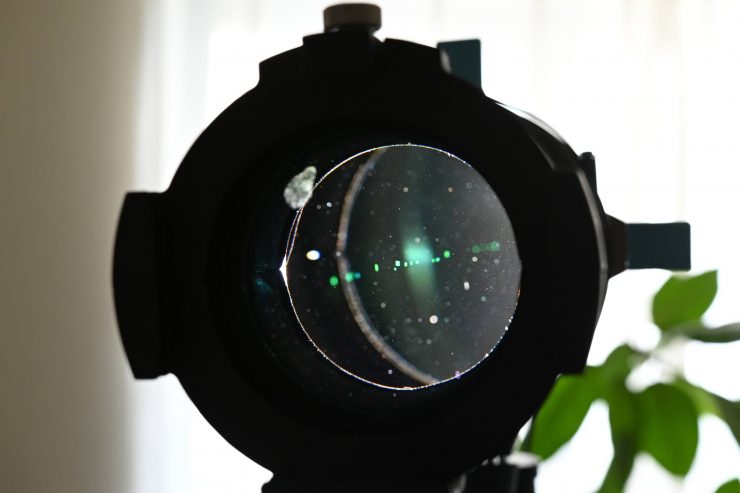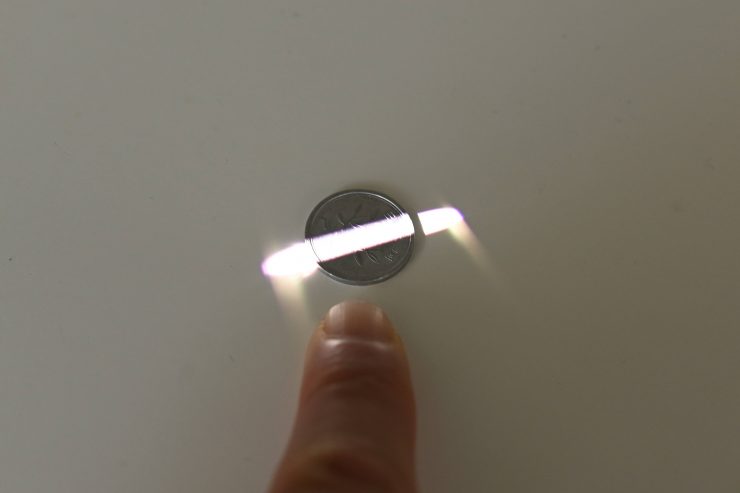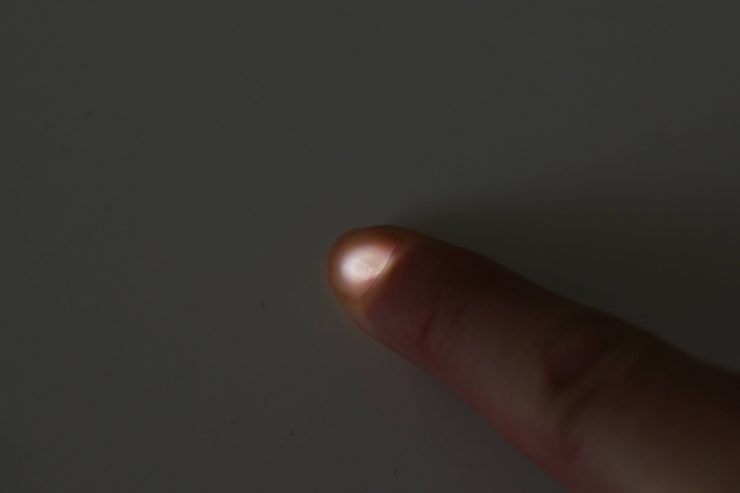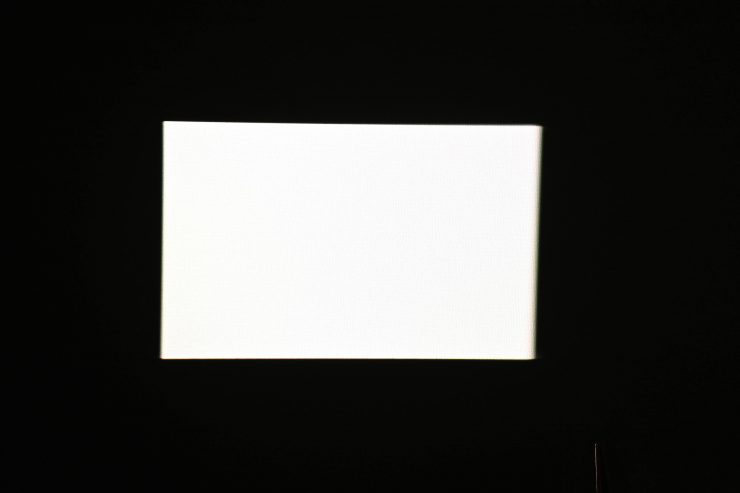
Back in June Nanlite announced its new FS-300B. The FS-300B is a 350W Bi-color LED Spotlight with a CCT range of 2700K-6500K, and it features an all-in-one design. Essentially it is a direct competitor to the amaran 200x Bicolor LED Light and the Godox Litemons LA200Bi Bi-Color LED Light. It has a higher power draw, and more output, while not costing that much more than those lights I just listed.
Key features
- Bi-color spotlight with a wide CCT range of 2700K to 6500K
- Outputs 11,130 lux @ 1M (light only, 5600K) and 38,720 lux @1M (with reflector, 5600K)
- Two output modes are available
- High color fidelity with an average CRI of 96 and average TLCI of 97
- 12 built-in practical effects customizable with brightness, color temperature, and speed
- 1.3-inch OLED display, two knobs, and one button user interface
- Supports 2.4G, Bluetooth, and NANLINK APP control
- Bowens Mount and umbrella holder for more modifiers options
- Firmware is updatable via the USB-A port on the fixture body
Just like the rest of the FS series, the FS-300B was designed as an entry-level lighting fixture with easy-to-use controls.
As I have mentioned numerous times before, versatile COB lights in this form factor have become increasingly popular due to their swiss army knife style abilities, which enable them to be used for a variety of lighting scenarios. This is why we have seen so many of them being introduced over the last few years and why there are so many options to choose from.
According to Nanlite, the quality of the FS-300B is on par with other Nanlite fixtures even though it was developed for entry-level shooters. It has a claimed CRI of 96 and a TLCI of 97.
The Nanlite FS-300B looks to be an interesting light given its relatively low cost, claimed output, and affordable price tag. So without further ado, let’s get on with the review.
Concept
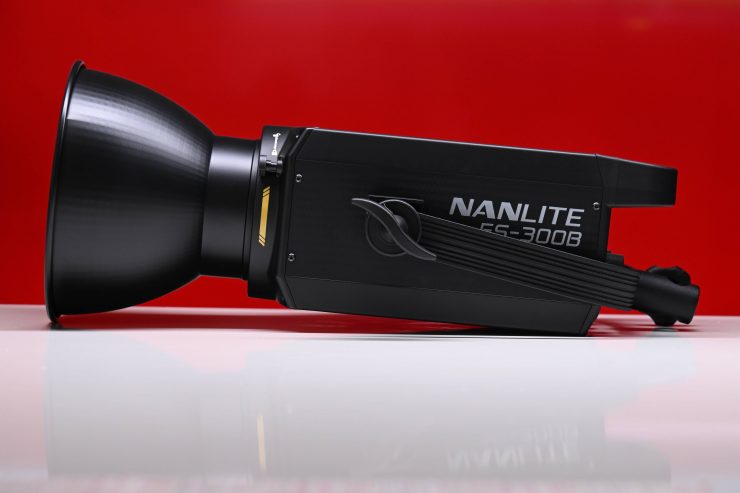
The concept behind all of these LED spot lights, whether they are daylight, bi-color, or full color, is to make a very flexible, fully-featured lighting source that won’t empty someone’s wallet. The only problem with this concept is that so many lighting companies are doing the exact same thing, that it is hard to make your product stand out.
Nanlite also has a ton of very affordable lighting modifiers such as the FL-20G Fresnel and the Projector Mount for Forza 60 and 60B LED Monolights (19°). These affordable options certainly increase the versatility of the FS-60B.
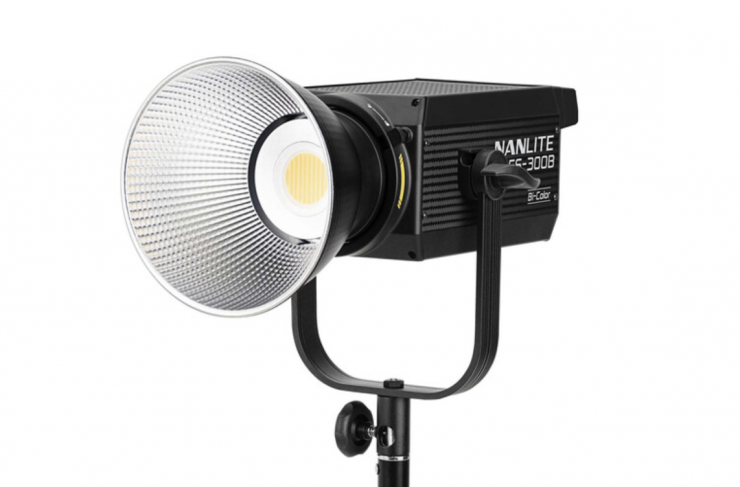

FS-300B 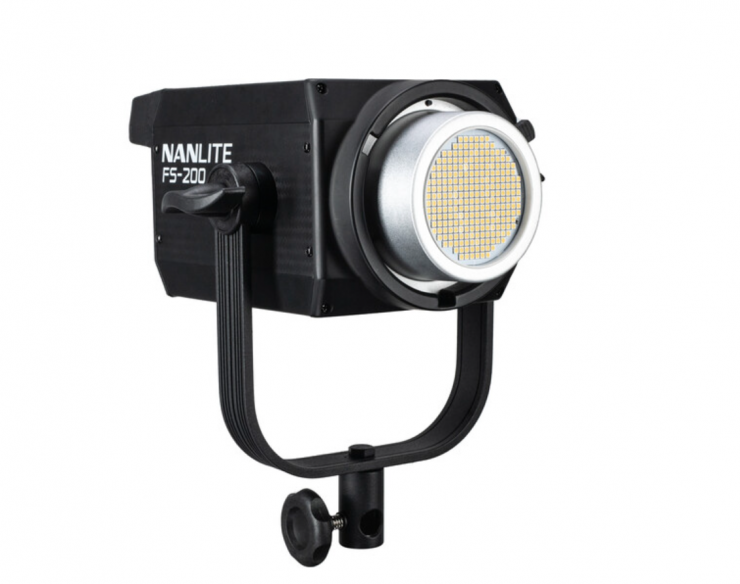
FS-200 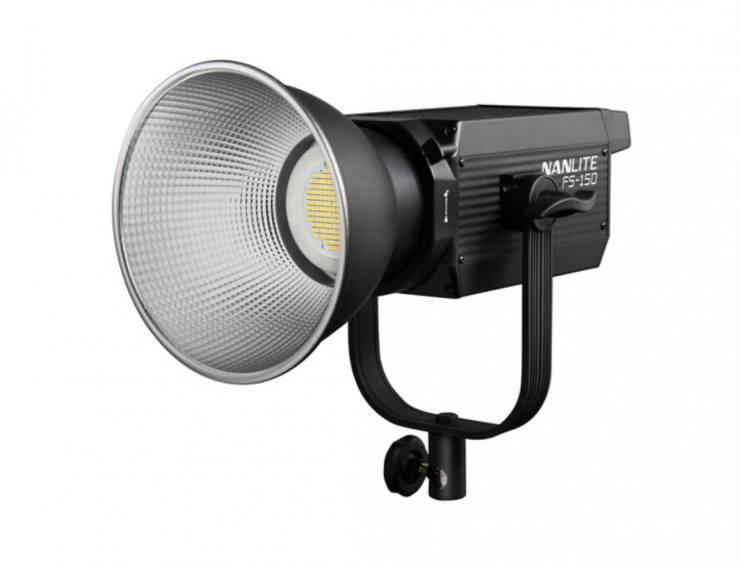
FS-150
Appearance-wise, the Nanlite FS-300B looks very similar to Nanlite’s own FS-200 and FS-150 fixtures.
Build Quality
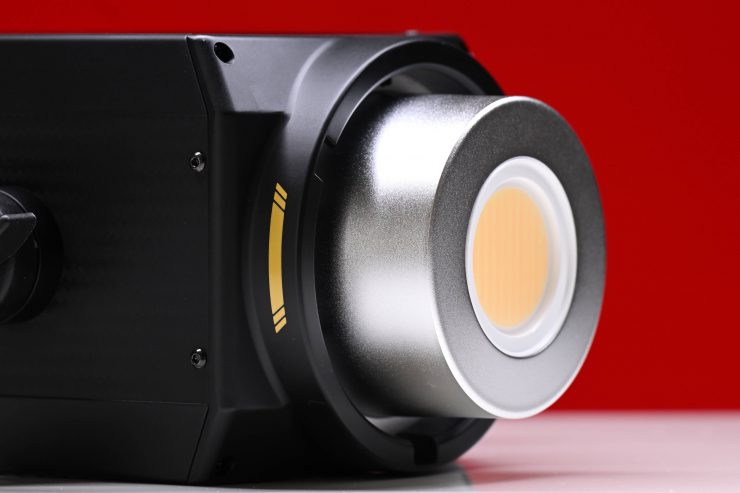
The build quality of the Nanlite FS-300B is ok, given its low price tag. The housing is reasonably robust but don’t expect it to have the same feel or quality as more expensive fixtures.
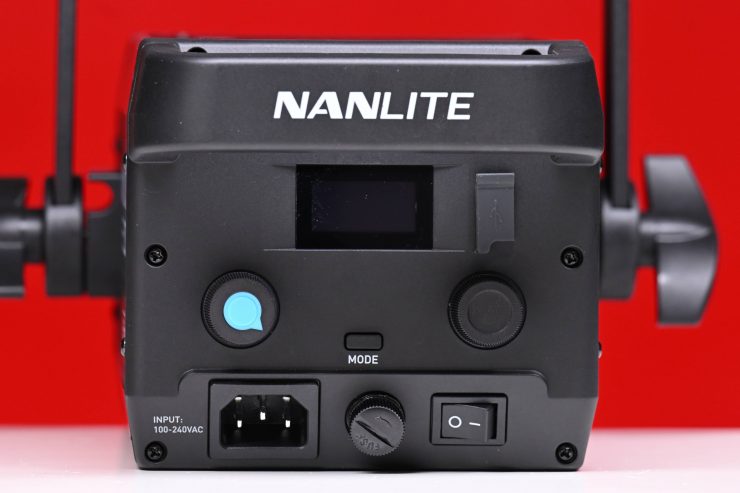
The power on/off button and the rest of the dials and buttons, at least in my opinion, do feel a little on the cheap side, but that is understandable given the sub $300 USD price point. They don’t have a tactile feel.
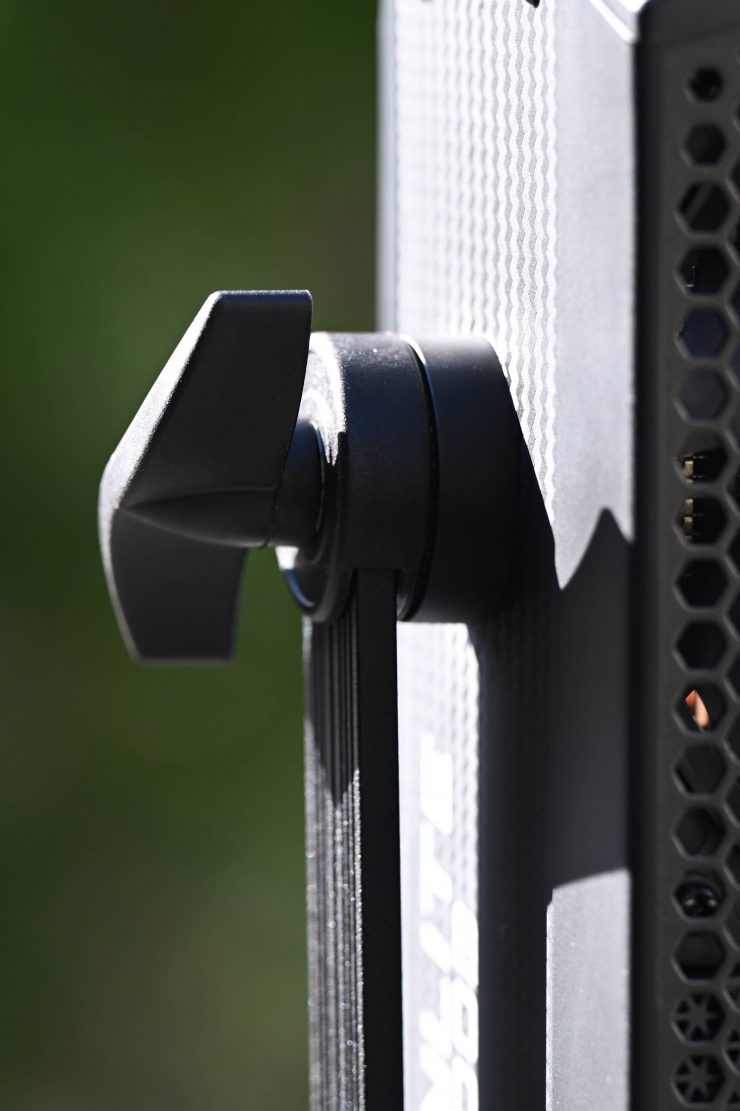
The yoke frame locks down securely when tightened, but the knobs that you use to tighten do feel a little cheap and not overly robust.
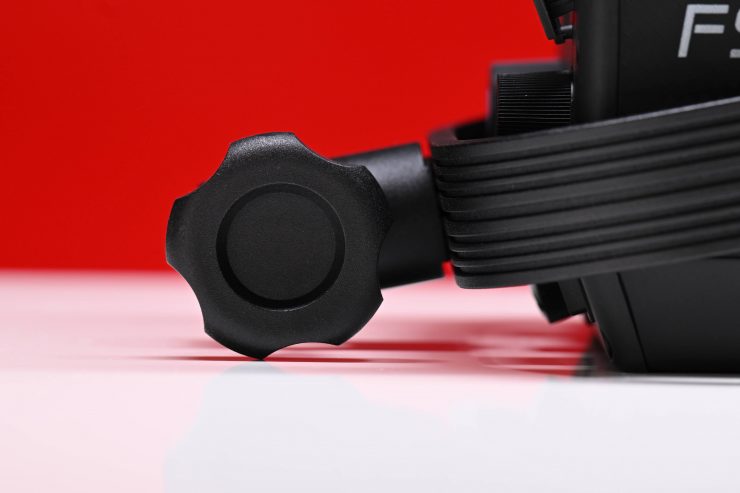
The locking mechanism for where you attach the yoke frame to a light stand is also made out of plastic.
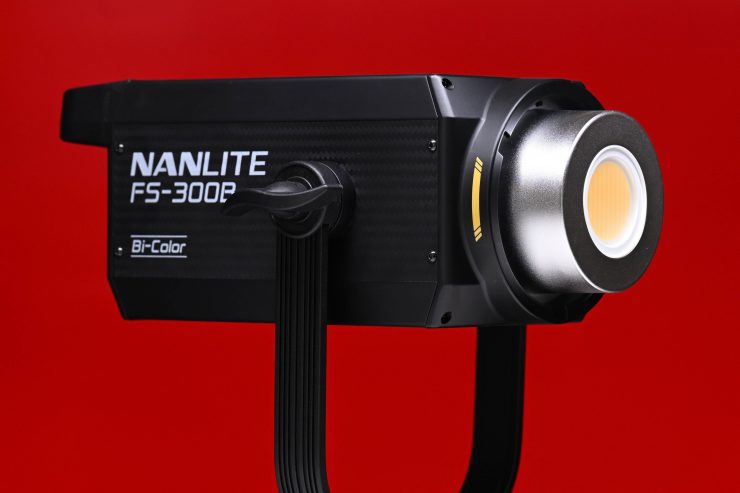
The controller and power supply are built into the light fixture, which helps keep the size and weight to a minimum.
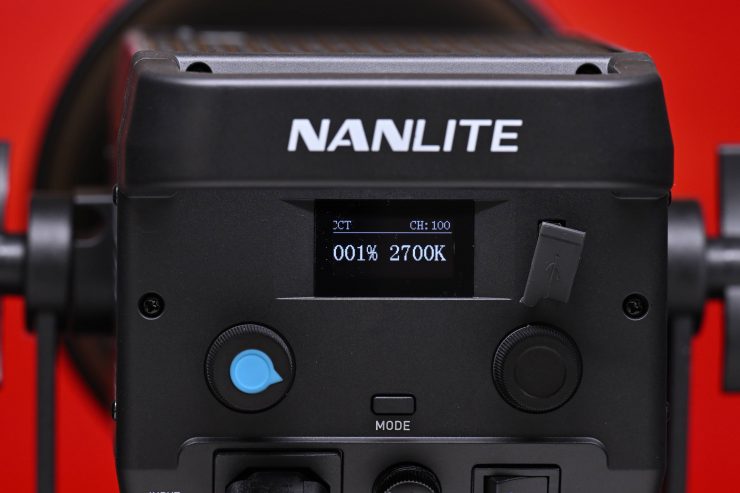
Attention to detail is not something you will find in more budget-conscious lighting products. As an example with this light, once I took out the USB cover I couldn’t get it to sit in properly again.
Also if you don’t have the locking mechanisms on the yoke frame tightened down the light will just tilt backward quite fast because the yoke frame hasn’t been positioned to create an optimal center of gravity.
The light comes with a limited 2 Year Warranty which can be extended to 3 years by registering online.
COB Design
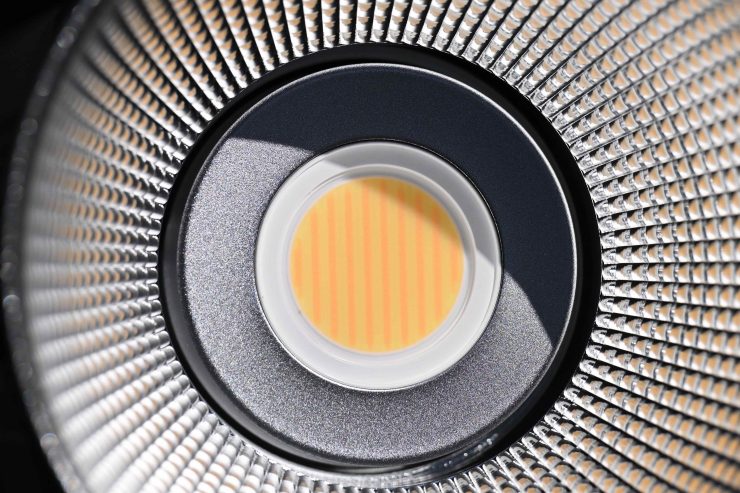
Lots of LED lights on the market, including the Nanlite FS-60B are using COB technology. COB stands for “Chip On Board” where multiple LED chips are packaged together as one lighting module. The advantage of COB LEDs being multi-chip packaged is that the light-emitting area of a COB LED can contain many times more light sources in the same area that standard LEDs could occupy. This results in a greatly increased lumen output per square inch.
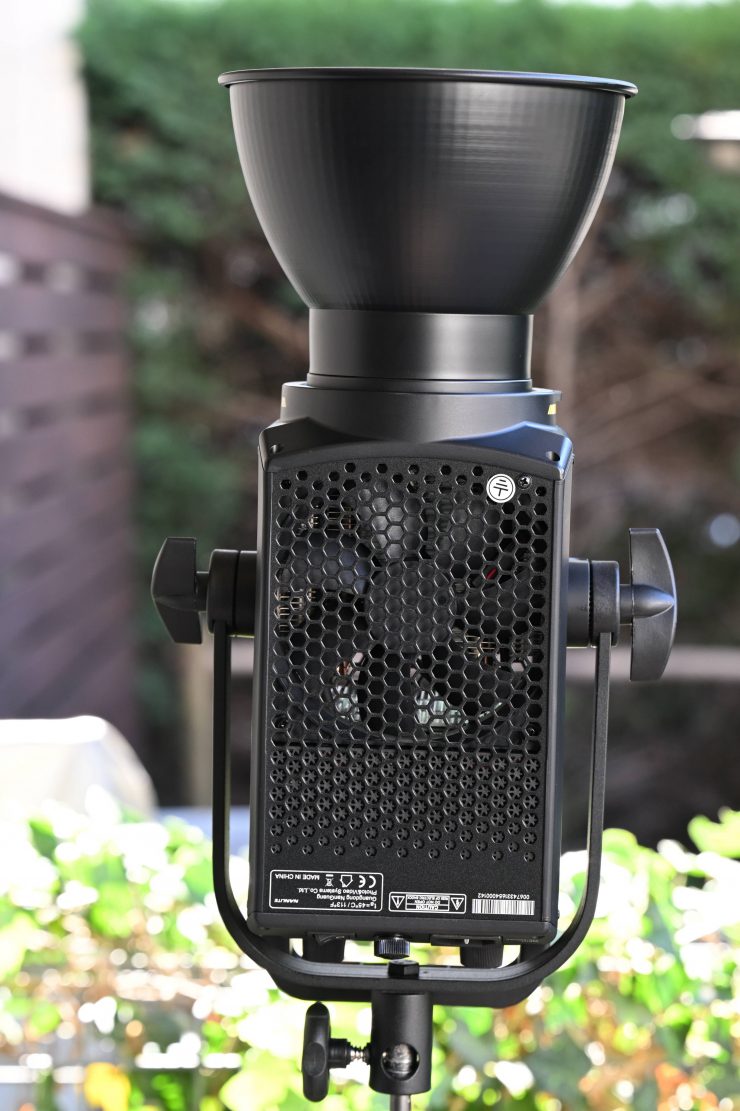
The fixture does feature a decent-sized fan that is on the underside of the light.
The biggest problem with COB LED lights is that unless you diffuse them they are very bright to look at and unsuitable for directly lighting talent.
Weight & Size
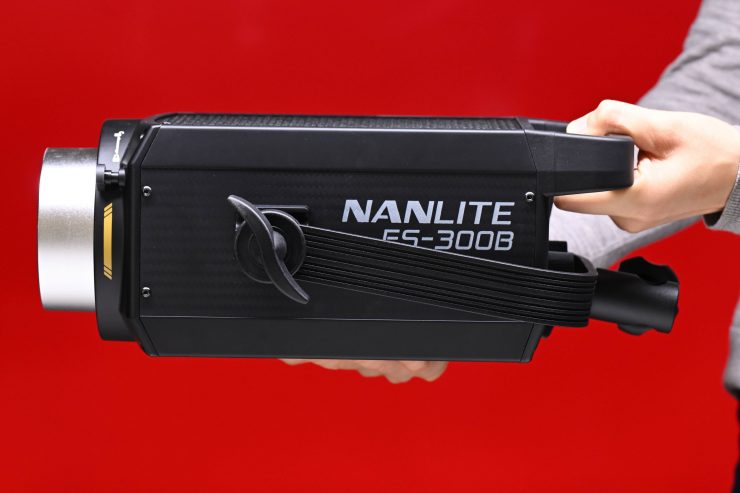
The Nanlite FS-300B is reasonably compact for a 350W fixture, and that is one of its biggest appeals.
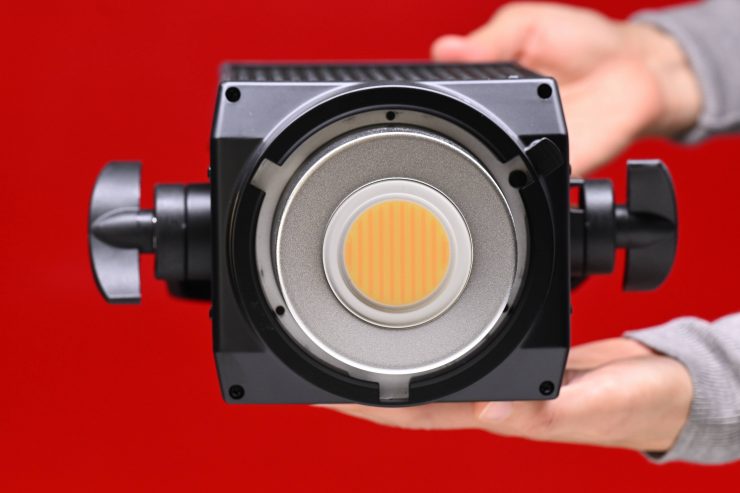
It weighs just 7.12 lb / 3.23kg with its reflector. As the controller and power supply are built into the lamp head you don’t have to worry about any additional components.
The nice aspect about this reasonably low weight is that you can use it with a lot of lightweight and compact light stands. This makes it a good option for anyone who needs to travel with minimal gear.
| WEIGHT | |
| FS-300B | 7.12 lb / 3.23kg |
| LS 300x | 25.13 lb / 11.4 kg |
How does the weight compare to the Aputure LS 300x? Above you can see that the Nanlite FS-300B is considerably lighter than the Aputure.
CCT range

The FS-300B has a CCT range of 2,700K to 6,500K. This is a decent enough range and it will suit most people’s needs.
Beam Angle
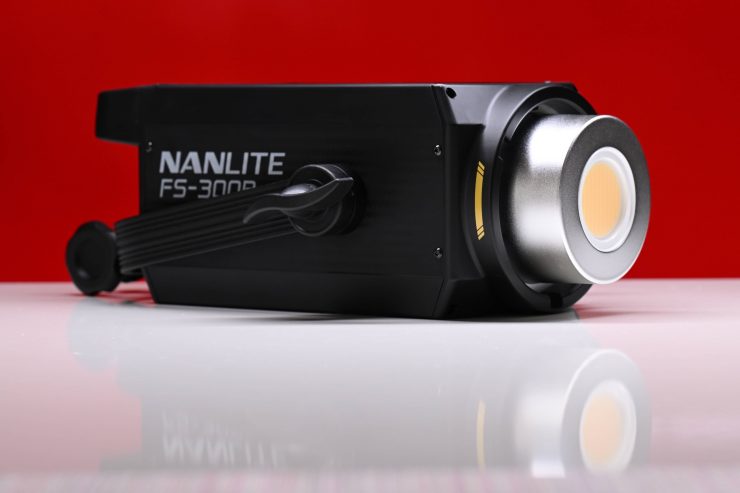
The beam angle of the fixture, when used open face, is 120°. If you use it with the included reflector it is 55°.
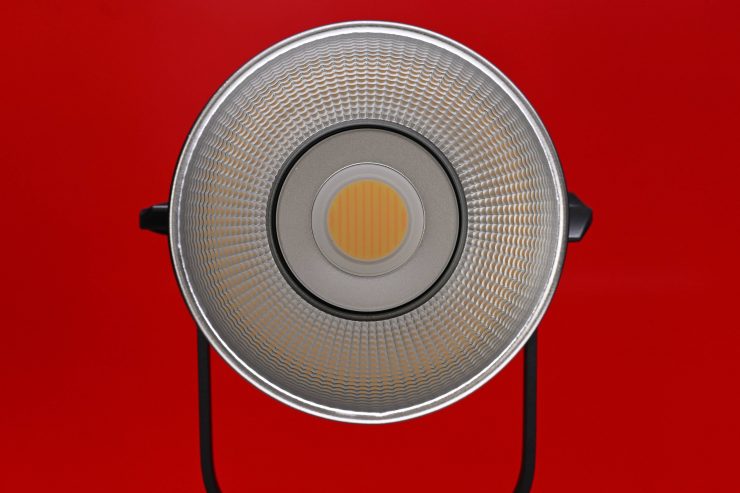
The included reflector is similar to what you would find on a lot of Bowens mount spotlights.
Mounting
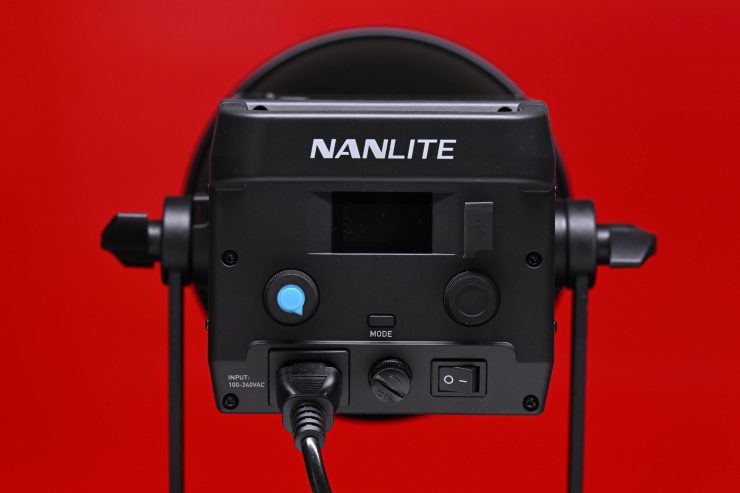
The Nanlite FS-300B comes with a traditional two-sided yoke frame. There isn’t a lot of clearance and the power cable will end up hitting the yoke frame if you try and tilt the light up too much.
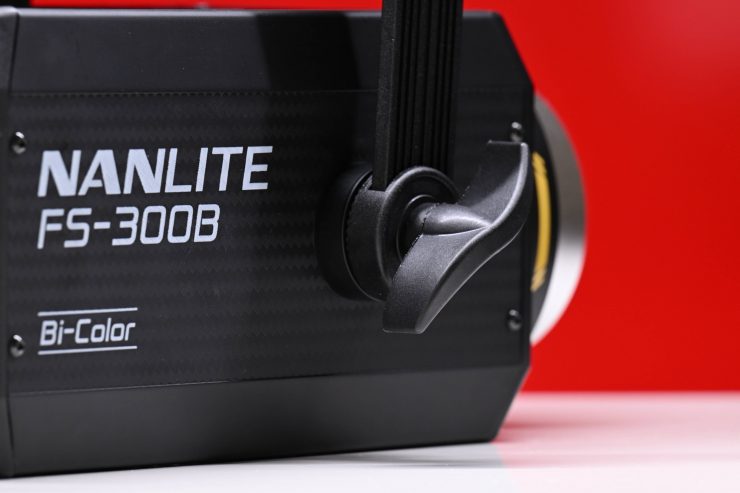
As I mentioned previously, the yoke frame locks down ok, but it does feature a type of rachet design and the locking mechanisms on either side of it are a little on the cheap side and they don’t inspire confidence. In saying that, they will get the job done
Power Draw
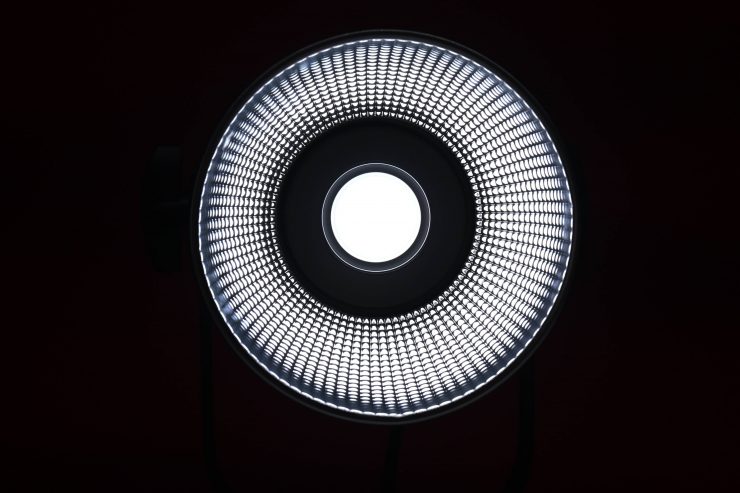
The power draw of the FS-300B is 350W.
In the kit, you just get an AC power cable. As far as I am aware there is no way of powering this fixture remotely, which is an oversight, at least in my opinion.
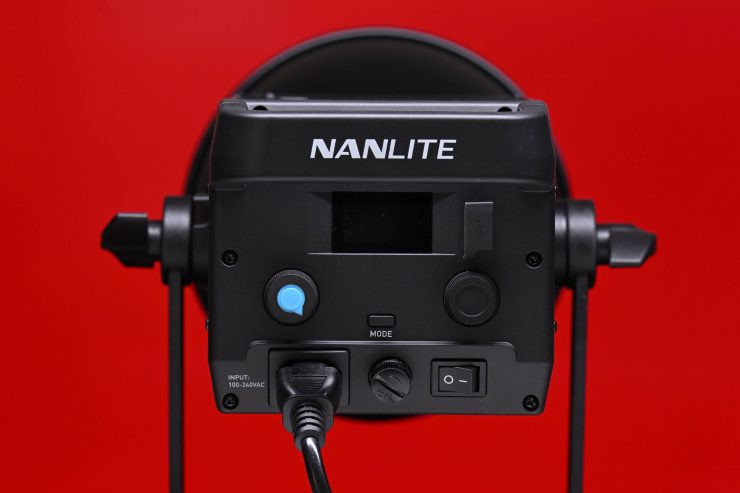
I am not the biggest fan of the nonlocking power cable that goes into the back of the fixture. This feels more consumer than professional, and it doesn’t take much force for the cable to come out.
Mount
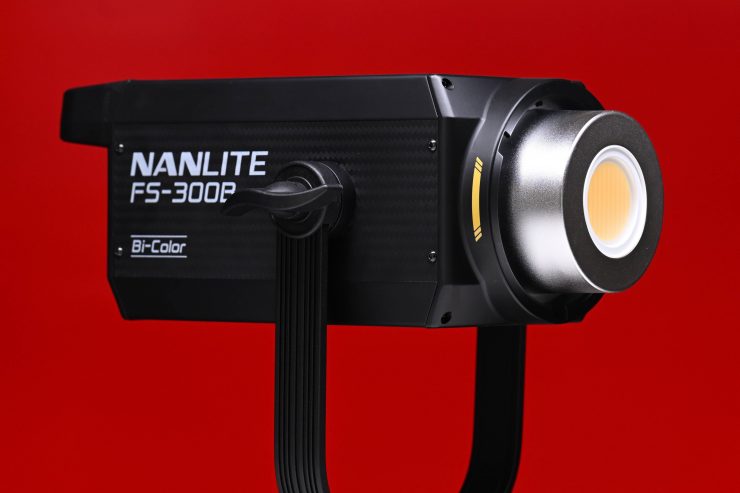
Like most COB spot lights, the Nanlite FS-300B utilizes a Bowens mount. This allows you to use readily available lighting modifiers and accessories that you may already own.
Controls & Menu System
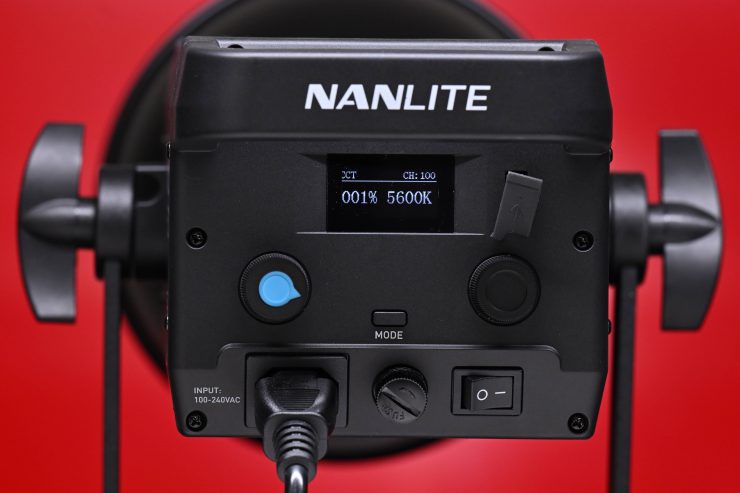
The rear LCD screen on the light looks similar to what you would find on most of the Nanlite products. Although it is fairly basic, it does show you key information about the lights operating modes, brightness, CCT, etc.
With a good light, you shouldn’t have to read a manual to work out how to operate it. You should be able to turn it on and use it straight away. With the FS-300B that is a little hit-and-miss. While it is easy to make changes to the CCT and brightness, the menu is a little more complicated and not so intuitive. I would have preferred to have seen a dedicated menu button.
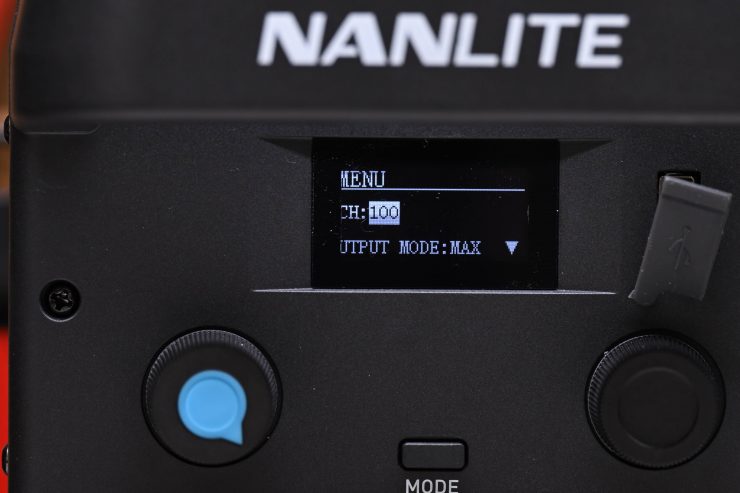
In the menu, you can adjust quite a few settings, such as the DMX, fan, etc. The menu isn’t perhaps the most intuitive, but it is still easy enough to make changes to items that you will probably very rarely need to adjust.
As well as being able to adjust certain parameters and modes on the light itself, you can also use the NANLINK Bluetooth app. Additionally, 2.4GHz provides control through the separately-available WS-TB-1 transmitter box for more elaborate setups, or with hardware remotes like the NANLINK WS-RC-C2. DMX/RDM control is also supported for advanced users.
Operating Modes
The light has the following lighting modes that you can access from the fixture:
- CCT
- EFFECT
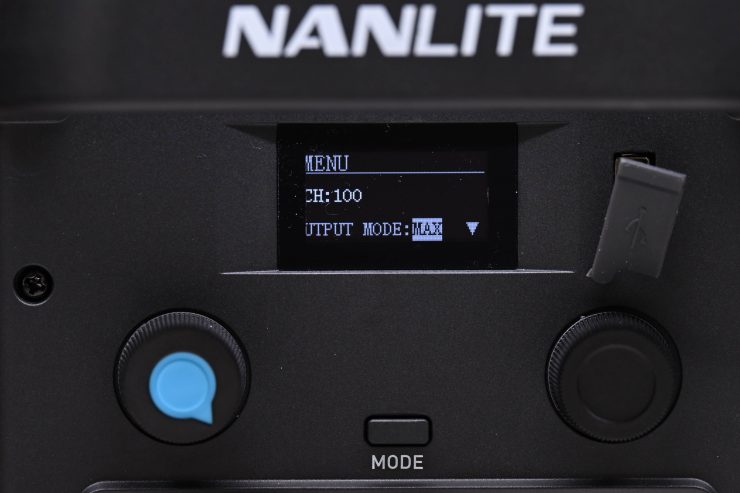
The light features a Maximum Output Mode and Constant Output Mode
and Nanlite claims that there isn’t any CCT shift from 2700K-6500K in either mode.
No +/- Green adjustment
The fixture doesn’t include +/- Green adjustment so can’t easily correct any tint.
EFFECTS

The EFFECTS mode lets you recreate a wide range of lighting effects that can be handy for certain scenarios. The effects include:
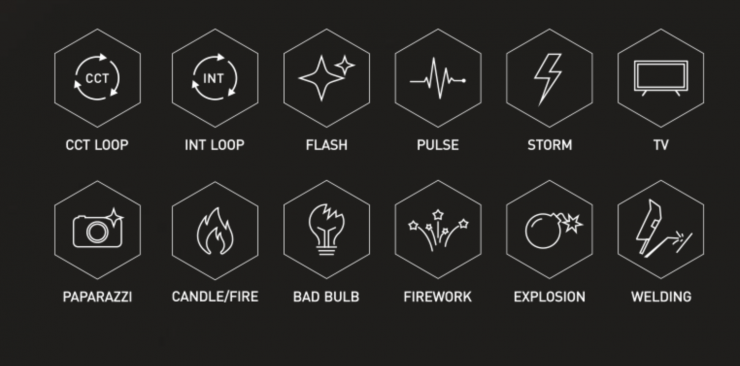
All the effects modes can be individually adjusted, and you change the Speed and Cycle.
Bluetooth App
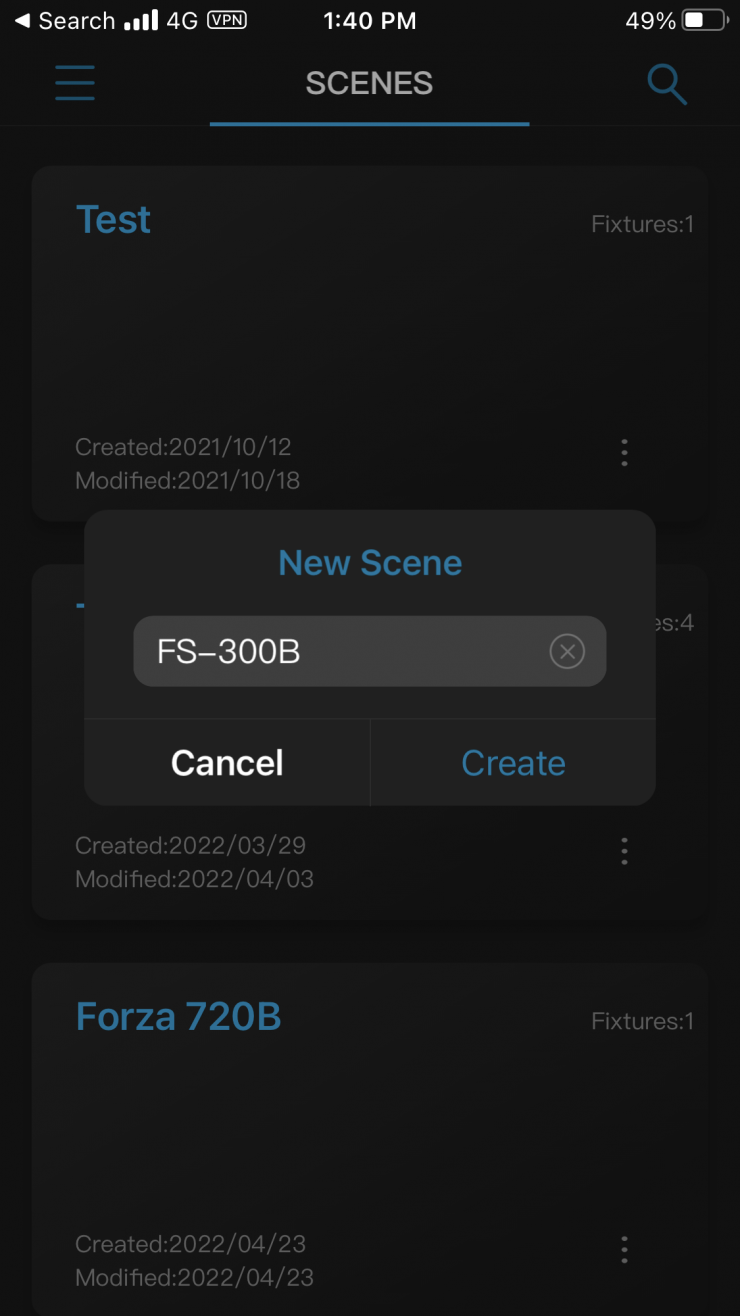
The light can be controlled via Bluetooth using the NANLINK App. It is relatively easy to connect up a light and get started. All you need to do is tap on add a fixture and then choose how you want to connect.
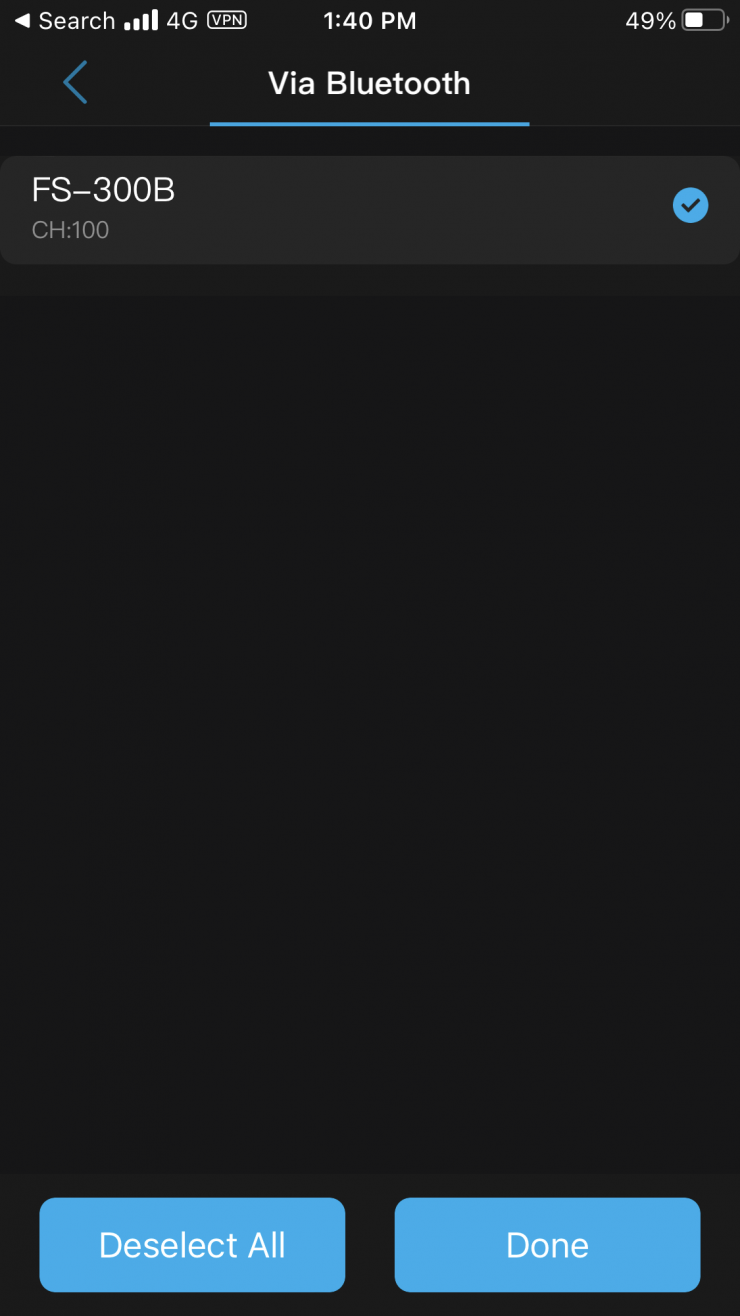
For this example I chose Bluetooth and the app will search for available Nanlite fixtures.
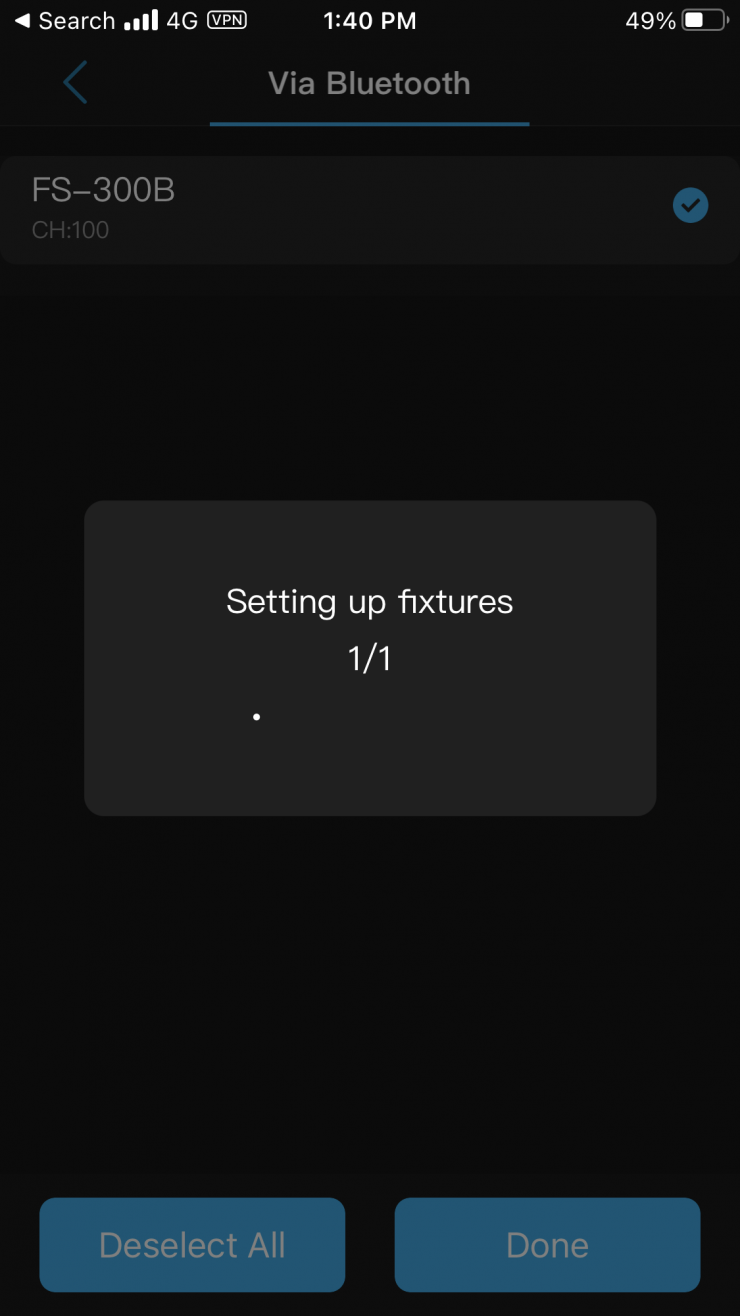
Once you select the fixture you want to add, it takes about 5-10 seconds for the app to configure everything.
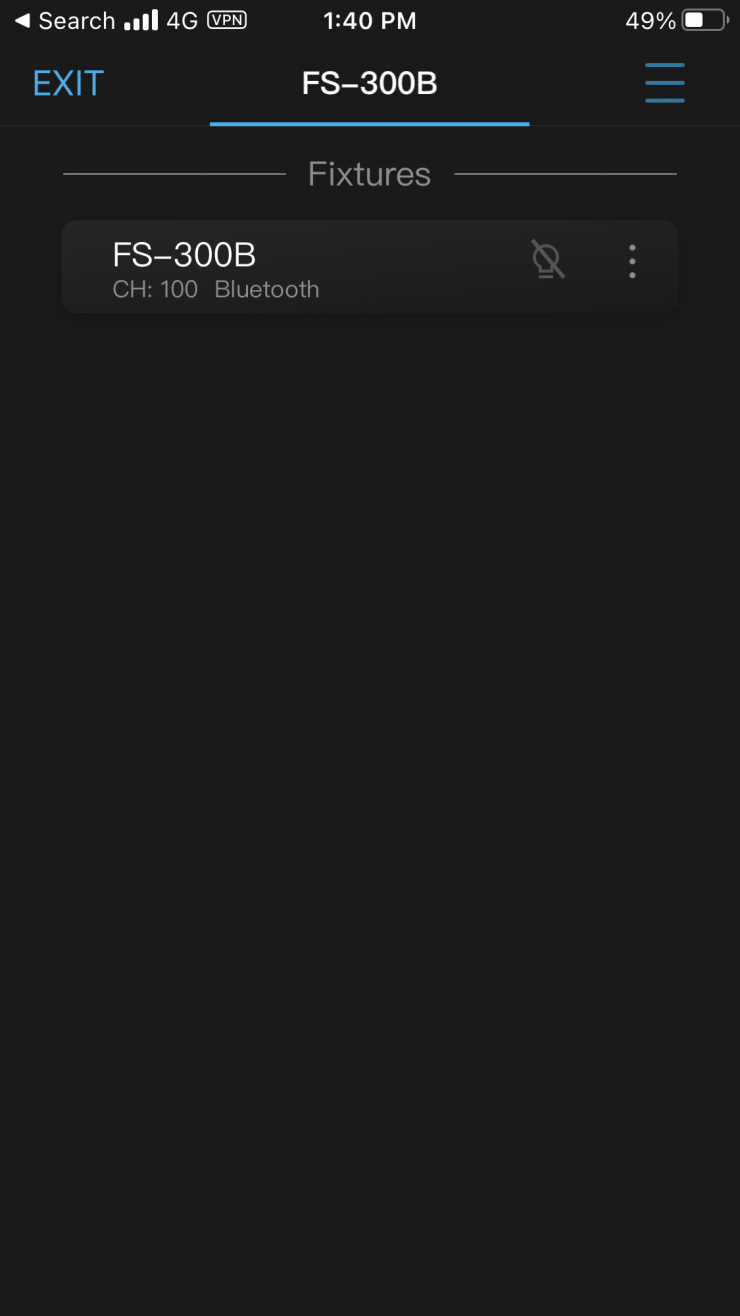
Once the fixture is set up you can see that it has been added to the scene page.
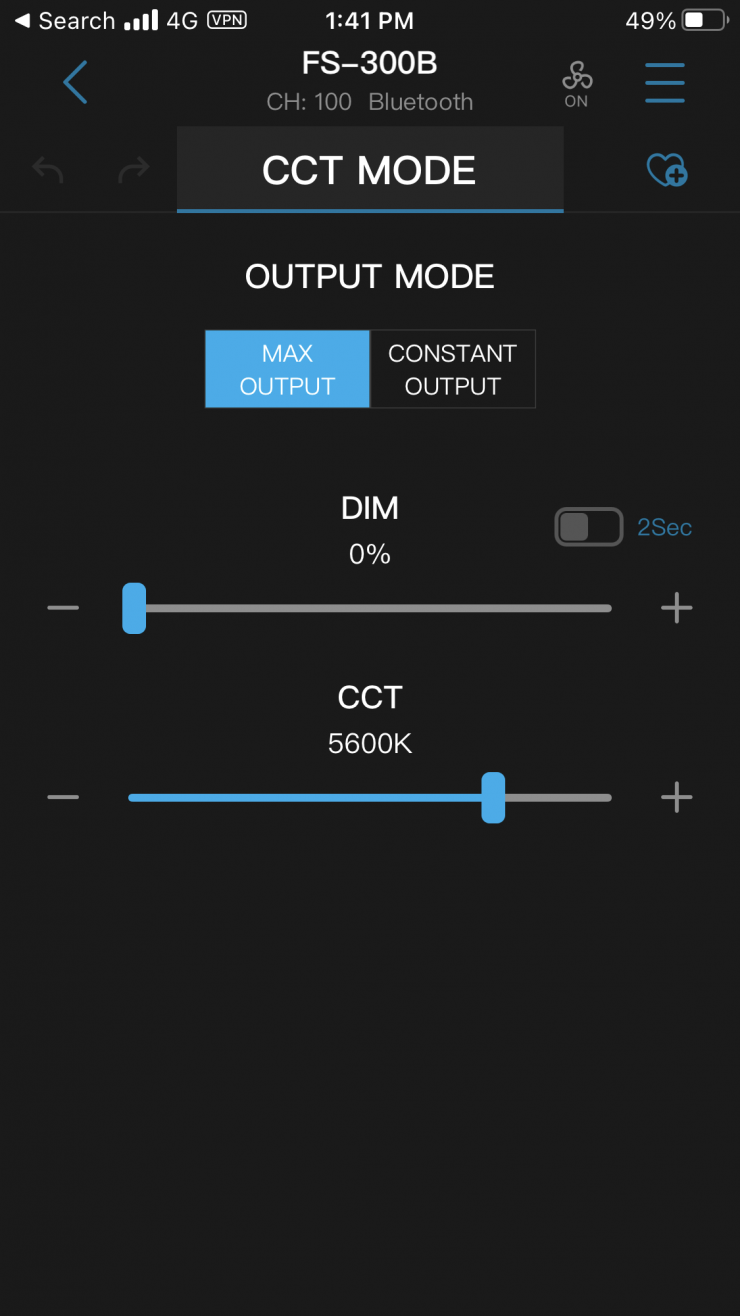
There is a range of parameters that you can adjust using the app, including changing the output, CCT, turning the fan on/off, saving presets, and switching between constant and maximum output modes.
Strangely I couldn’t find any controls in the app to utilize the effects mode.
The app is straightforward and reasonably easy to use, however, they haven’t made it as intuitive or visually appealing as some other companies lighting control apps. This is something I would like to see Nanlite work on.
The only other downside when using the app is that when you make changes they don’t happen instantaneously, there is a slight delay.
How does it stay cool?
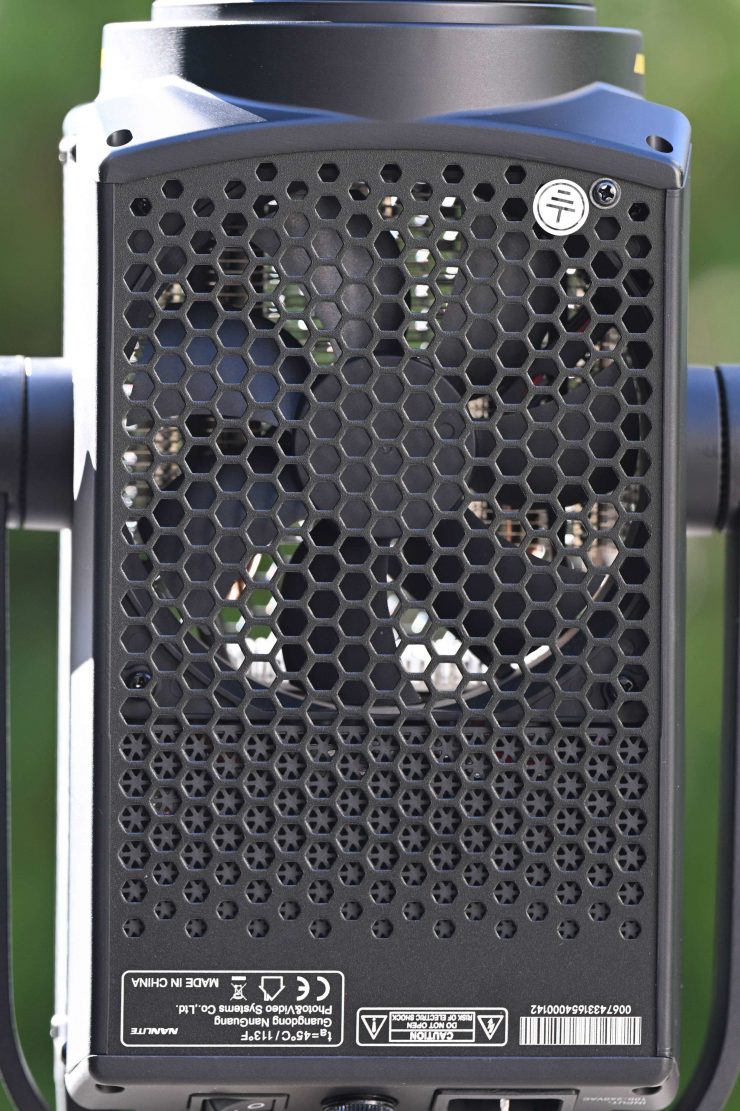
COB lights get very hot, and keeping them cool is not an easy task. The FS-300B, as I mentioned earlier in the review, does utilize a fan.
In the menu settings on the light, you have the choice of turning the fan on or off. If you turn the fan off the maximum output is capped at just 25%.
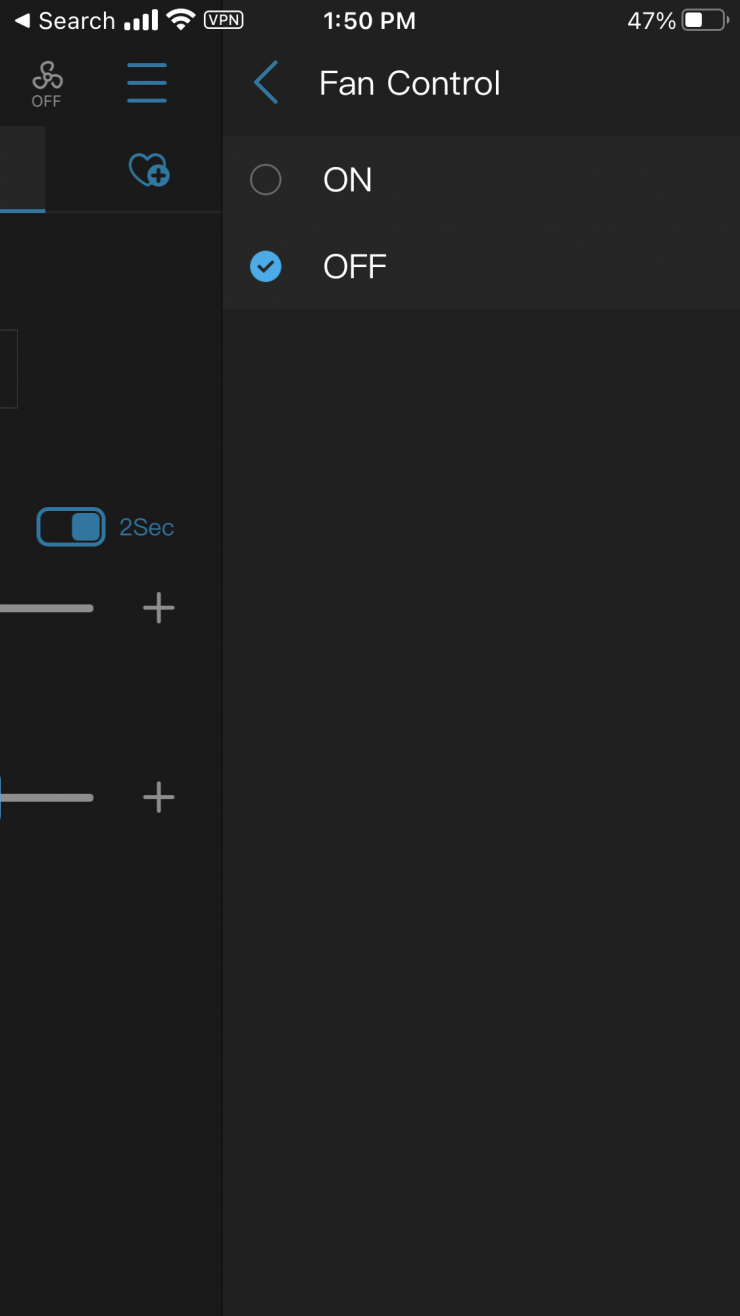
You can also turn the fan on or off using the NANLINK app. The trouble when doing this with the app, is that the intensity slider will still show you values up to 100% even though the light is only at 25% output. This is where I think NANLITE needs to pay more attention to small details. Little quirks like this could easily be addressed by updating the app, but unfortunately, a lot of lighting companies release apps, and then very rarely ever update them.
The fan in the light does make a bit of noise and I probably wouldn’t want to have it any closer than around 3 meters to where the audio is being recorded. It isn’t super loud, but it is loud enough that you will notice it in a very quiet room.
Photometrics
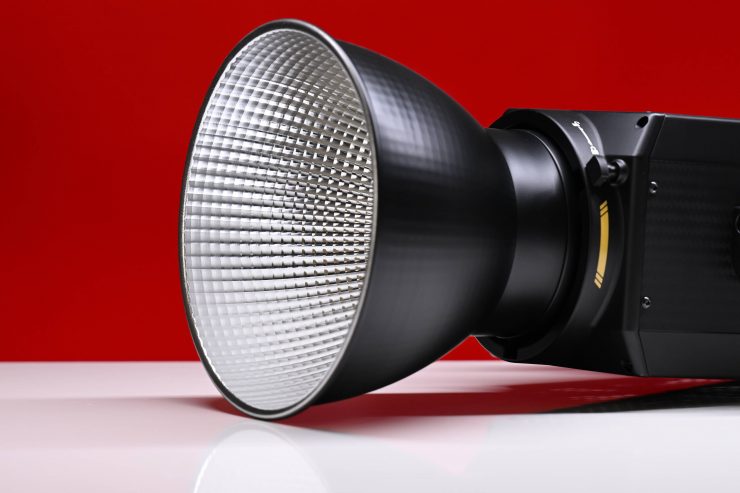
So now let’s get to the photometric results. I always test lights in this way so that I get a reference to how they compare to other fixtures. Results only tell part of the story and should never be used alone to judge a light. I have found from extensive testing over the years that certain lights that have good photometric results don’t always look good, and lights that have worse photometric scores can sometimes look better than their results indicate.
You can’t judge a light from one set of photometric results. You have to look at all of the different results to be able to come to a conclusion.
Different lights can also look different depending on what camera you happen to be using.
Output & Color Temperature Accuracy
I tested the Nanlite FS-300B at a variety of CCT settings with a Sekonic C-800 Spectrometer to find out how much output the light had and how accurate the Kelvin color temperature reproduction was. All readings are taken at a distance of 1m (3.28ft) in a controlled environment. The readings were also taken directly from the lighting source. In the case of using the light with the Reflector, they were taken from the end of that attachment, and not from the COB.
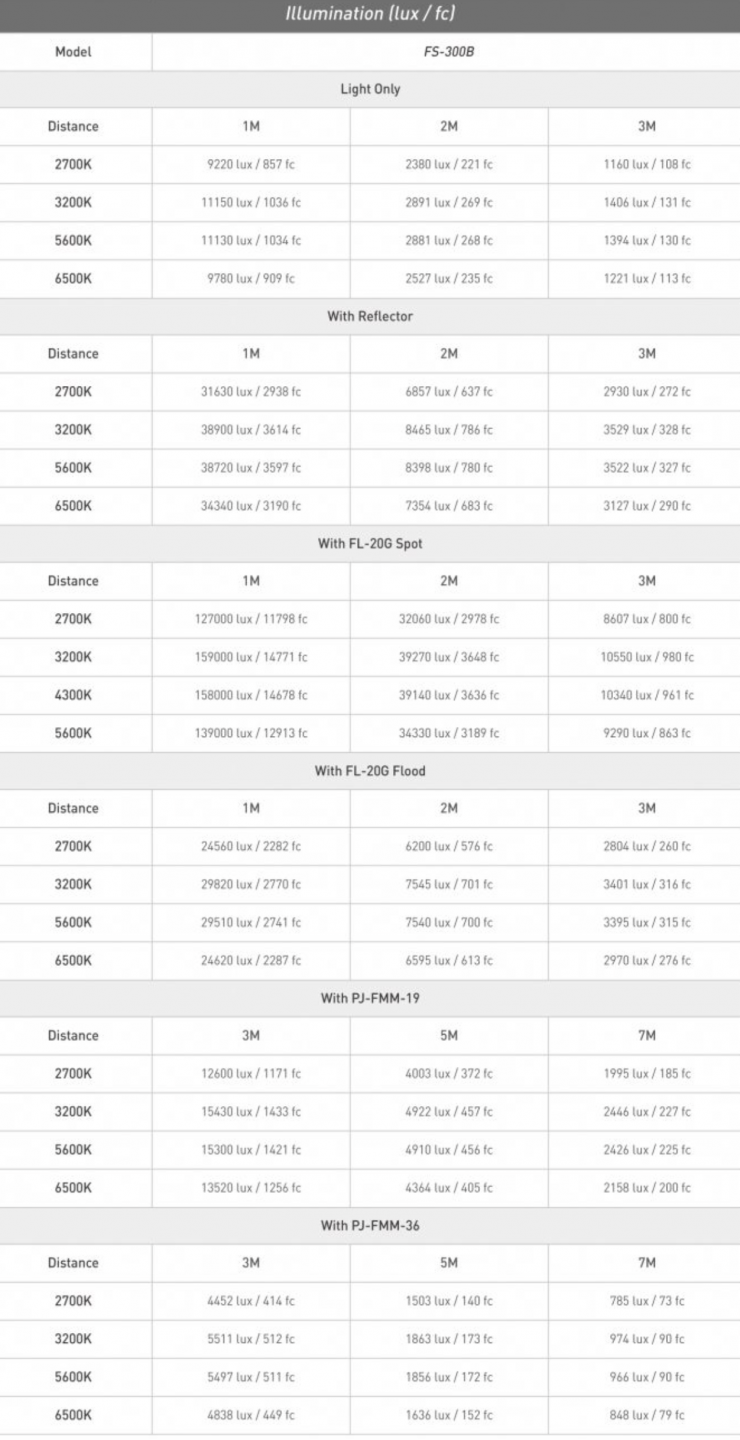
Above are the claimed photometric data that Nanlite lists for the FS-300B.
5600K (open face)
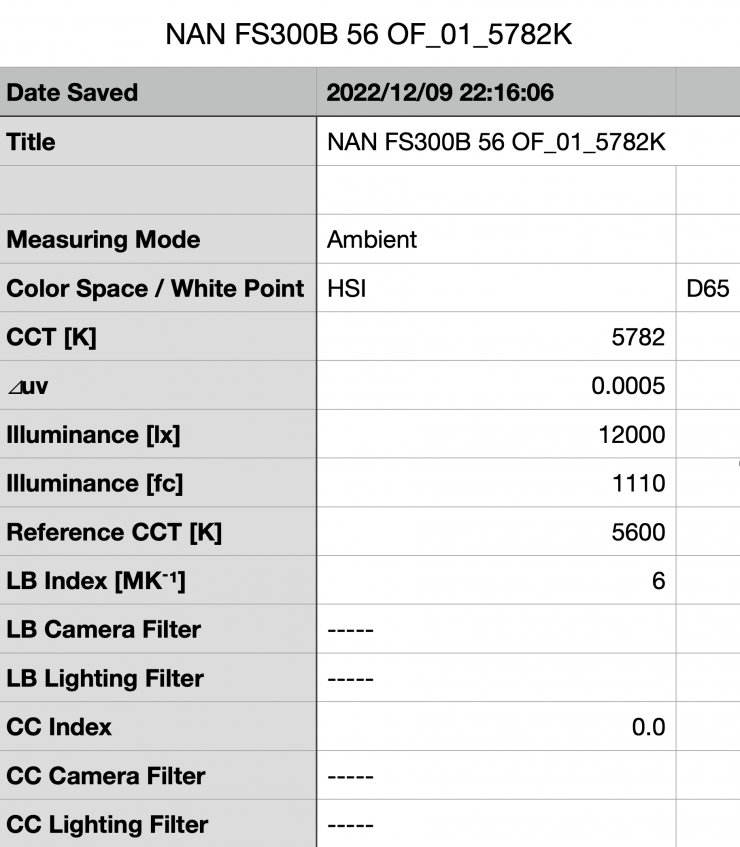
Above you can see the FS-300B recorded an output of 12,000 lx (1110 fc) when set at 5600K and used open face. Nanlite lists a figure of 11,130 lx, so the result I got was higher than the claimed figure.
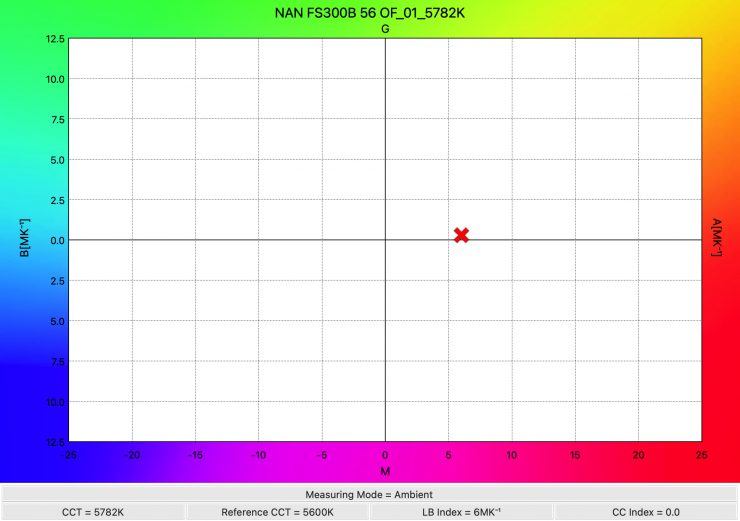
The light recorded a CCT reading of 5782K which was more than 250K off being correct.
3200K (open face)
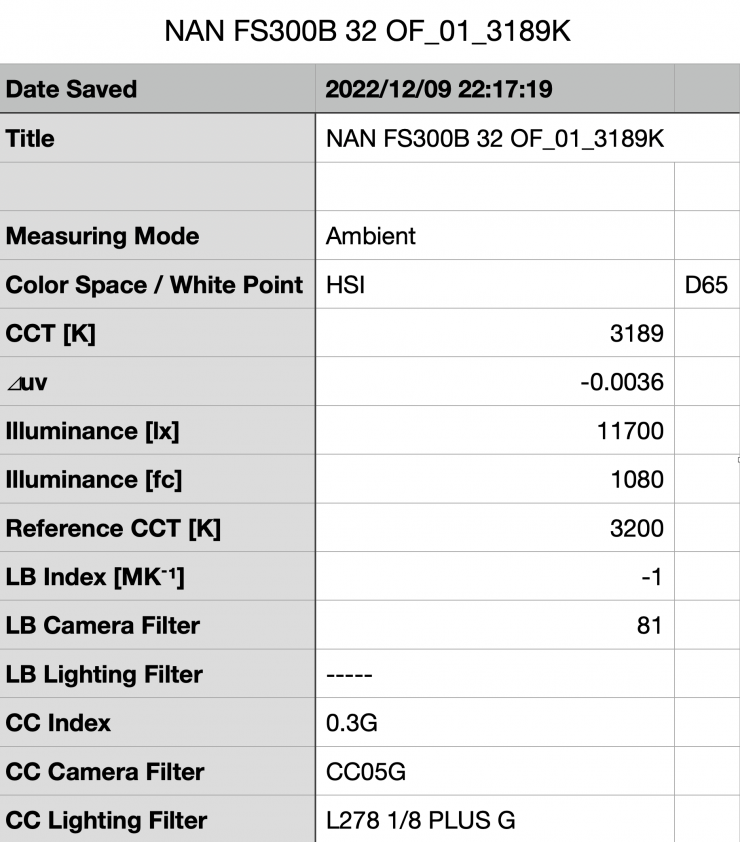
Above you can see the output when it was set at 3200K in the open face configuration was 11,700 lx (1080 fc), which was just 2.5% less than the 12,000 lx it produced at 5600K. Nanlite lists a figure of 11,150 lx, so the result I got was slightly higher than their claimed figure.
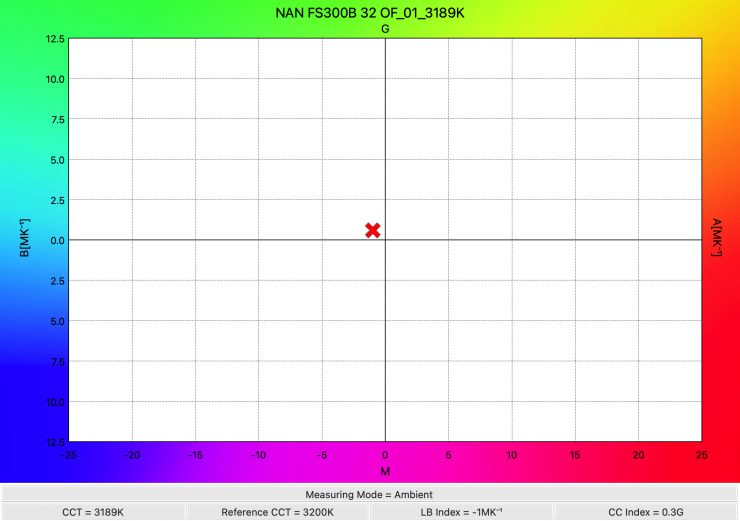
As far as CCT accuracy goes, it recorded an extremely accurate reading of 3189K.
So how does
Reflector
So, now let’s see how much output the light has when used with its 55° reflector.
5600K (Reflector 55°)
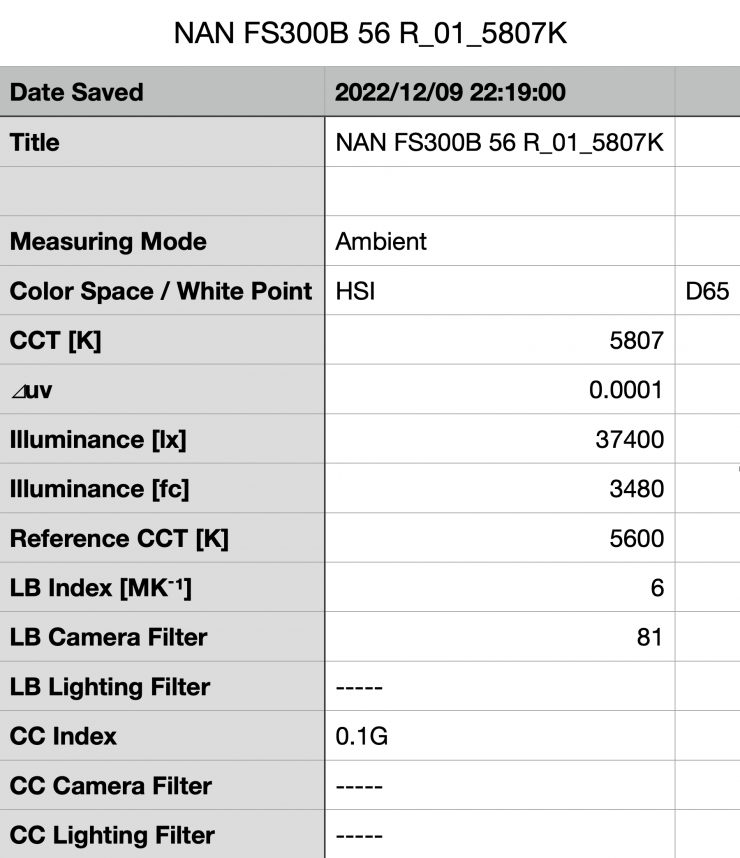
Above you can see the light’s output when it was set at 5600K with the reflector was 37,400 lx (3480 fc). This was 211.6% more than the 12,000 lx it produced at 5600K when used open face. It is important to note that this measurement was made from the edge of the reflector. This is a lot of output from a fixture that draws 350W.
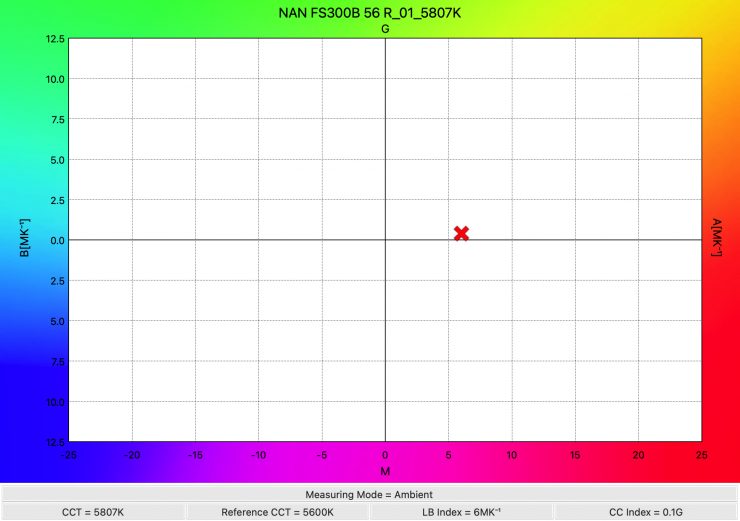
As far as CCT accuracy goes, it recorded a reading of 5807K. The CCT accuracy when using the reflector was fairly similar to when the light is used open face. It is nice to know that when using the reflector the light’s CCT won’t change by any huge noticeable difference.
3200K (Reflector 55°)
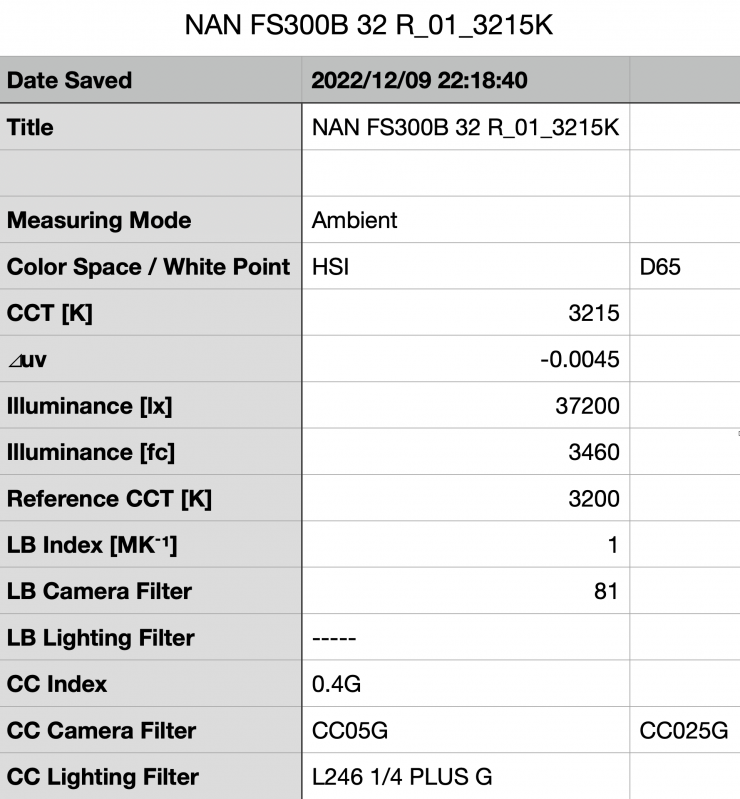
Above you can see the output when it was set at 3200K with the standard reflector was 37,200 lx (3460 fc), which was 0.53% less than what it output at 5600K using the reflector.
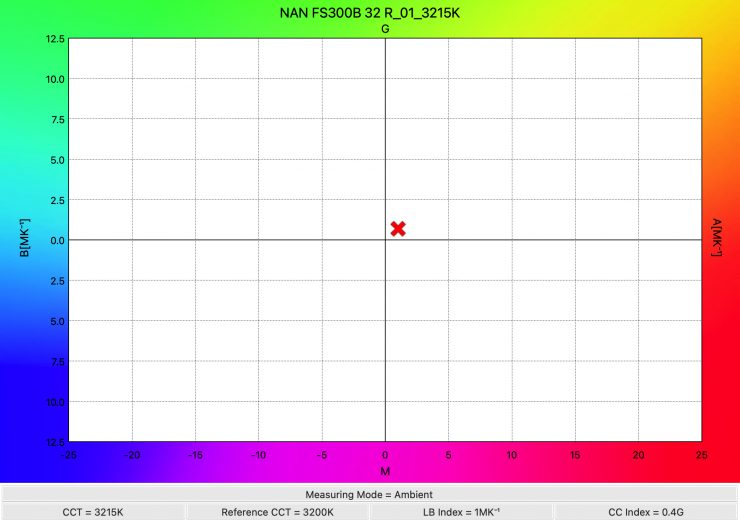
As far as CCT accuracy goes, it recorded an exceptionally good reading of 3215K which was a very good score.
Output Comparison against the Aputure LS 300x
| SETTING | OUTPUT | CCT READING | |
| FS-300B | 3200K | 37,200 lx | 3215K |
| FS-300B | 5600K | 37,400 lx | 5807K |
| LS 300x | 3200K | 15,100 lx | 3144K |
| LS 300x | 5500K | 17,500 lx | 5295K |
So as a comparison, how does this output compare to the Aputure LS 300x? Well, above you can see. Both lights draw 350W, but the Nanlite has considerably more output.
How does it perform at various CCT settings?
Summary of results (Reflector Max Output Mode)
| SETTING | OUTPUT | CCT READING |
| 2700K | 29,800 lx | 2774K |
| 3200K | 37,200 lx | 3215K |
| 4500K | 43,200 lx | 4630K |
| 5600K | 37,400 lx | 5807K |
| 6500K | 33,600 lx | 6492K |
These results show me that the light’s output varies by just 31% across the CCT range. The consistency of the output across the CCT range isn’t great, but there is a Constant Output mode you can use if you want similar output across all CCT settings. Please note that you won’t get nearly as much output in this mode.
The CCT accuracy across the range is very good apart from when the light is used at 5600K.
CCT consistency & linear output when dimming the light
Now, what you should always do when testing lights is to see if the CCT remains consistent when dimming the light. Just because you set a light at say 5600K, that doesn’t mean that the CCT will remain stable as you start dimming the fixture down. I also wanted to see how linear the dimming curve was.
I decided to do a series of tests at 100%/75%/50%/25%10% to see if the Kelvin color temperature being recorded changed. This was done at a distance of 1m using a Sekonic C-800. These tests were done at 5600K with the reflector and the light in its Maximum Output mode.
| CCT READING | OUTPUT | INTENSITY % |
| 5807K | 37,400 lx | 100 |
| 5802K | 27,900 lx | 75 |
| 5783K | 18,500 lx | 50 |
| 5780K | 9,330 lx | 25 |
| 5805K | 3,920 lx | 10 |
The Nanlite FS-300B maintains very good CCT consistency as you start dimming the fixture. My testing showed that the CCT varied by only 27K. These are excellent results.
As far as how linear the output is when you start dimming the light, at 50% output it had 50.5% less output than when used at 100%. At 25% it had 75% less output than when used at 100%. At 10% output, it had 89.5% less output than when used at 100%. This shows me that the light’s dimming curve is extremely linear. In fact, these are the best results I have ever seen from a light for this test.
Color Rendering
5600K (Reflector)
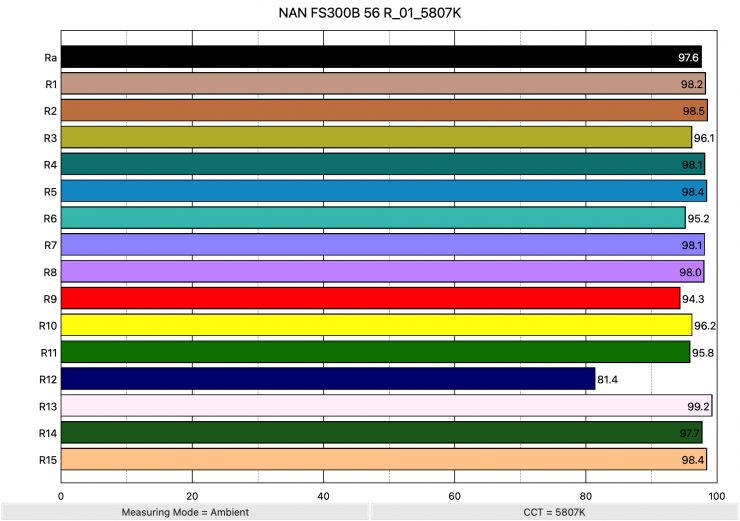
So now that we have seen how much output the Nanlite FS-300B produces, how does it perform when it comes to replicating accurate colors? Above you can see that when the light was set at 5600K using the standard reflector it recorded an average CRI (R1-R8) of 97.6 and an extended CRI (R1-R15) of 96.24. For replicating accurate skin tones it recorded for R9 94.3 (red), 99.2 for R13 (closest to caucasian skin tones), and 98.4 for R15 (closest to Asian skin tones). These are excellent results, although the light struggles to produce R12 (Blue) with a score of just 81.4.
| CRI | EXTENDED CRI | R9 | R13 | R15 | |
| FS-300B | 97.6 | 96.24 | 94.3 | 99.2 | 98.4 |
| Forza 720B | 98.6 | 97.04 | 92.7 | 99.3 | 97.2 |
As a color rendering accuracy comparison, the Nanlite Forza 720B recorded an average CRI (R1-R8) of 98.6 and an extended CRI (R1-R15) of 97.04. Yes, these are completely different lights, but I just wanted to show you how the color rendering accuracy compared when creating a 5600K source from two Bi-color spot lights. I also wanted to show you that even though the FS-300B is a budget fixture, the color rendering scores were every bit as good as Nanlite’S more expensive fixtures.
| CRI | EXTENDED CRI | R9 | R13 | R15 | |
| FS-300B | 97.6 | 96.24 | 94.3 | 99.2 | 98.4 |
| LS 300x | 97.0 | 95.97 | 96.8 | 97.7 | 96.0 |
As another comparison above you can see how it performs against the Aputure LS 300x.
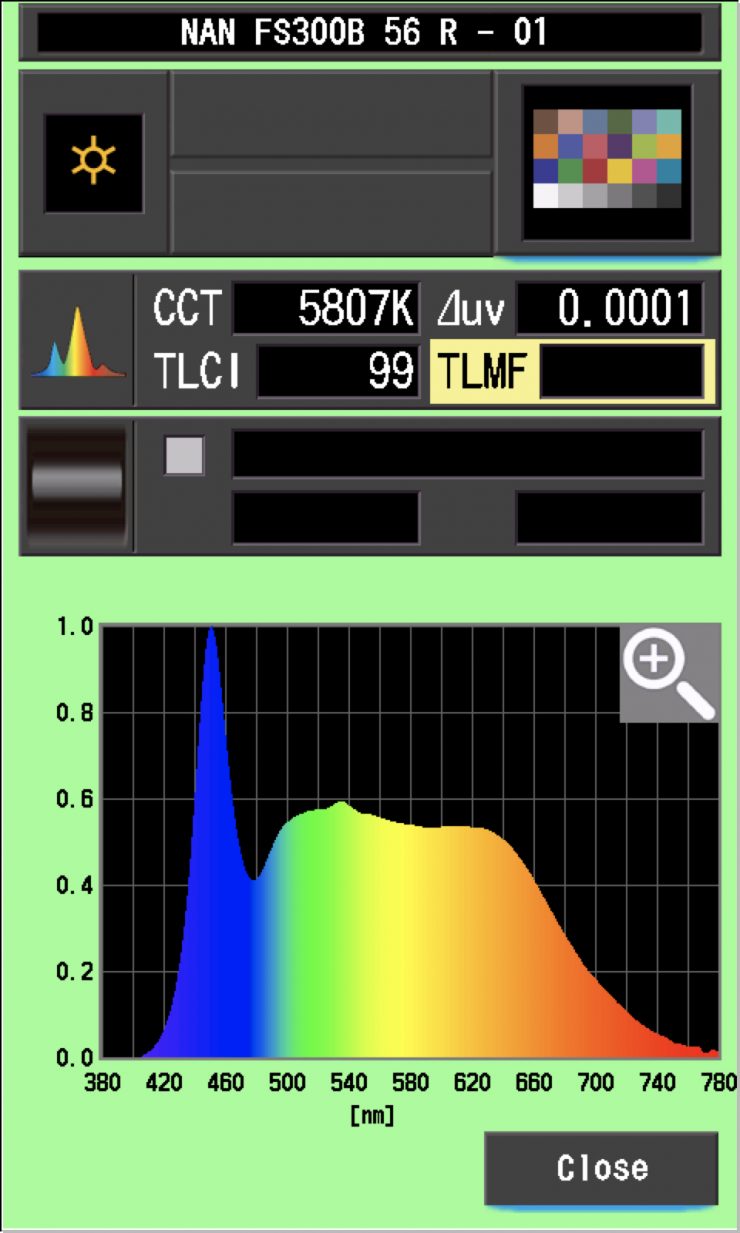
The FS-300B, when set at 5600K, recorded a TLCI score of 99.
3200K (Reflector)
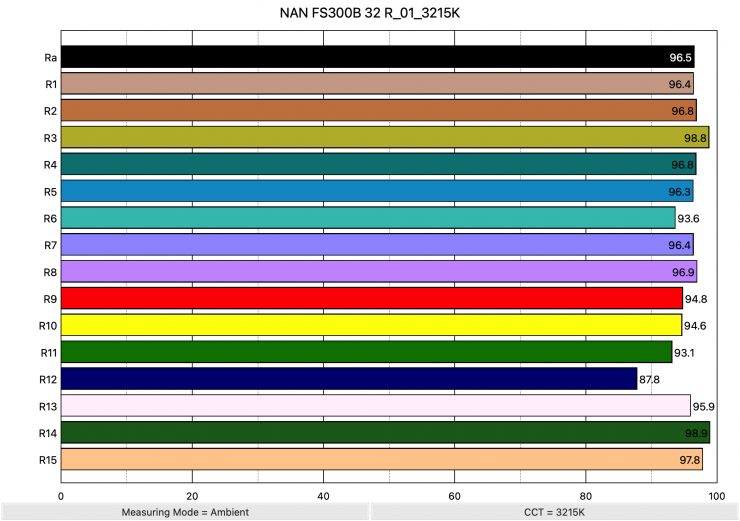
Above you can see the scores for when the light was used at 3200K. It recorded an average CRI (R1-R8) of 96.5 and an extended CRI (R1-R15) of 95.66. For replicating accurate skin tones it recorded 94.8 for R9 (red), 95.9 for R13 (closest to caucasian skin tones), and 97.8 for R15 (closest to Asian skin tones). These were good results, but not quite as good as when the light is used at 5600K.
| CRI | EXTENDED CRI | R9 | R13 | R15 | |
| FS-300B | 96.5 | 95.66 | 94.8 | 95.9 | 97.8 |
| Forza 720B | 96.5 | 96.22 | 97.4 | 95.6 | 97.4 |
As a color rendering accuracy comparison, the Nanlite Forza 720B recorded an average CRI (R1-R8) of 96.5 and an extended CRI (R1-R15) of 96.22. Just to reiterate again, these are different lights, but I just wanted to show you how the color rendering accuracy compared when creating a 3200K source from a more expensive Nanlite Bi-color fixture.
| CRI | EXTENDED CRI | R9 | R13 | R15 | |
| FS-300B | 96.5 | 95.66 | 94.8 | 95.9 | 97.8 |
| LS 300x | 97.0 | 96.08 | 93.5 | 96.4 | 97.9 |
As another comparison above you can see how it performs against the Aputure LS 300x.
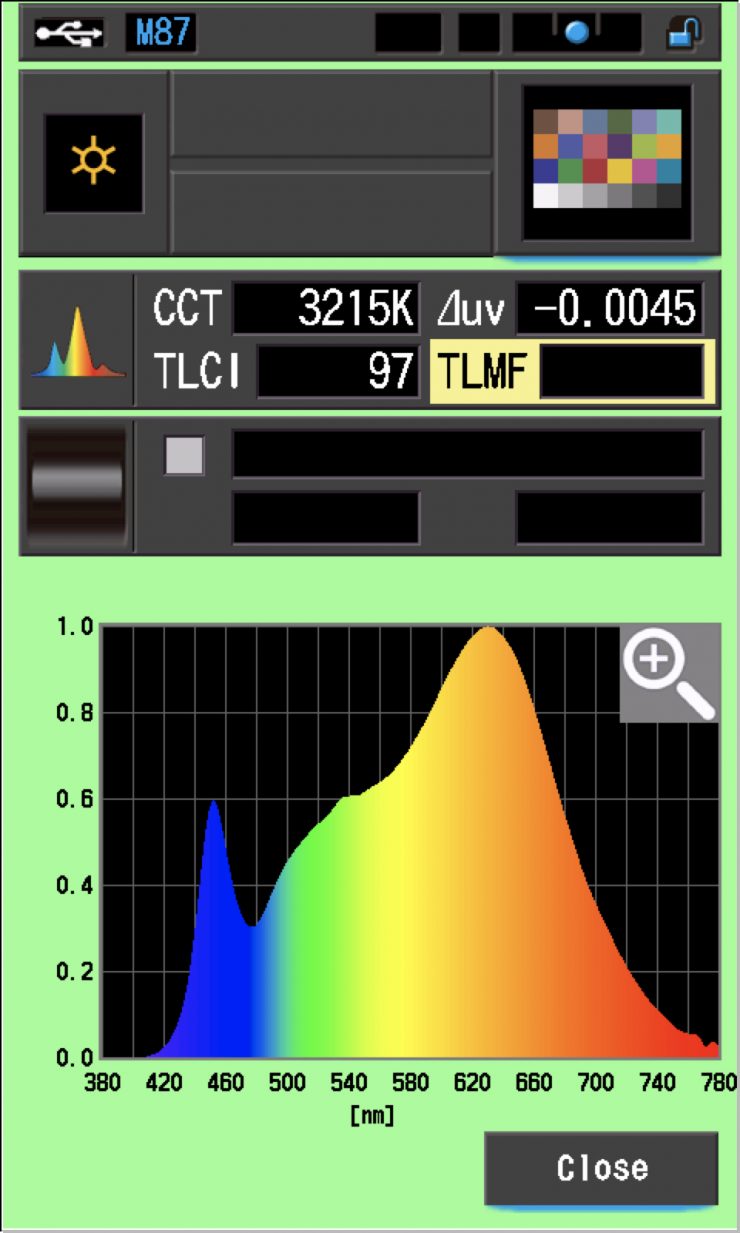
The light, when set at 3200K, recorded a TLCI score of 97.
CC Index & ⊿uv
The CC Index displays the CC correction value and whether any magenta or green need to be added or subtracted. 1 CC corresponds to 035 Kodak CC values or 1/8 Rosco filter values. Any reading less than +1.00 or -1.00 and you’re probably not going to need to make any kind of adjustment. The ⊿uv is the value to show how much this light is away from being an ideal light source (black body radiation = incandescent lamp). As with the CC Index you want this number to theoretically be zero. Kelvin is not a linear value, so we need to convert from Kelvin to MK-1 to compare the values of color temperature. To calculate from Kelvin to Mired is MK-1= 1*1000000/Kelvin. While this may sound confusing, it is the only way of measuring if the Kelvin shift is significant enough to warrant having to use a filter for correction. Below are the results for the Nanlite FS-300B:
Kelvin Vs MK-1
| Kelvin | Difference in K | MK-1 | Difference in MK-1 | |
| SET VALUE | 2700K | 0 | 370.37 | 0 |
| ACTUAL READING | 2770K | 70 | 361.07 | 9.3 MK-1 |
| SET VALUE | 3200K | 0 | 312.5 | 0 |
| ACTUAL READING | 3215K | 15 | 311.04 | 1.46 MK-1 |
| SET VALUE | 4500K | 0 | 222.22 | 0 |
| ACTUAL READING | 4630K | 130 | 215.98 | 6.24 MK-1 |
| SET VALUE | 5600K | 0 | 178.57 | 0 |
| ACTUAL READING | 5807K | 207 | 172.20 | 6.37 MK-1 |
| SET VALUE | 6500K | 0 | 153.84 | 0 |
| ACTUAL READING | 6492K | 8 | 154.03 | -0.19 MK-1 |
These figures might look confusing, but what it tells me is that the light is fairly CCT accurate at almost all temperatures. Any MK-1 score that is under -9/9 means you wouldn’t have to use any color correction gels. The MK-1 scores for this light were pretty good, apart from 5600K. Any MK-1 score that is under -6/6 is a very good result.
CC INDEX & ⊿uv
| CC INDEX | ⊿uv | |
| 2700K | 0.1G | -0.0011 |
| 3200K | 0.4G | -0.0045 |
| 4500K | 0.3G | -0.0037 |
| 5600K | 0.1G | 0.0001 |
| 6500K | 0 | 0.0029 |
Again, these were excellent results across the board, although the light does start to push a little green at 3200K and 4500K, although not by any large amount that would be of concern.
The ⊿uv scores weren’t too bad, with an almost perfect reading being recorded at 5600K.
TM-30
TM-30 is a relatively new color rendering standard that was developed to deal with the limitations of CRI. TM-30 looks at 99 individual colors. These 99 colors are categorized into seven groups: nature, skin color, textiles, paints, plastics, printed material, and color systems.
TM-30 scores go from 0 – 100. The higher the score, the more accurate a light is at producing colors. Any TM-30 Rf score in the ’90s is considered to be good. What is interesting and something that you need to be very aware of is that two separate light sources with the exact same CRI scores can render colors very differently. A light with a high CRI rating could have a low TM-30 score. Conversely, a light with a good TM-30 score could have a bad CRI score.
Now, there are two measurements associated with TM-30, Rf and Rg.
Rf (Color Fidelity)
Rg (Color Gamut)
With Rf value, ideally, you want a score in the 90’s.
With Rg value, a score below 100 indicates that the light source renders colors with less saturation than the reference source. So ideally you want this score to be above 100.
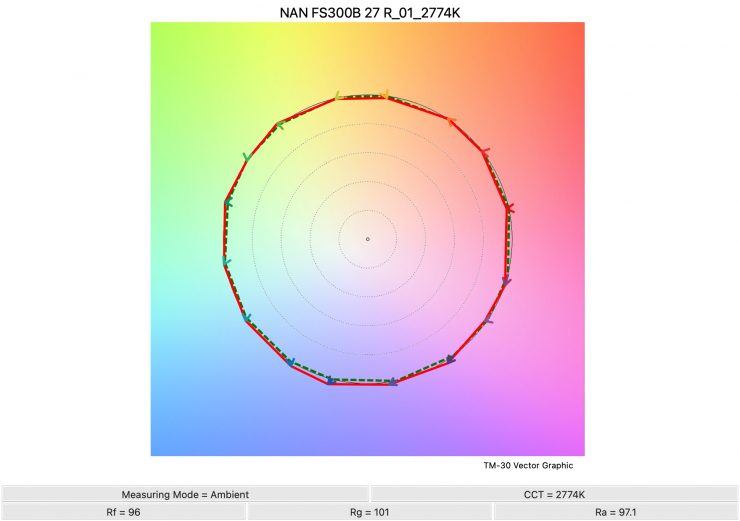

2700K 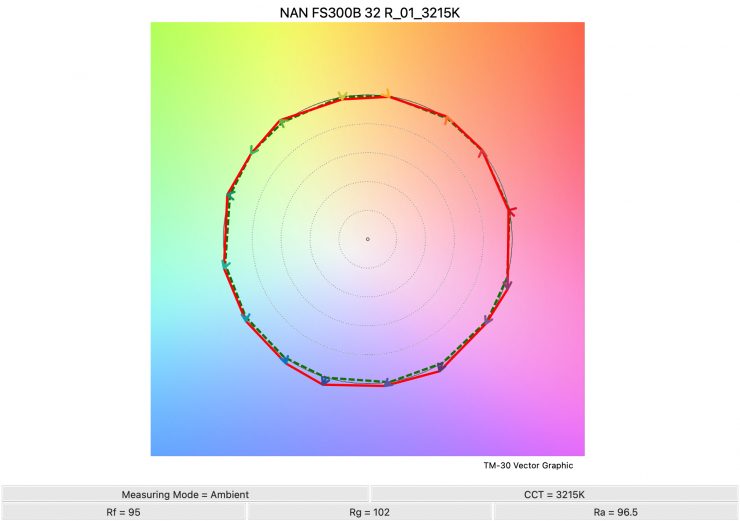
3200K 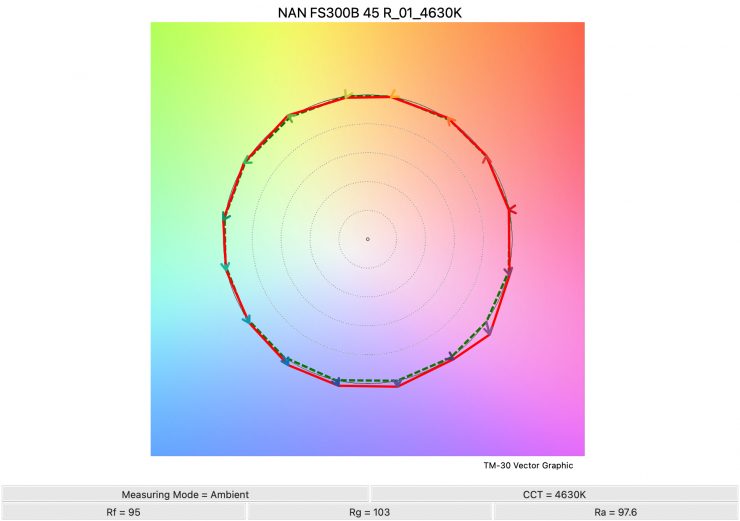
4500K 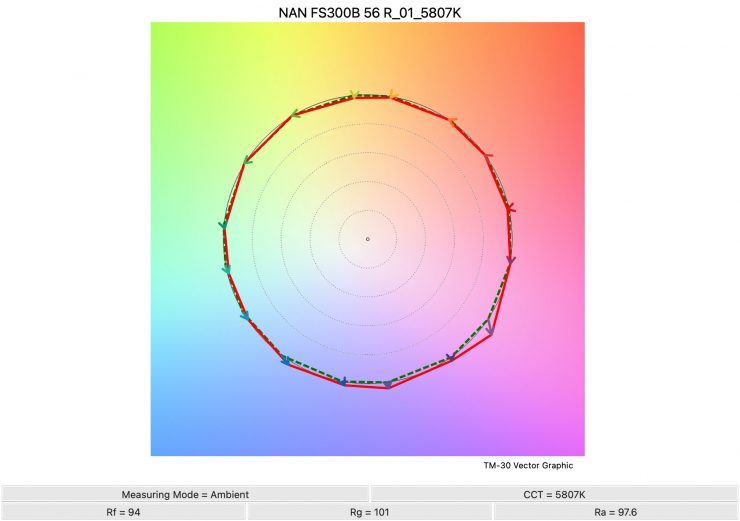
5600K 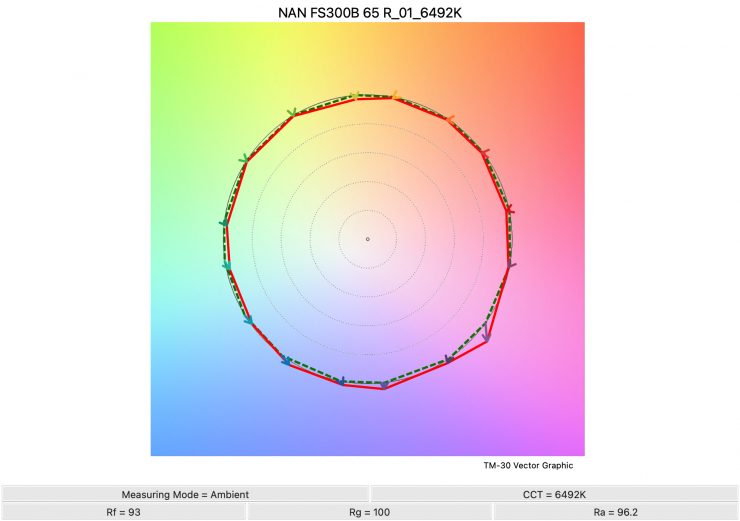
6500K
Above you can see the scores for the FS-300B at various Kelvin color temperatures. Below I have listed the figures as well.
Here are the results:
| Rf | Rg | |
| 2700K | 96 | 101 |
| 3200K | 95 | 102 |
| 4500K | 95 | 103 |
| 5600K | 94 | 101 |
| 6500K | 93 | 100 |
The TM-30 scores are all excellent and it shows me that the light is pretty consistent at replicating accurate colors with full saturation. The consistency of the scores was impressive.
SSI
SSI (Spectral Similarity Index) was developed by the Sci-Tech Council of the Academy. SSI gives me the ability to set any light as a standard, or use predefined standards (such as CIE D55), and then give other lights an SSI score based upon how well they will match standards such as CIE D55. This way I can measure spectral response and compare it directly against an ideal light source. This is actually a much better test than recording CRI scores.
3200K
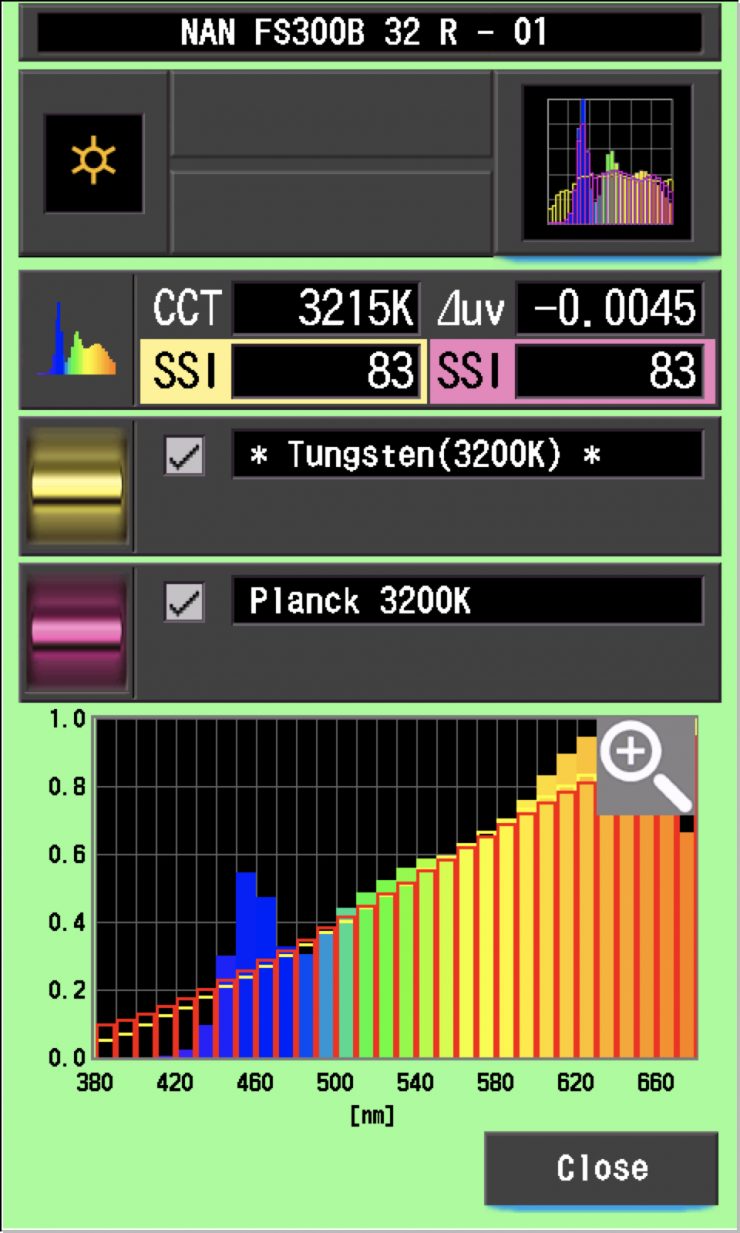
In this graph, the red bars indicate a perfect Planck 3200K source. The gold bars indicate a perfect 3200K Tungsten source. This lets us compare how close to a perfect 3200K lighting source the FS-300B is. Any SSI score in the high 70’s, low ’80s is very good for a 3200K LED light. The results for the FS-300B were very good when used at 3200K. As you can see, LED lights have a hard time replicating colors below about 450nm.
5600K
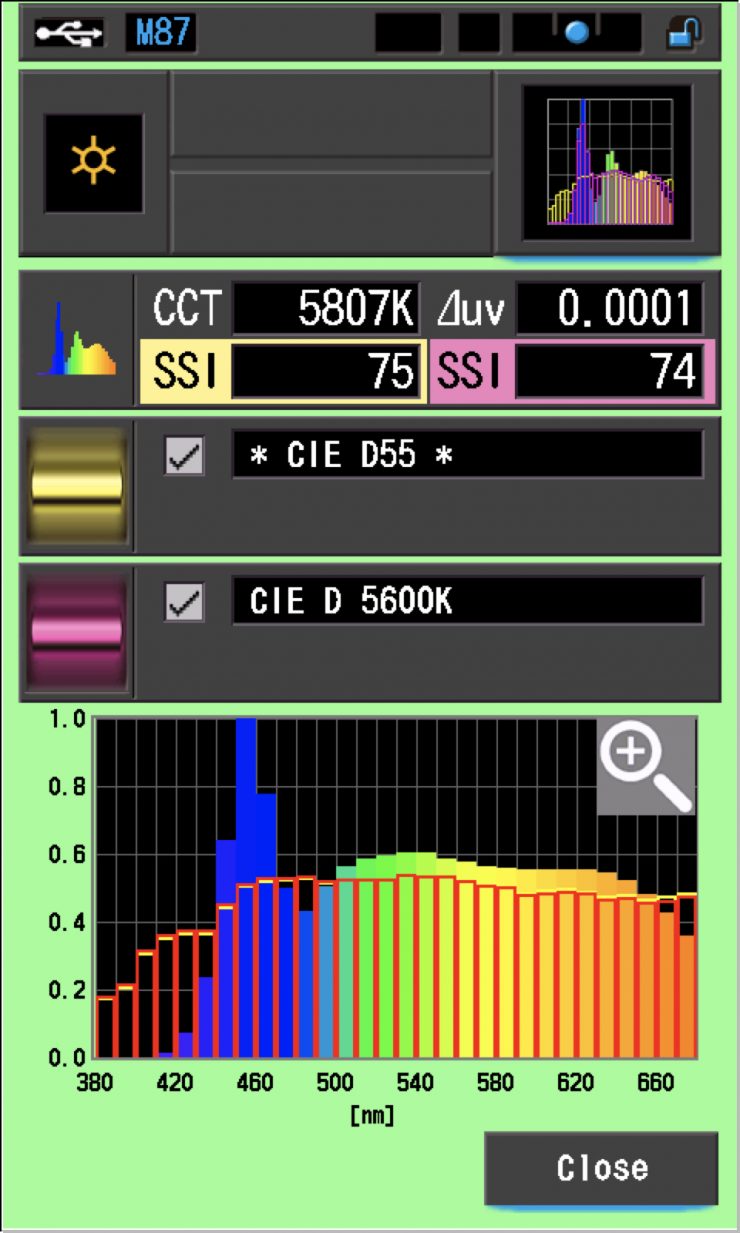
In the graph above the gold bars indicate a perfect CIE D55 source. The red bars indicate a perfect CIE D 5600K source. This lets us compare how close to a perfect 5600K lighting source the FS-300B is. A score in the low 70’s is typical for a 5600K LED source.
The main reason we want to record SSI scores is so we can see how well they match with other lights. As an example, I wanted to see how well the FS-300B matched the ARRI Orbiter and Nanlite Forza 720B. Below you can see the results.
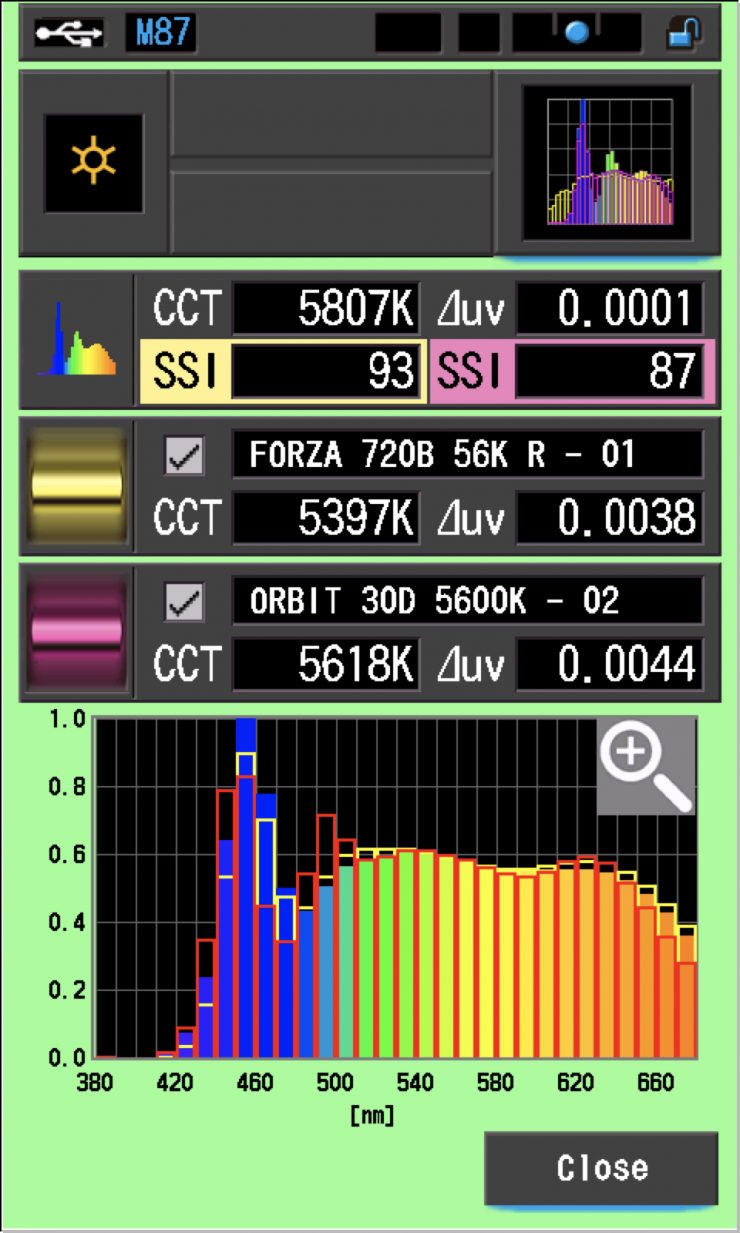
As you can see neither lights are not a perfect match to the Nanlite FS-300B, but they are reasonably close. You could fine-tune the lights to try and get them to match more closely. In saying that, a score in the high ’80s and low 90s is still reasonably good and the FS-300B would work well with both of these lights.
As another test, I thought I would compare the ARRI Orbiter and FS-300B against the Nanlite FS-60B at 3200K. Below you can see the results.
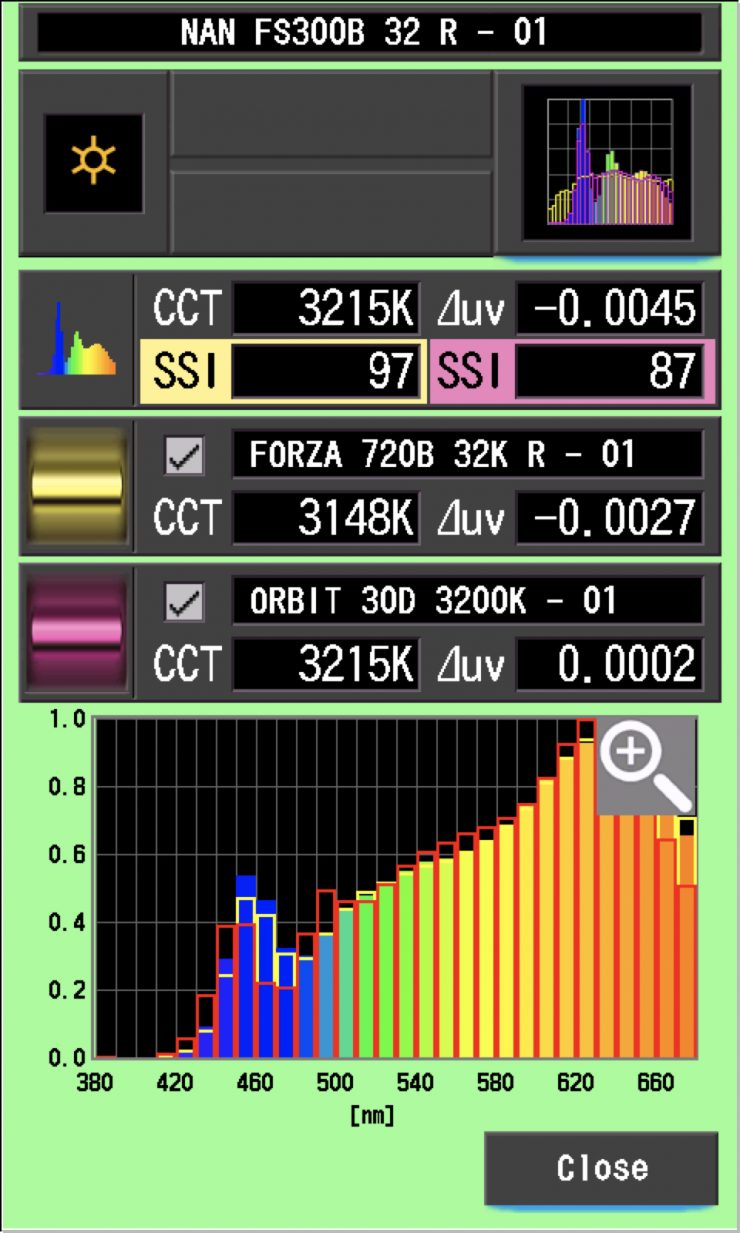
As you can see, the FS-300B is still a pretty close match to the Nanlite Forza 720B. Very few lights from different manufacturers are ever going to be an exact match, but ideally, in a lot of scenarios, you want to use lights that match as closely as possible.
SSI tests are a great way of telling you what lights you own or use will work well together.
Spectral Distribution
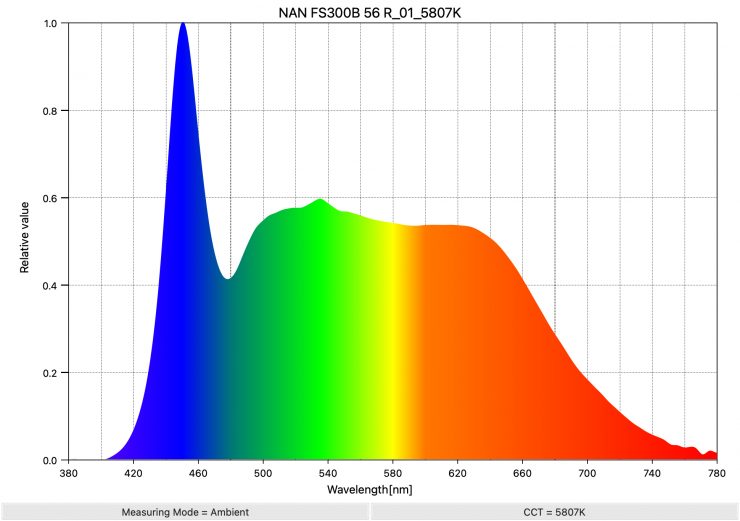
Above you can see the spectral distribution of the FS-300B when it is set at 5600K. The spectral distribution is ok, but it is not overly full.
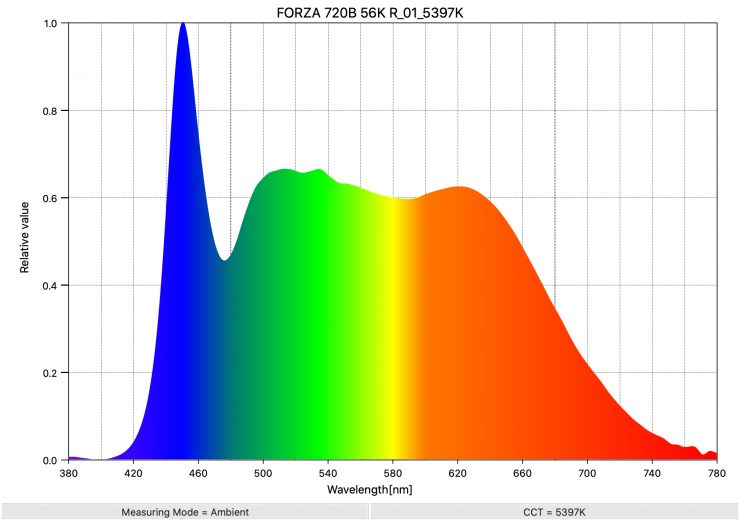
As a comparison, above you can see the spectral distribution of the Nanlite Forza 720B. It is considerably fuller and it doesn’t have as many spikes.
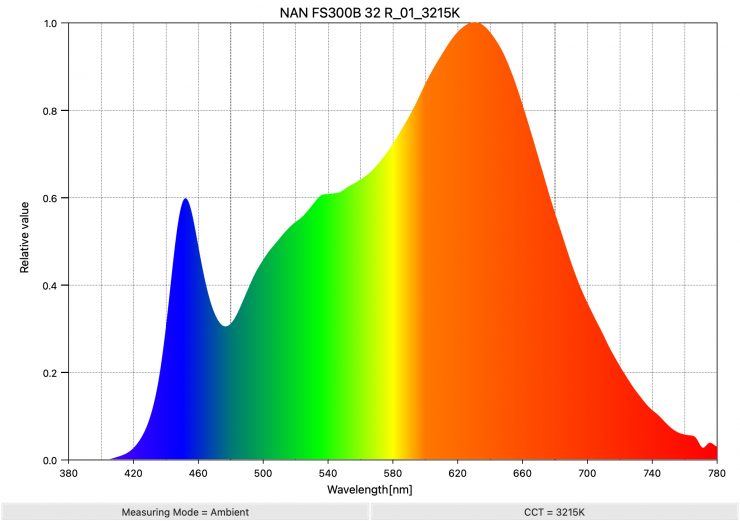
Above you can see the spectral distribution of the FS-300B when it is set at 3200K. The spectral distribution of the light is pretty decent for a 3200K source
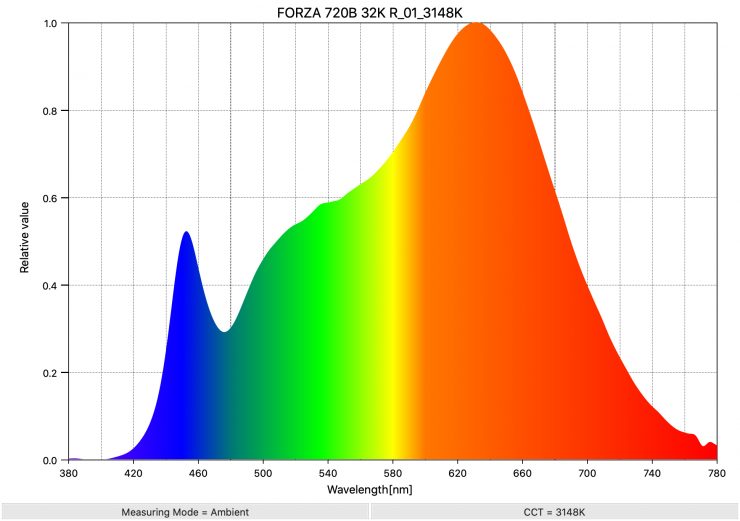
As a comparison, above you can see the spectral distribution of the Nanlite Forza 720B
Real-World Performance & Quality of Light
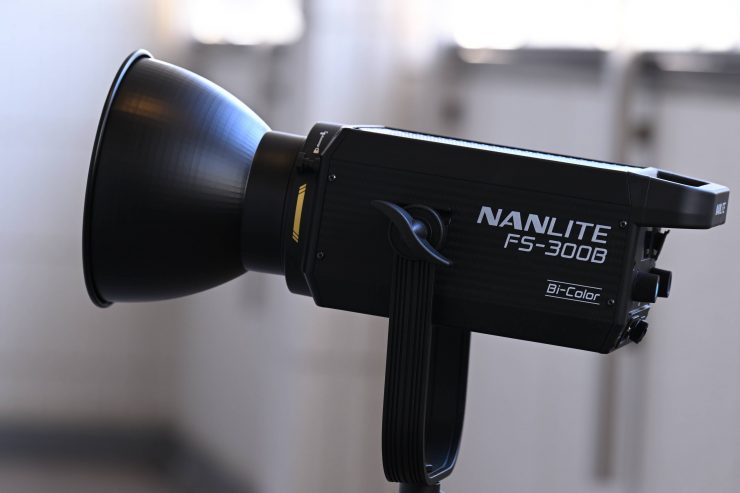
As I always say, photometric scores only tell you part of the story. So let’s how the FS-300B performs in the real world.
The photometric results can only give me scientific data and it is much more important for me to see how the light looks and performs.
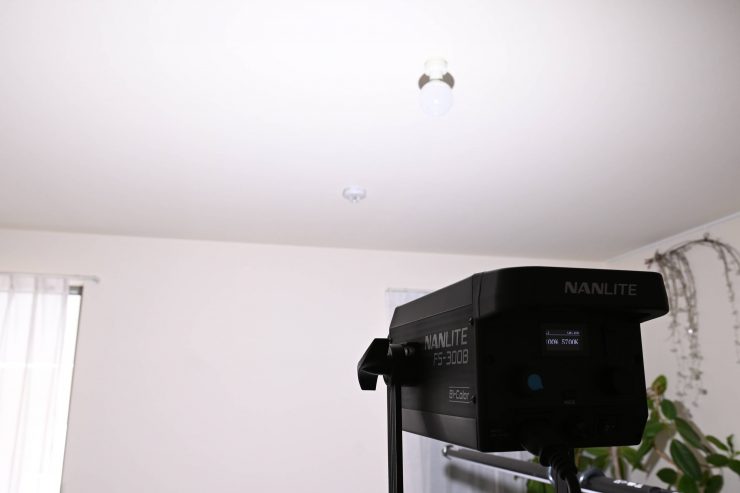

Open Face 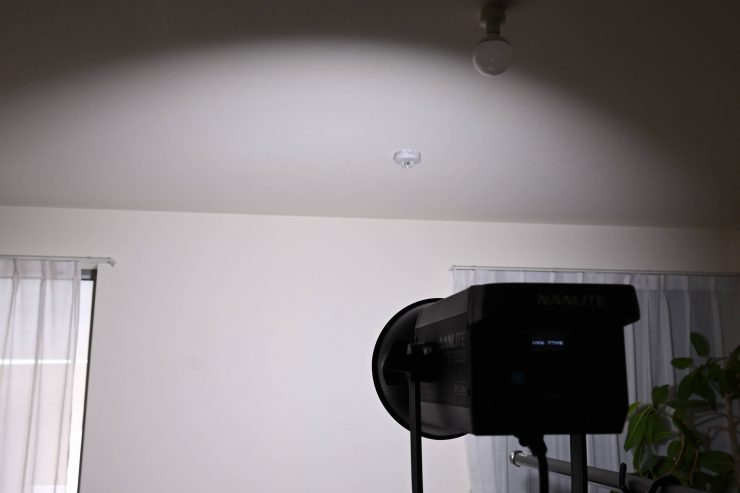
Reflector
The FS-300B has a decent amount of output and it is capable of producing great results most importantly it is easy to use and quick to set up. Above you can see what the light looks like at a distance of 3m /9.9′ when used open face and with its reflector.
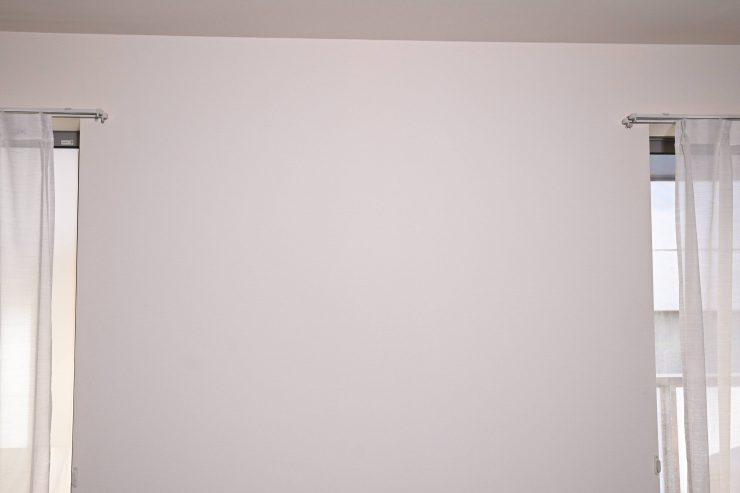
The nice aspect of the reflector is that it doesn’t have a hot spot.
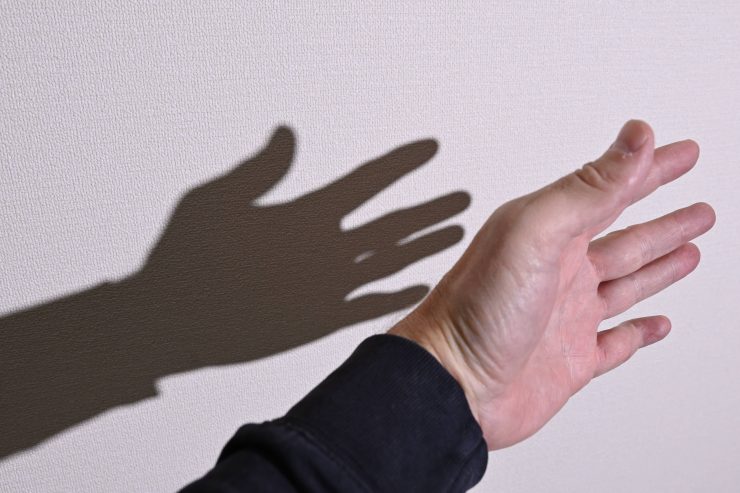

Open Face 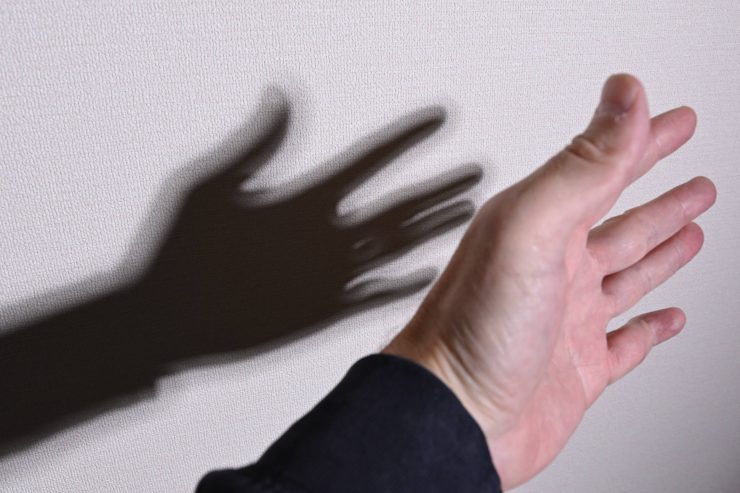
Reflector
Above you can see the difference in the type of shadows they create when used open face and with their reflector. When used open face you will get clean shadows. If you use the reflector then the shadows won’t have defined outlines.
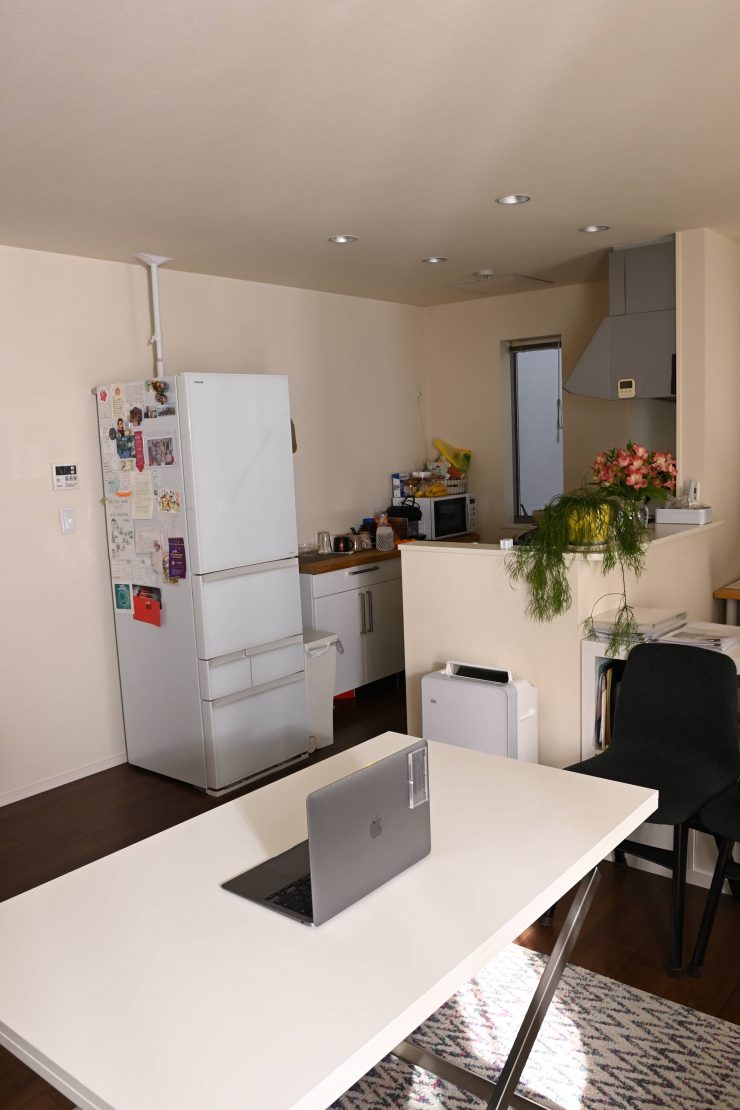

Reflector 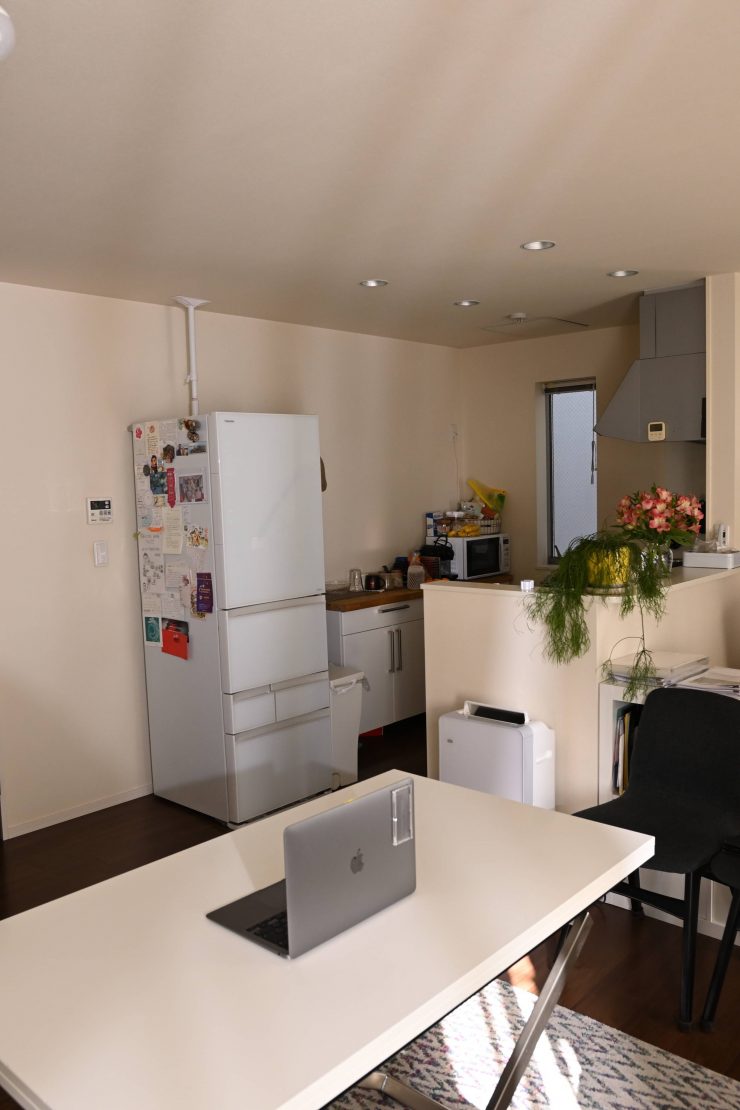
Open Face 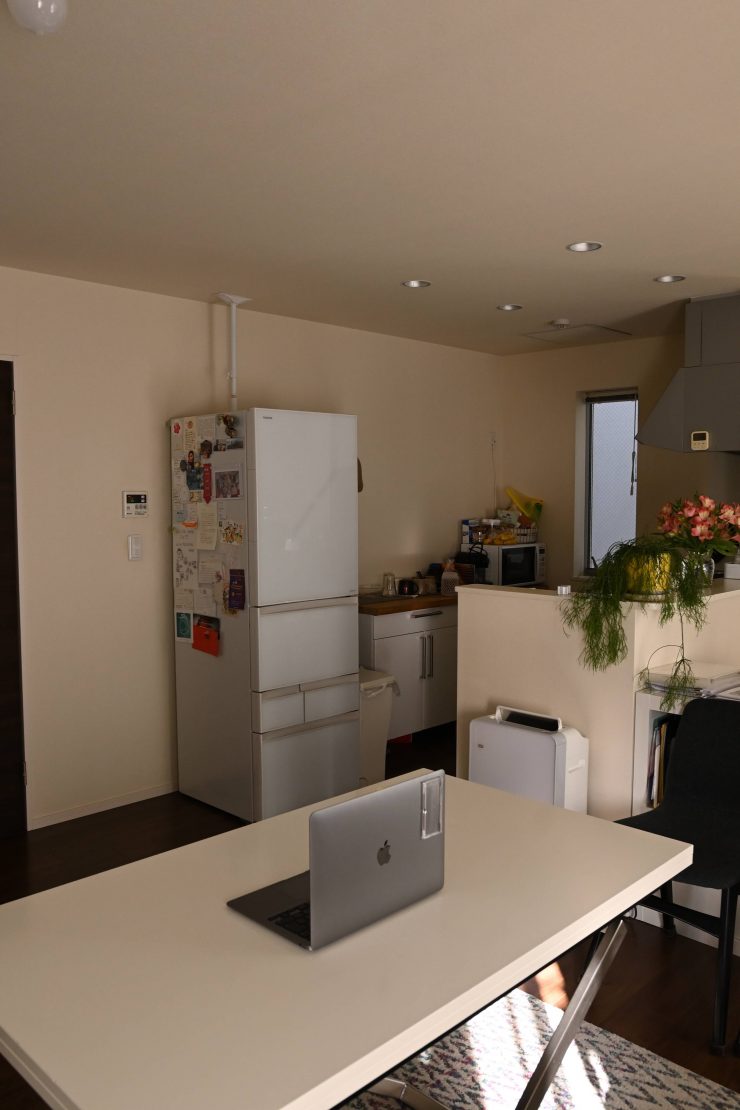
Light Off
The light packs a punch, and because it has a decent amount of output it allows it to be used for a lot of lighting applications. Above you can see how much output the light has when used open face and with its reflector.
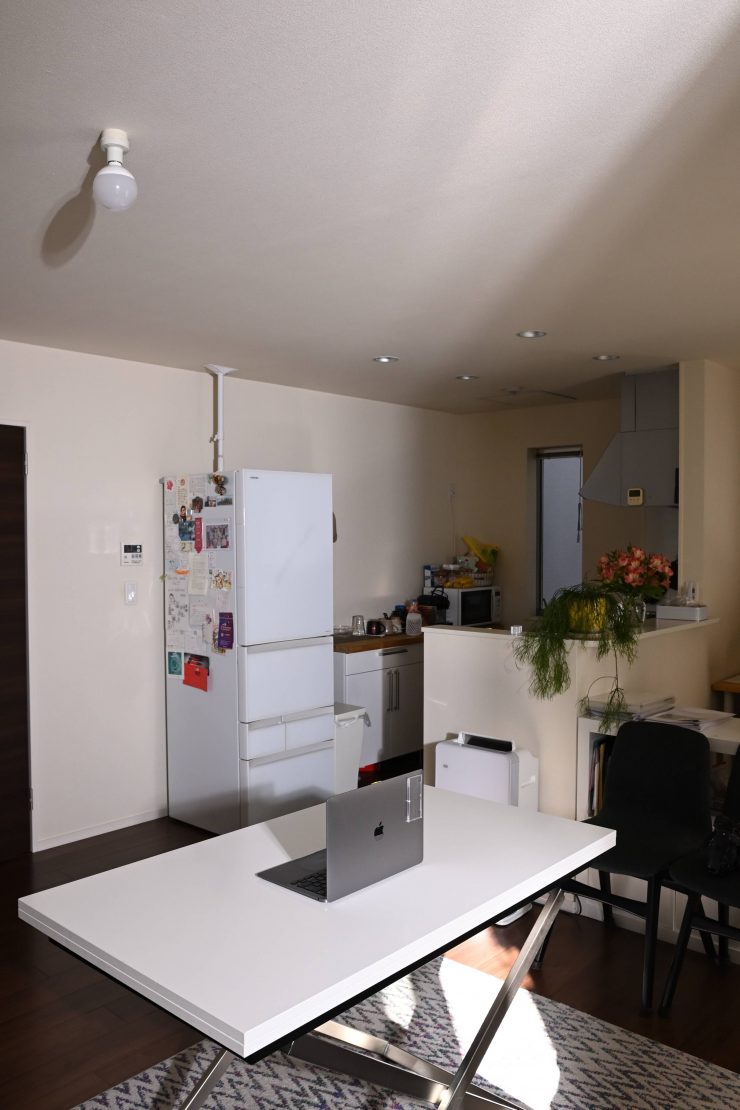

With Reflector 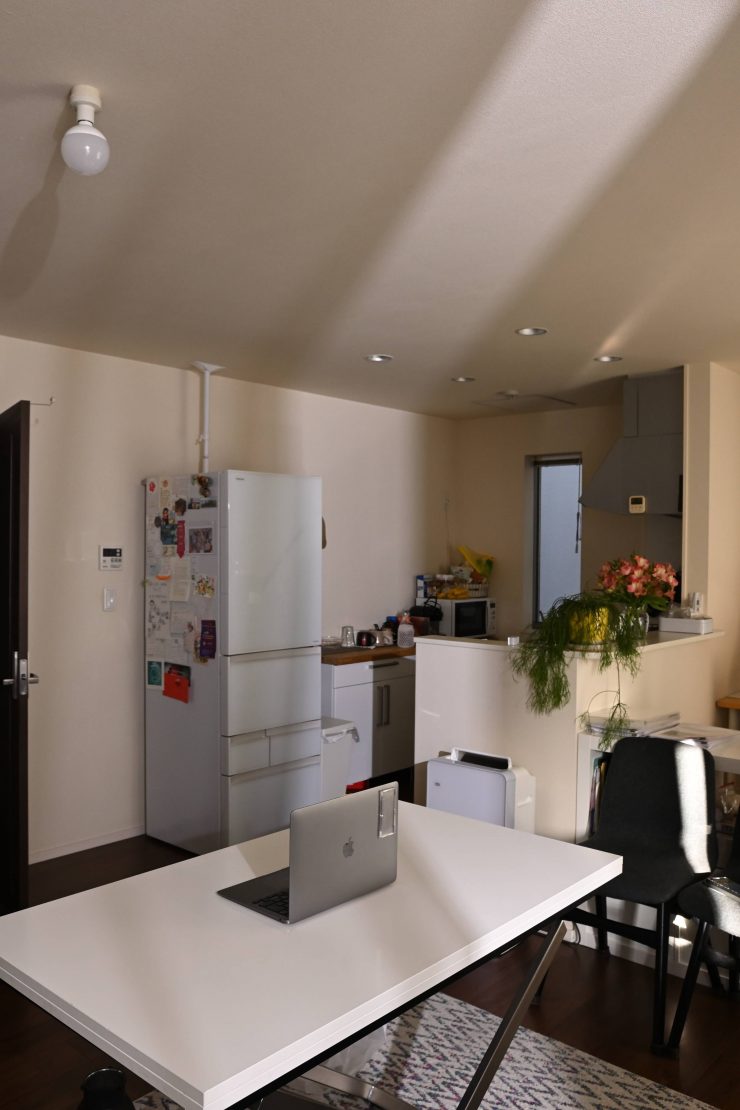
With eflector 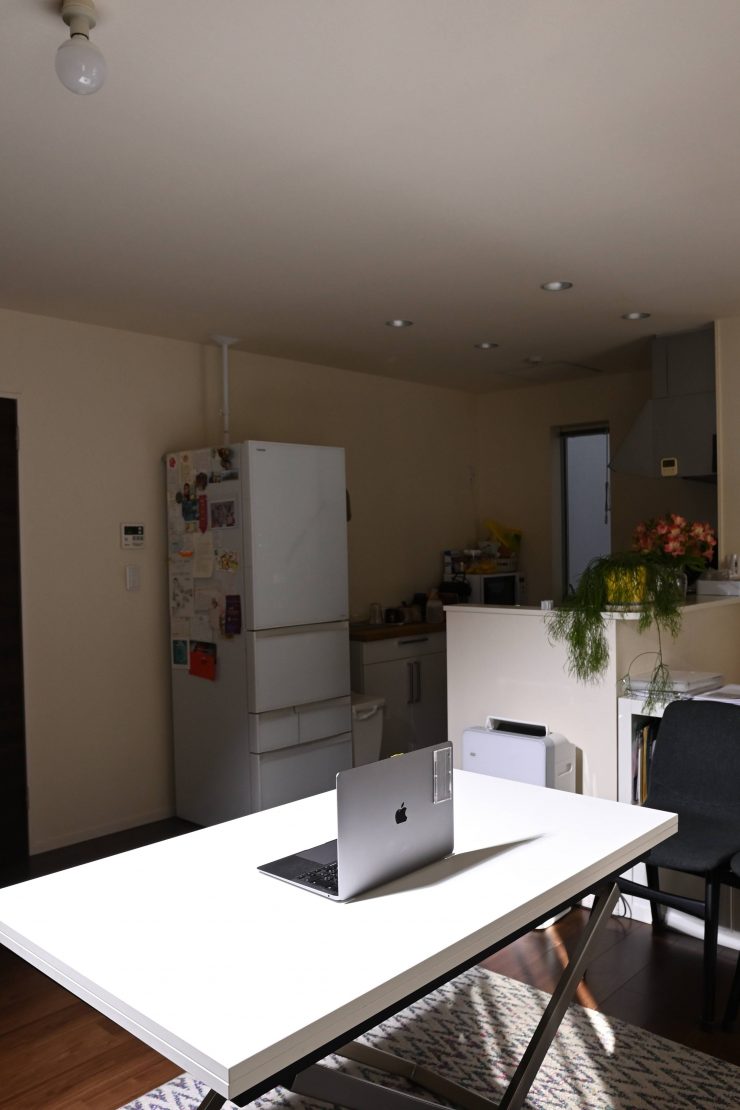
With Reflector 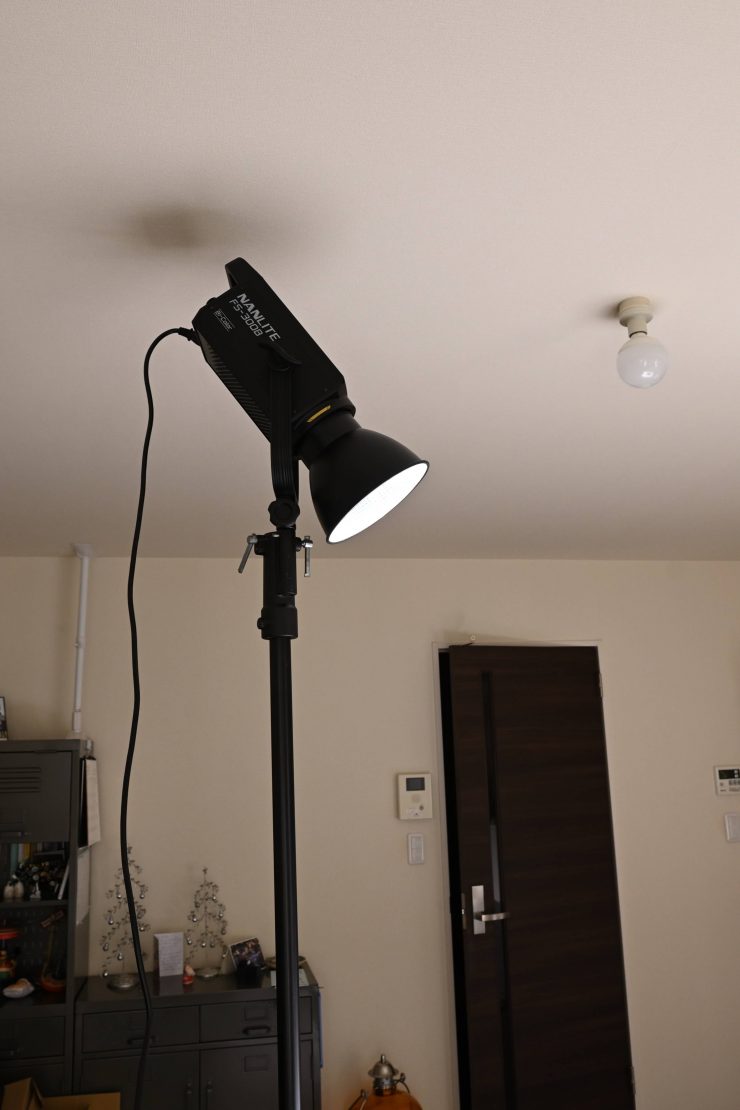
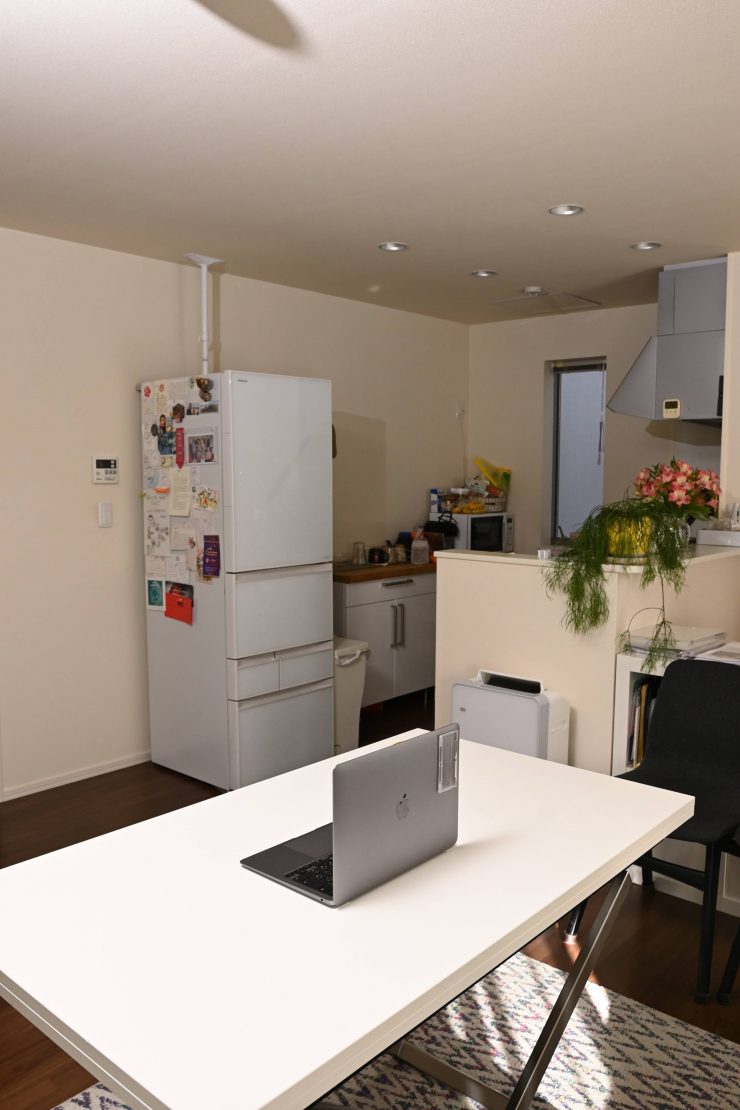
Open Face 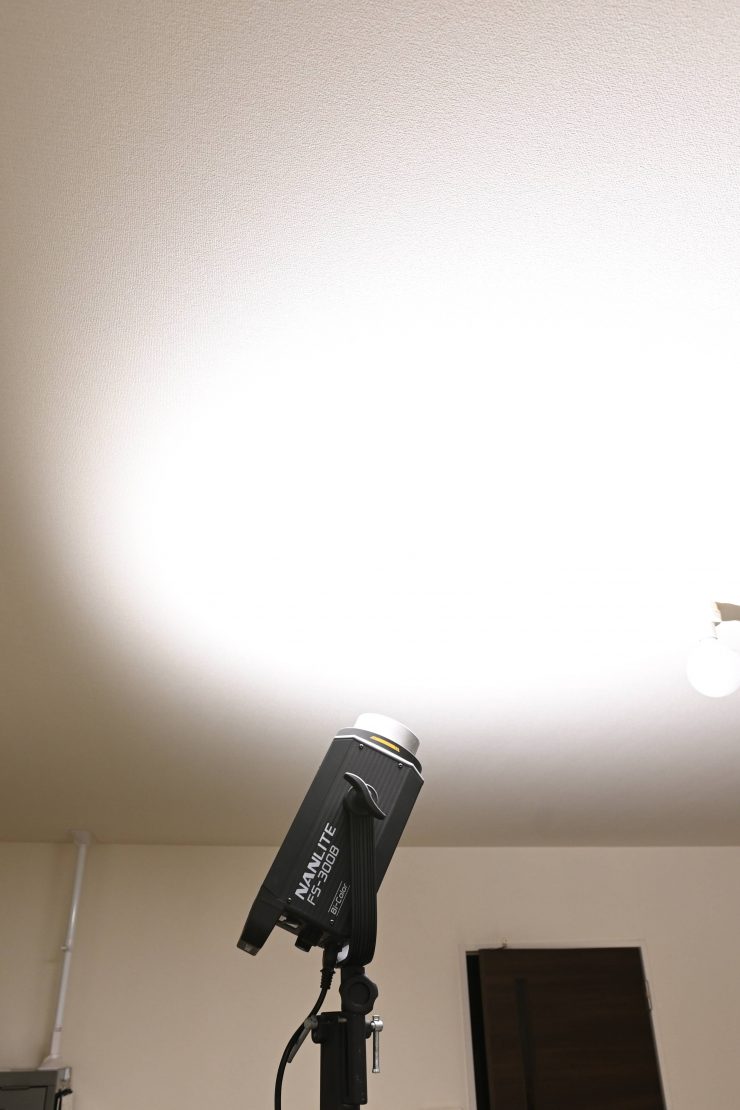
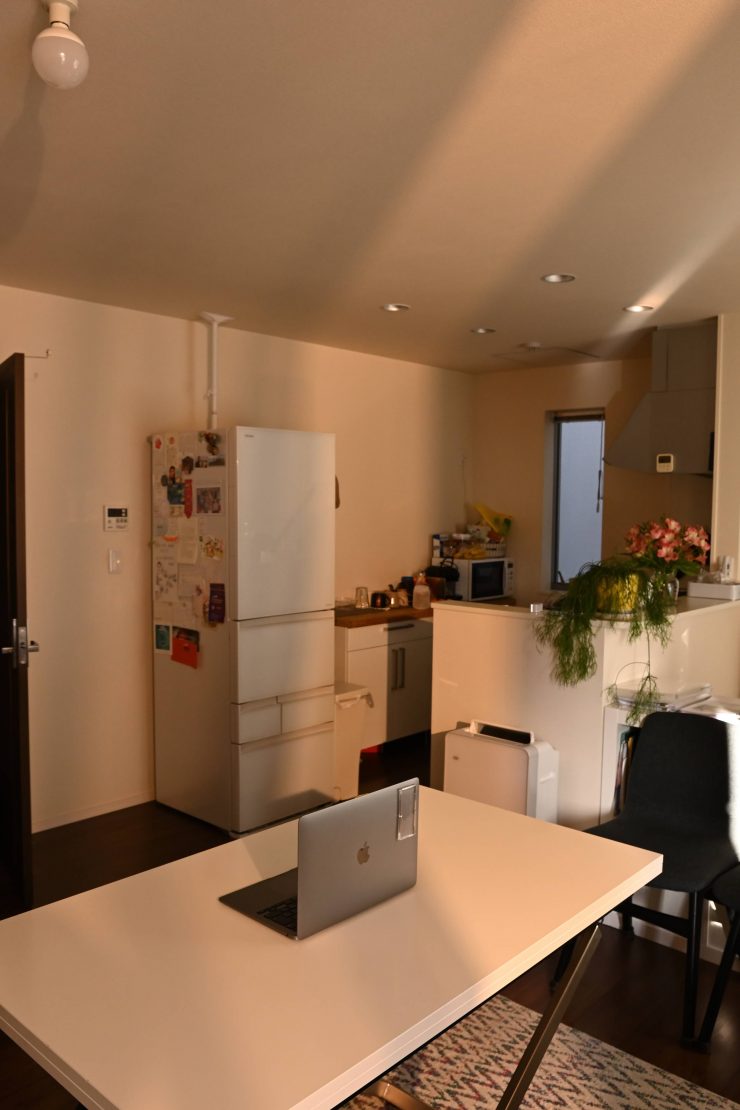
With Reflector
Above you can see some photos I took when placing the light outside and punching it through a sheer curtain into a room using the included reflector, as well as some shots with it pointing down at the table and being punched into the ceiling open face.
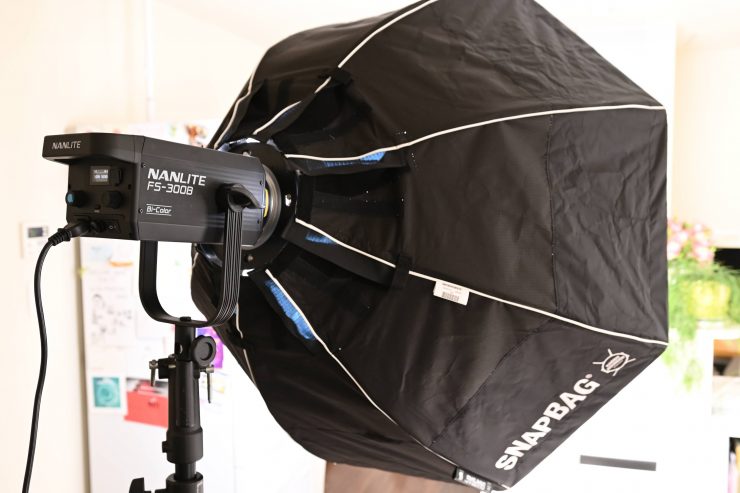
I also tried the light with a DoPChoice Octa 3 softbox. While the light won’t fill the soft box completely, it still does enough to provide good results.
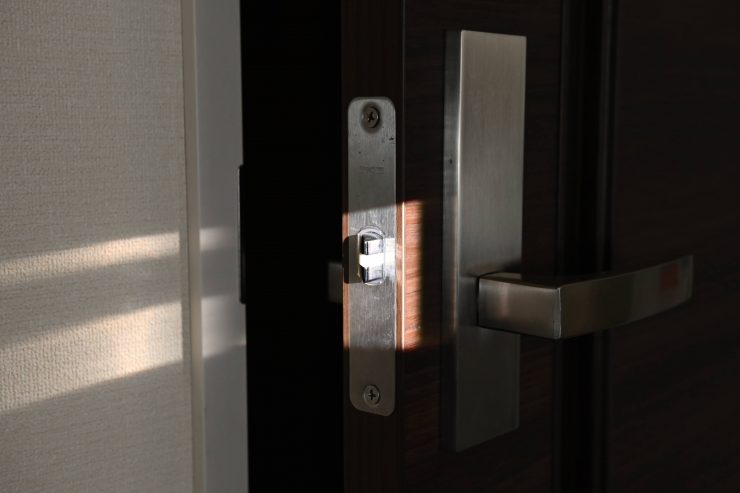
Above you can see the light used with the optional Projection Mount. The Projection mount works really well and it allows you to really concentrate light into a tiny area.
What you also clearly need to remember with point source lights such as this one is that even though they can generate a decent amount of output when not used with diffusion, once you add diffusion they lose a ton of output because that output is coming from a very small concentrated source.
The light also works well when used with bounce boards or the CRLS reflector system when you combine it with the Fresnel or Nanlite Projector.
Who is the FS-300B aimed at?
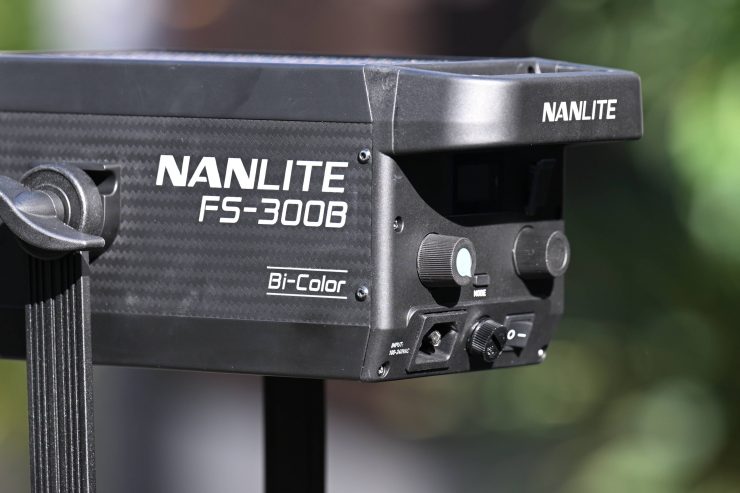
I think a lot of people who are in the market for a compact-sized bi-color light with a decent amount of output will be looking closely at this light, especially given its low price and the fact that there are quite a few affordable lighting modifiers that are available for it.
It is certainly priced to appeal to budget-conscious owner-operators who are looking for a small-sized jack-of-all-trades lighting solution. The versatility of the FS-300B allows it to be used as a hard light source, a soft source, a fresnel, a gobo, or just about anything else you want it to be with the correct modifier.
I personally think this is one of the better small-sized bi-color spot lights that are currently on the market. It has good color accuracy, and it has consistent output and performance across its wide CCT range.
Price & Availability
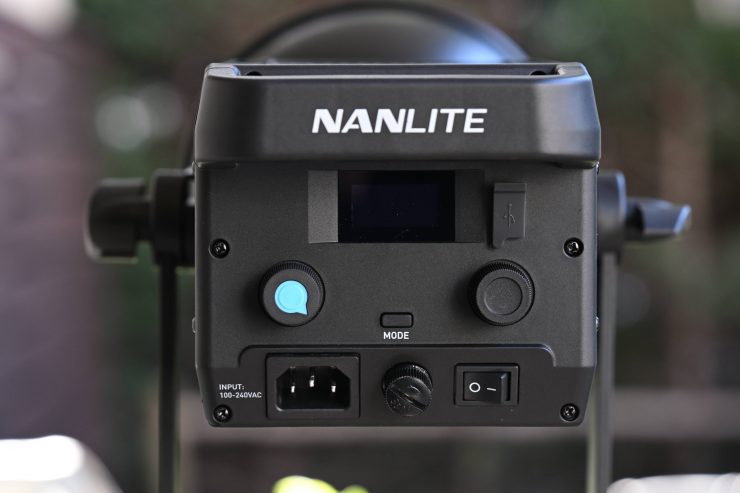
The Nanlite FS-300B retails for $299.25 USD and it is available to buy. This makes it a very appealing prospect for those shooters who are looking for an affordable, high-output light that offers good performance. At under $300 USD it represents incredibly good value for money.
Competition
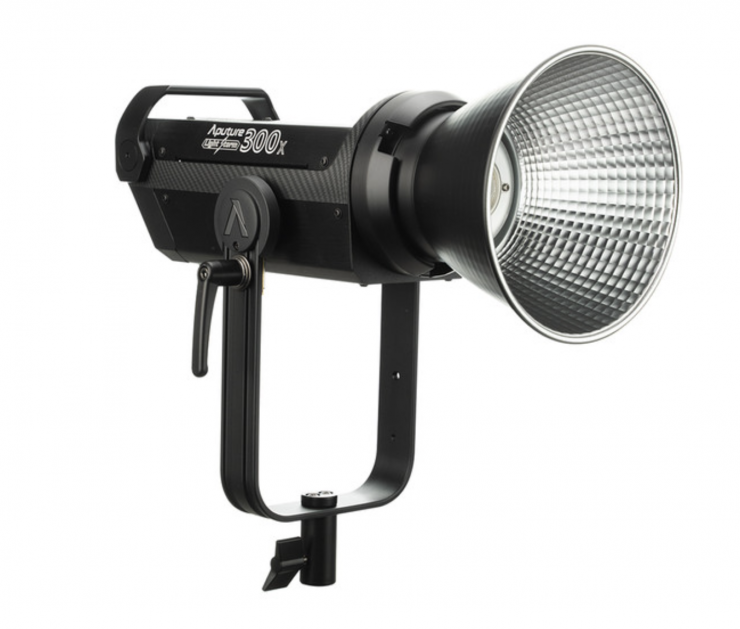
Below you can see some other similar power draw Bi-color spotlights that could be considered competition:
- Aputure Light Storm LS300X LED $999 USD
- SmallRig RC 350B COB Bi-Color LED Video Light $899 USD
- SWIT S-2330 Bi-Color Studio LED Focusing Spot Light (300W) $1,550 USD
- GVM SD300D Bi-Color LED Video Spotlight $379 USD*
*Currently on sale at B&H as of the 12th December 2022
What do you get?
- Nanlite FS-300B LED Bi-Color Monolight
- Reflector
- 14.8′ Power Cord
- COB Protective Cap
- Limited 2-Year Warranty, Extends to 3-Year with Online Registration
Optional Extras
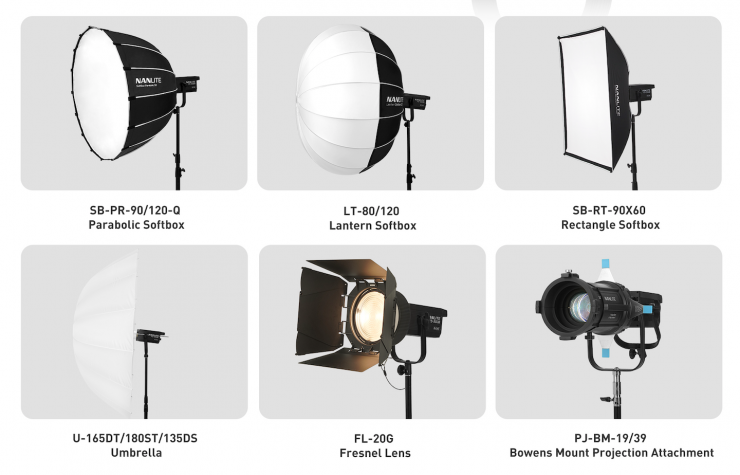
As it utilizes a Bowens mount you can use a wide array of affordable lighting modifiers. Nanlite also makes quite a few of its own accessories for the light.
Conclusion
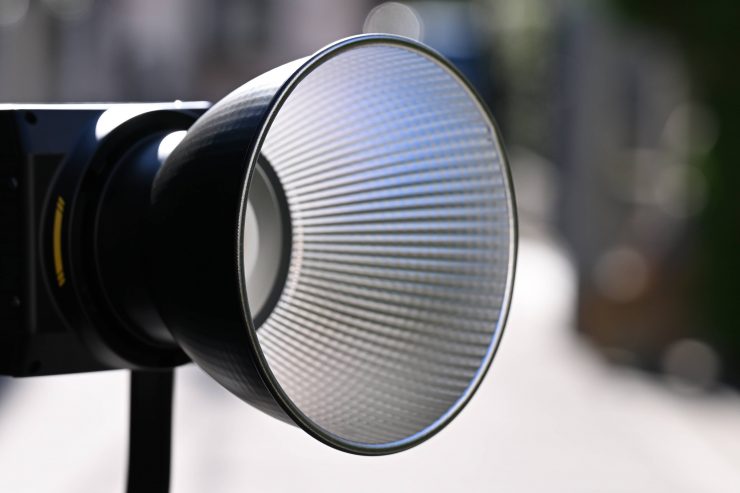
The Nanlite FS-300B is a solid offering. It is color-accurate, has a good amount of output, and most importantly is compact and easy to use. Its versatility makes it a fixture you can use for so many different applications.
The output, color accuracy, and small size make this light a compelling option in this space.
Having the ability to use the FS-300B with a wide array of lighting modifiers gives the light a lot of versatility.
The interface and operating system could be better, and so could the app. These are two areas I would like to see improved. The build quality is also quite average, but for a lot of people who are looking at a light at this price, I think they will find it acceptable.
The fan noise could be a concern for some people, especially if you need to use the light in a quiet room close to where audio is being recorded. In saying that, it isn’t overly loud, and again, for a light at this price point I think people will find the fan noise acceptable.
The small size and decent output make it a great option for anyone who is traveling. A couple of these lights with a few of the modifiers and you could have a small, compact lighting kit that could get you out of trouble. What you clearly have to remember is that you can’t remotely power this light via batteries and that somewhat negates its use for certain applications.
Nanlite has certainly stepped things up over the last year or so and the quality of its fixtures has improved a lot. The FS-300B is a solid fixture and it does a lot of things really well, especially for the price. No, isn’t perfect, but it is a meat-and-potatoes fixture that will get the job done without emptying your wallet.
Specifications
